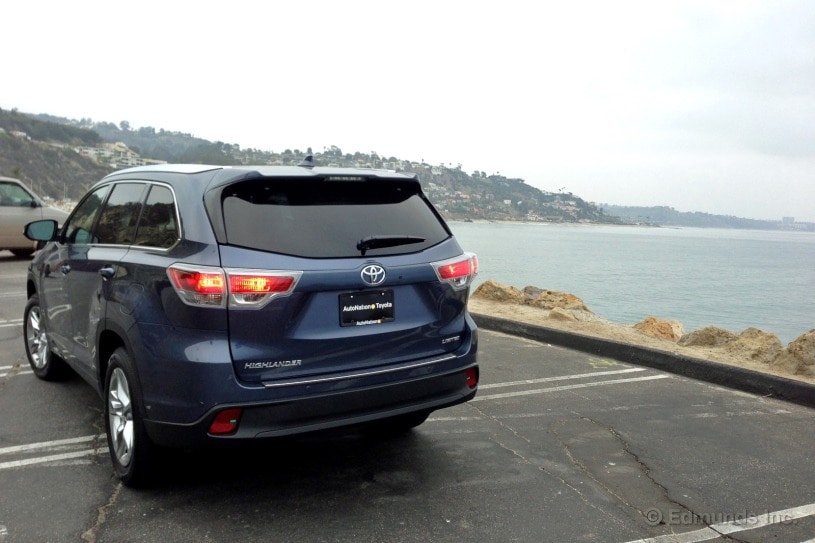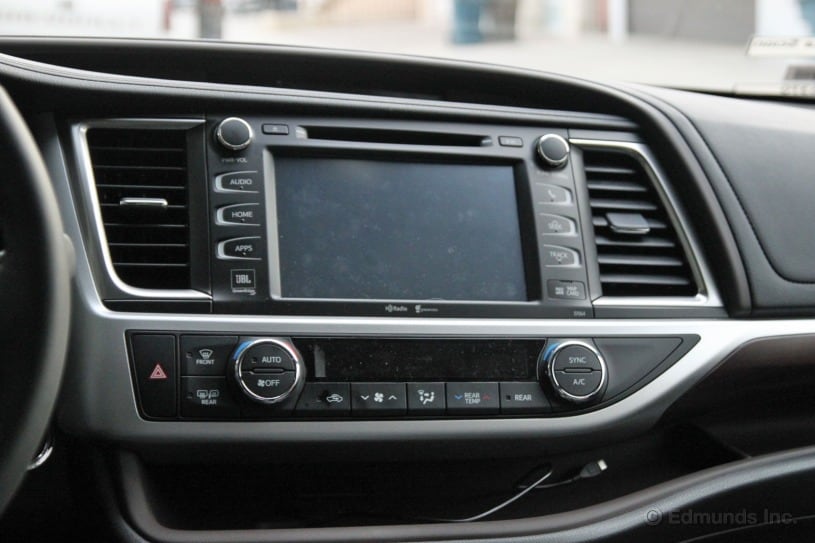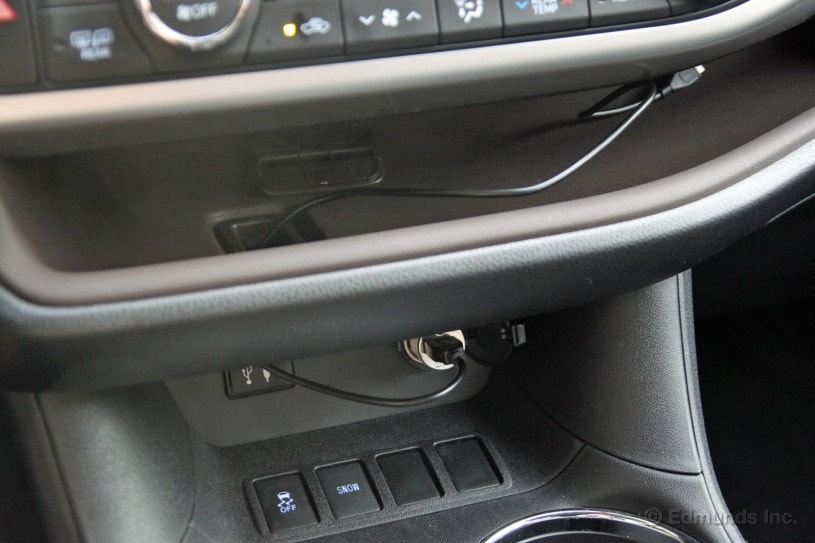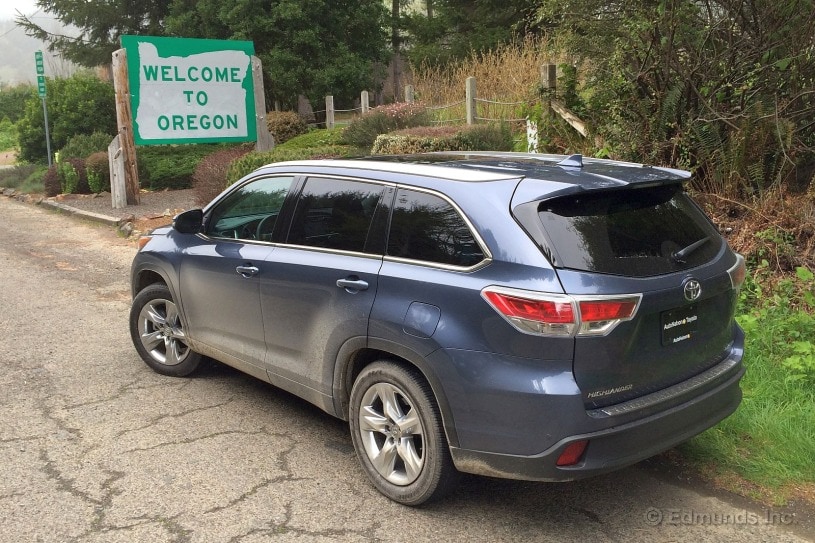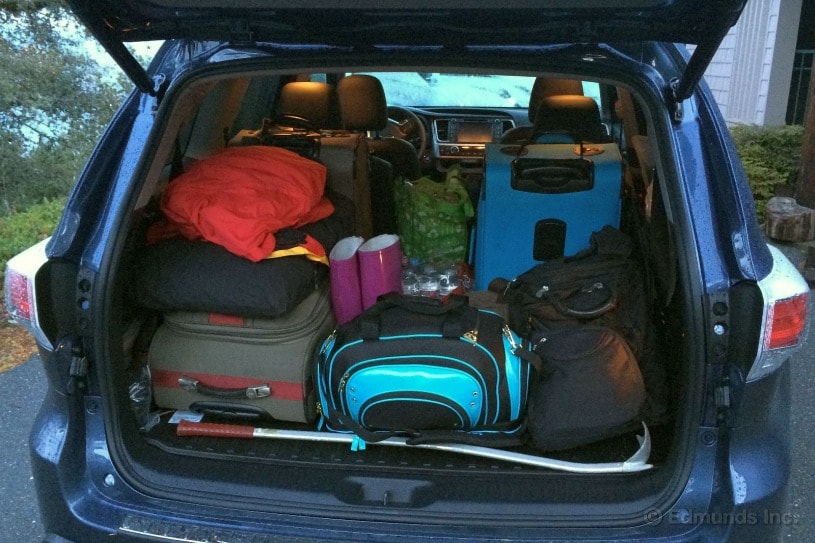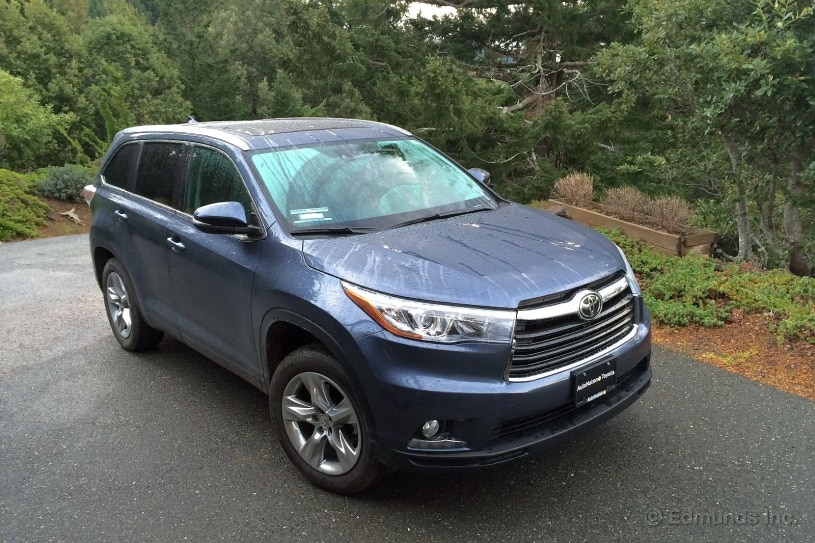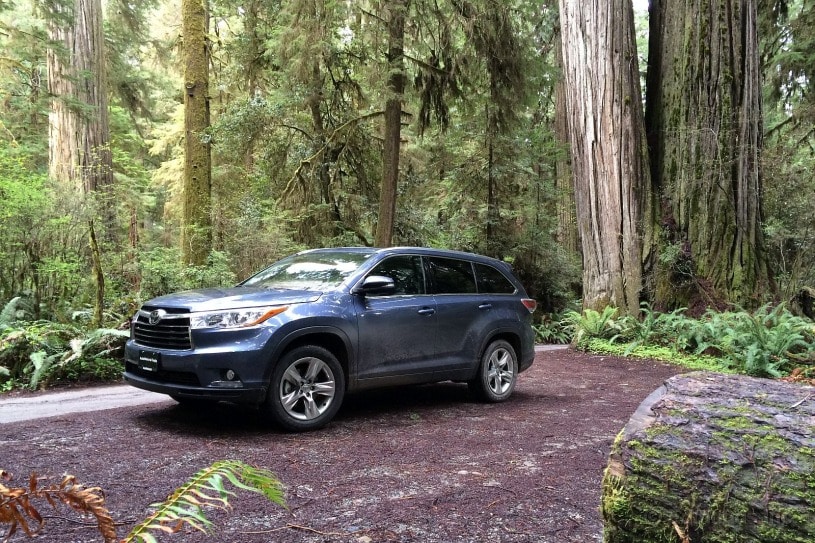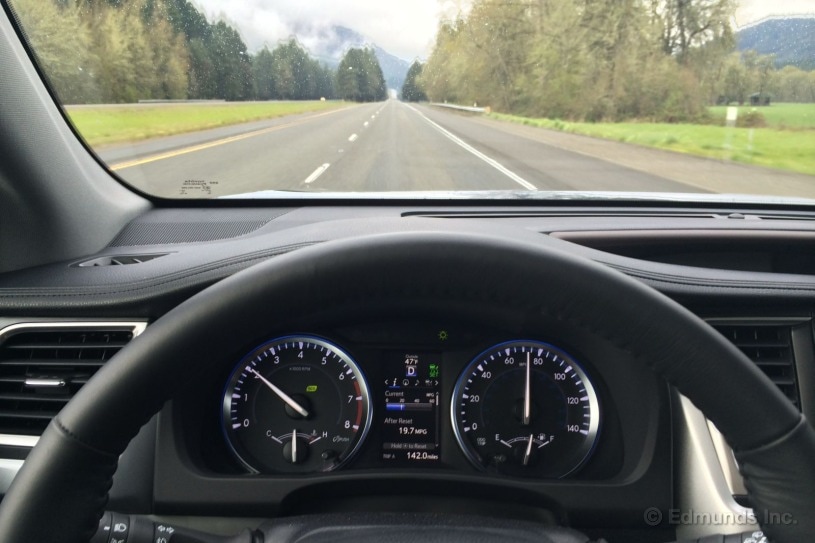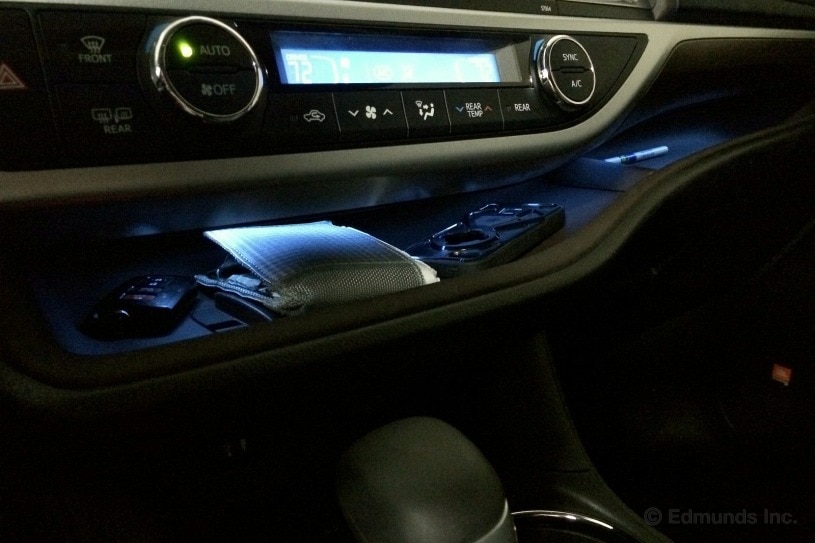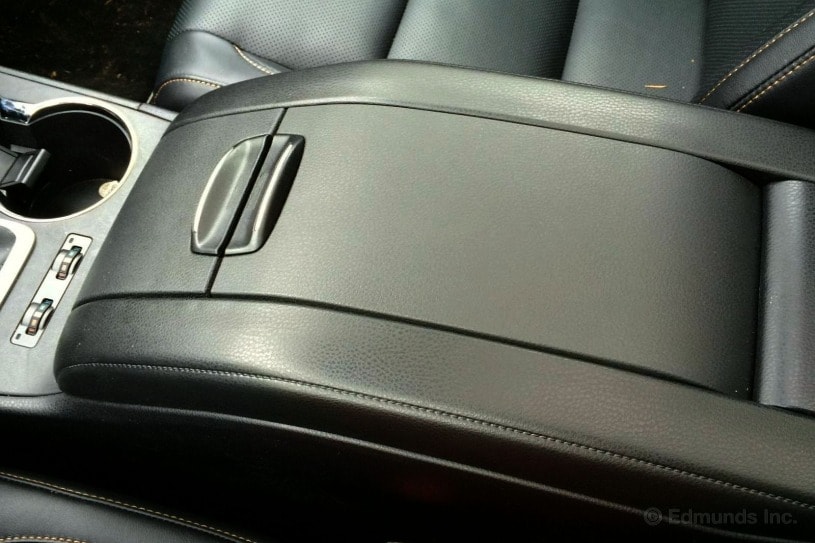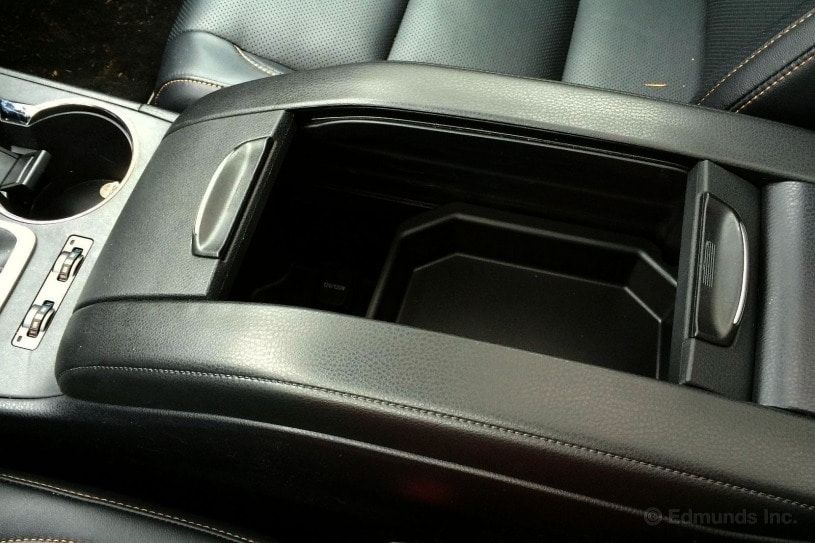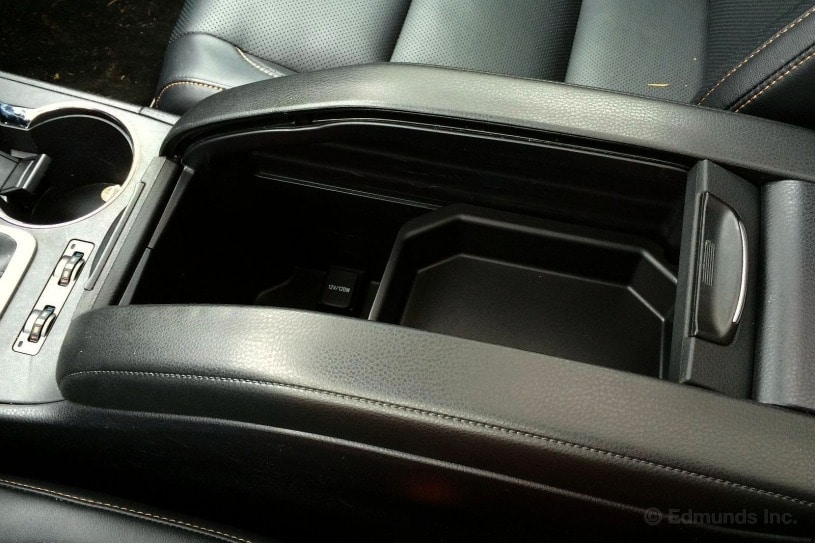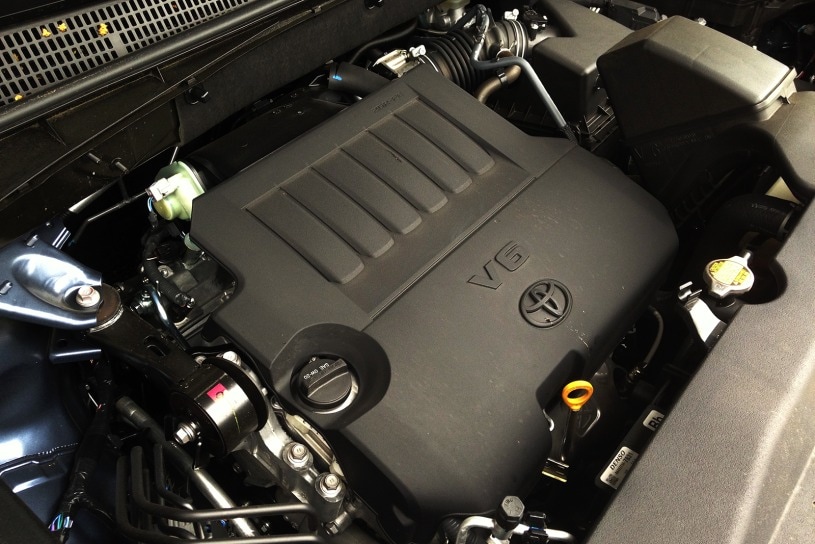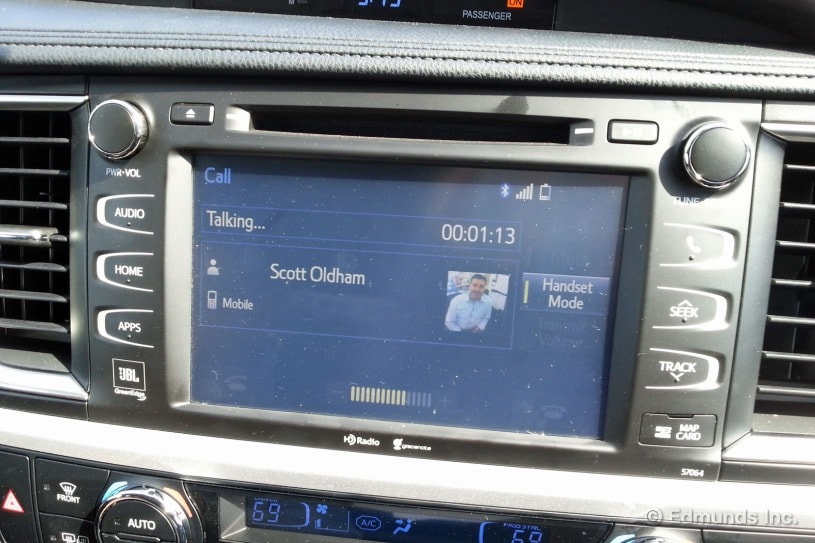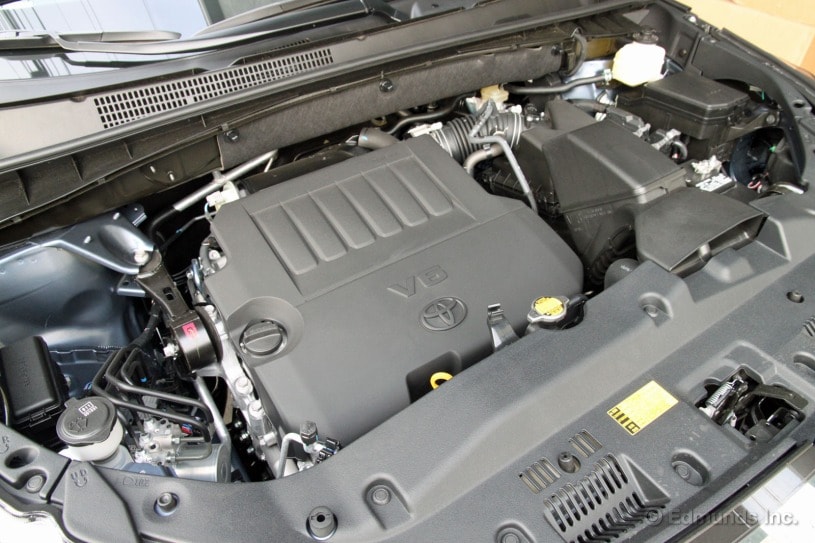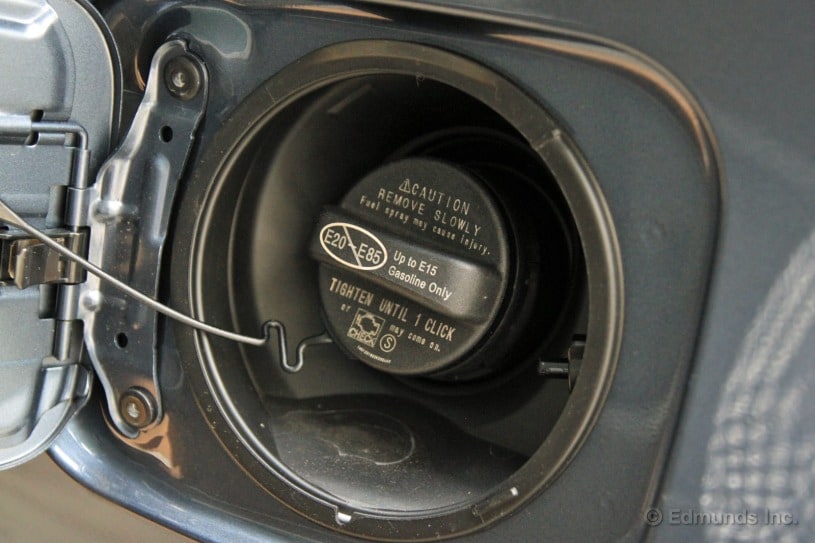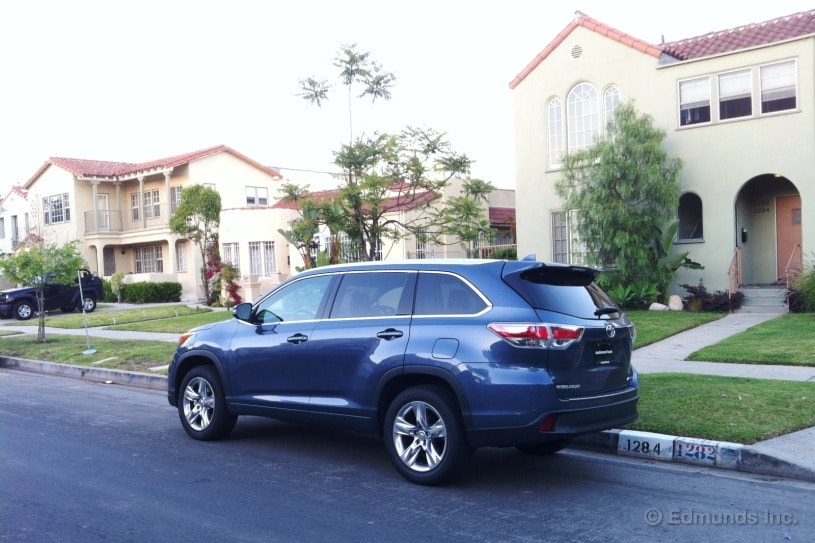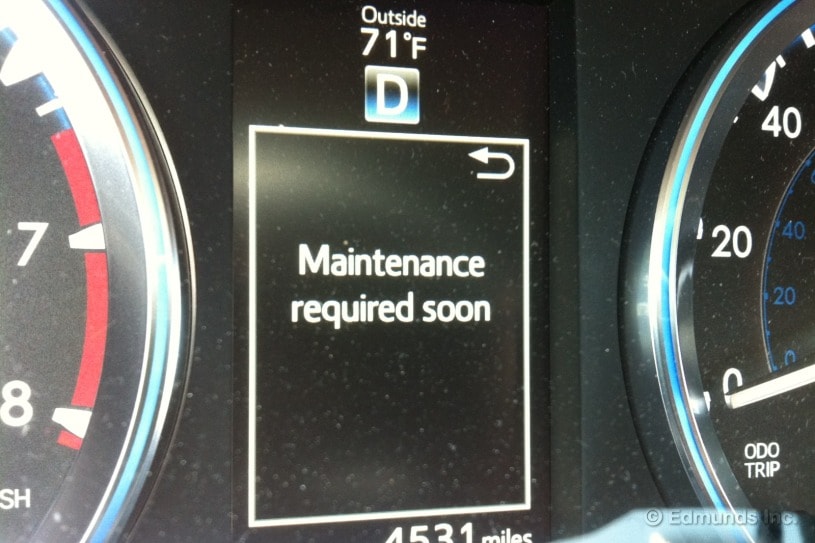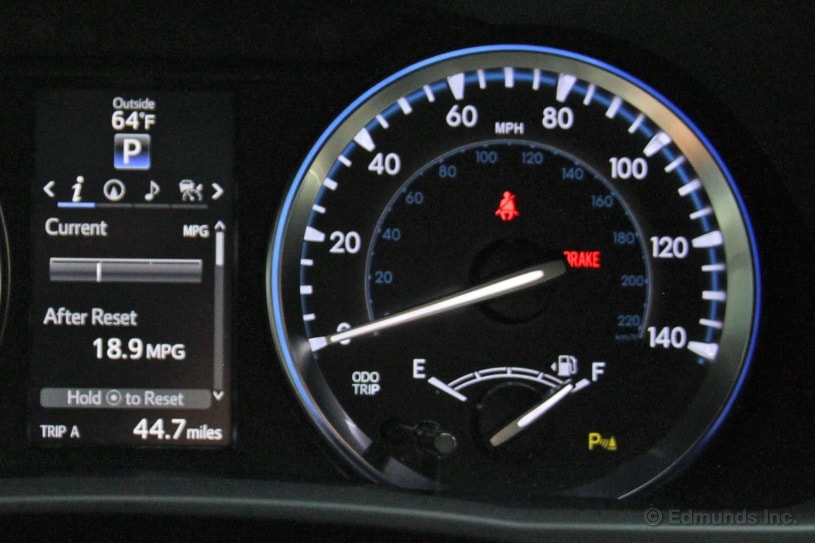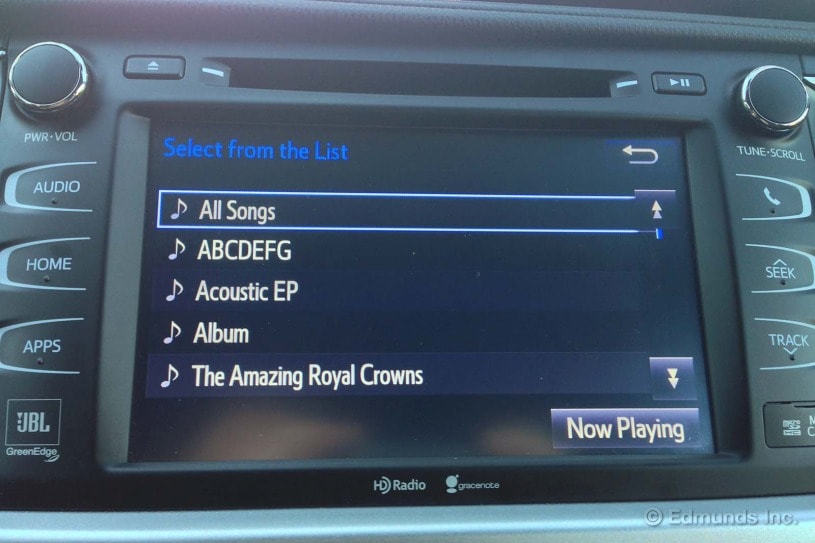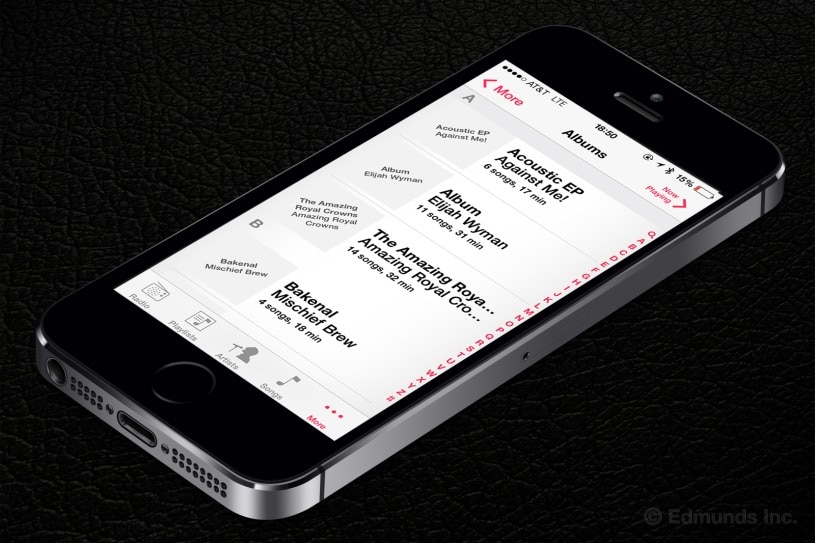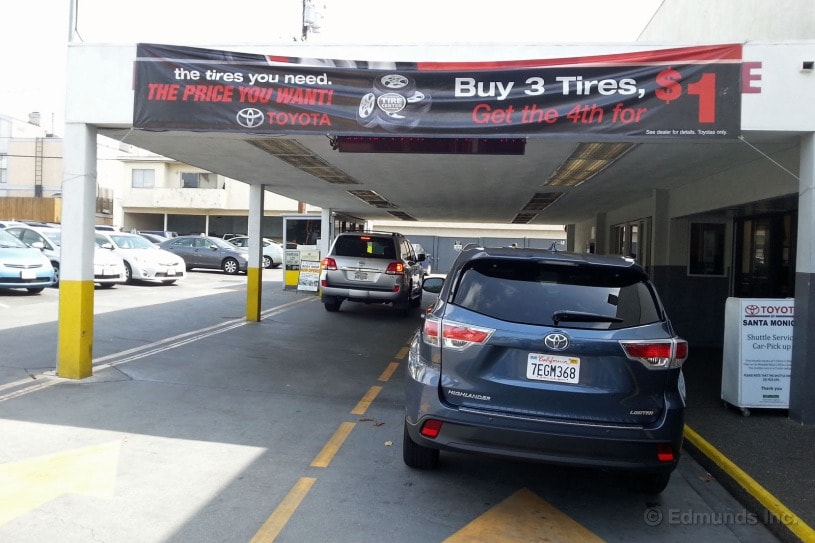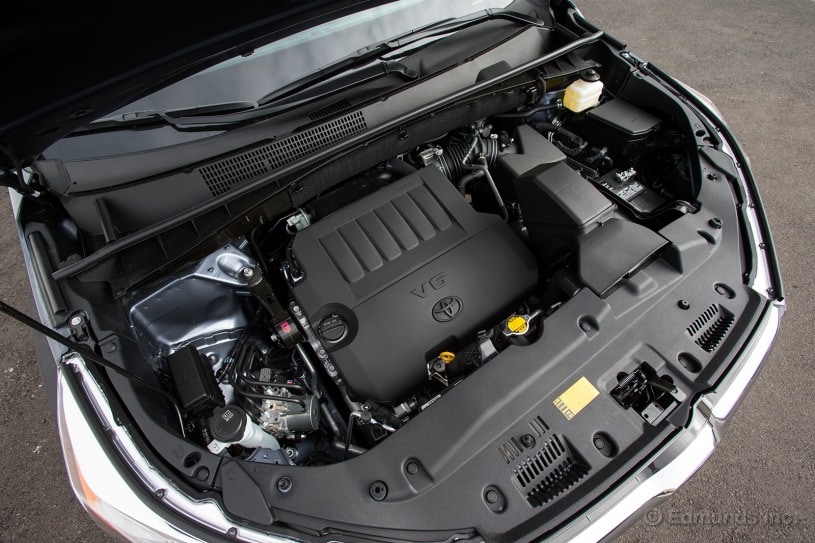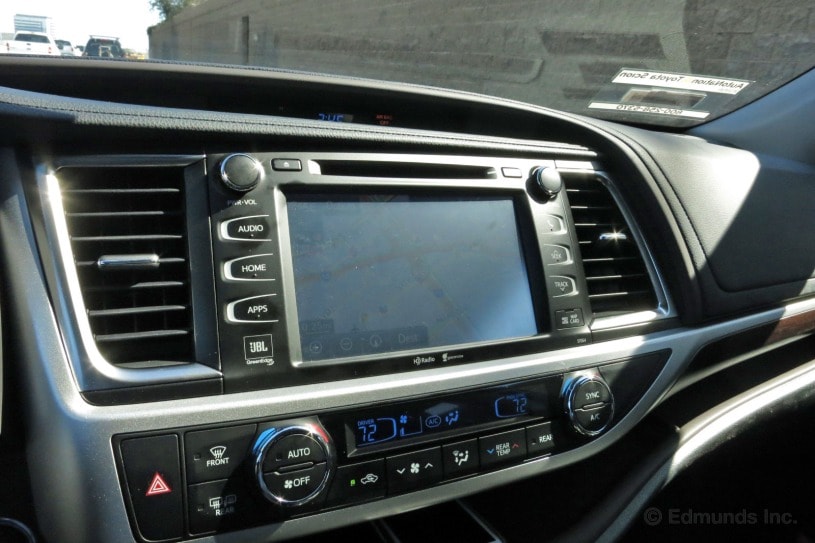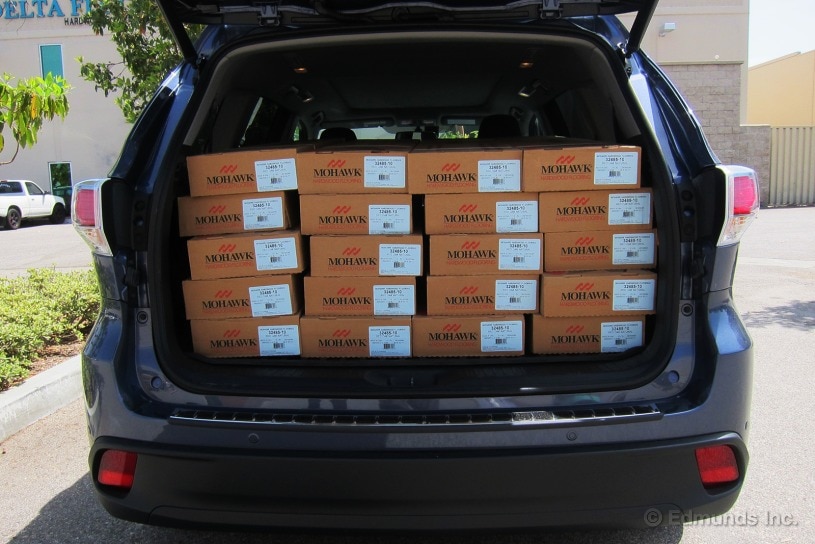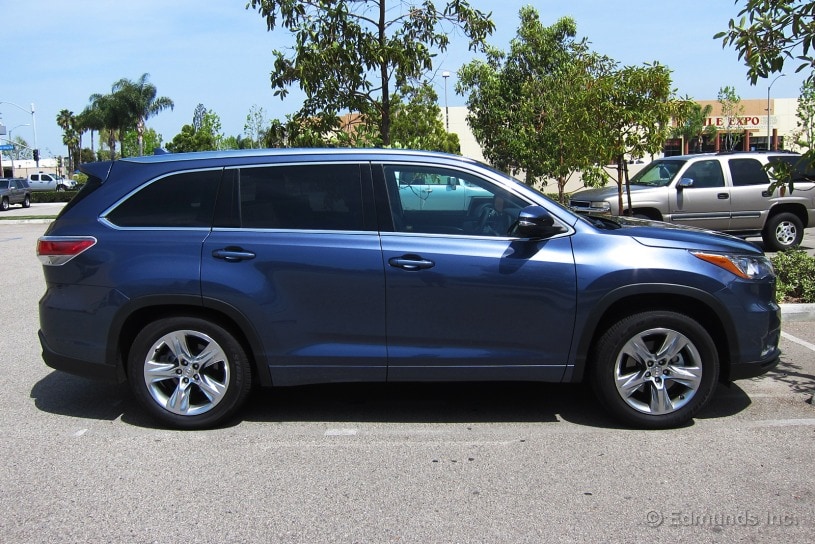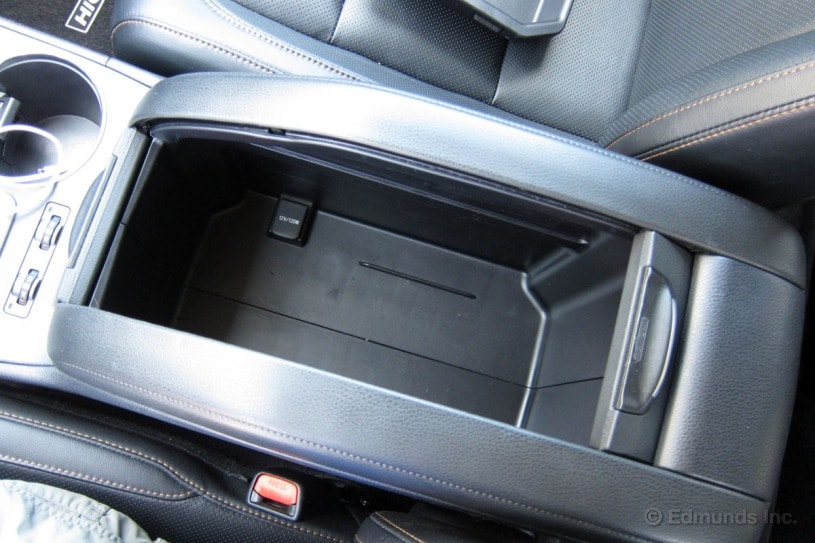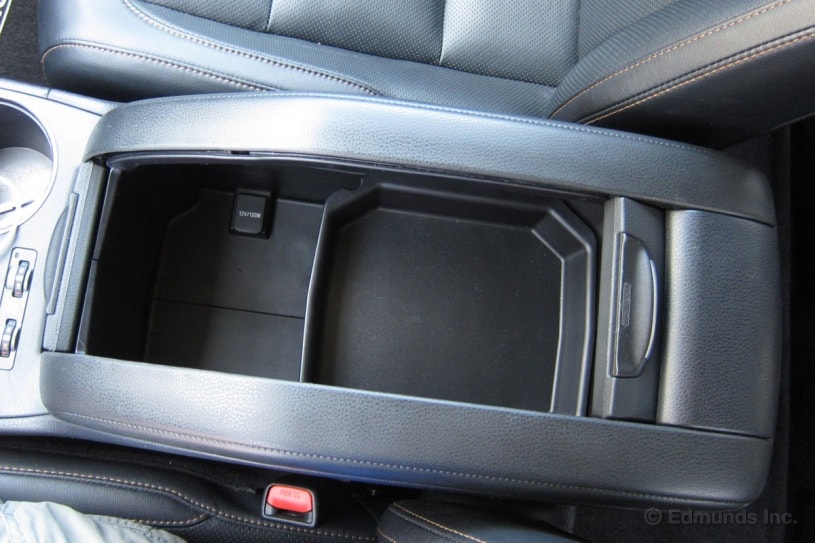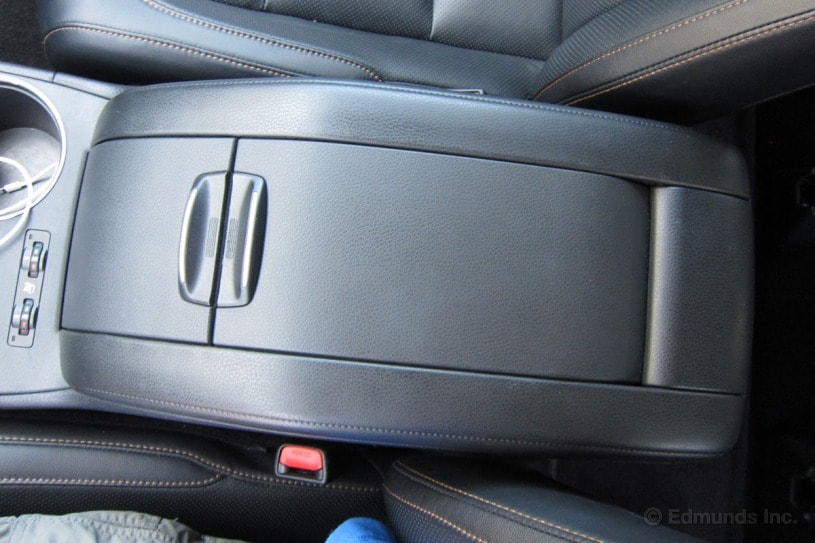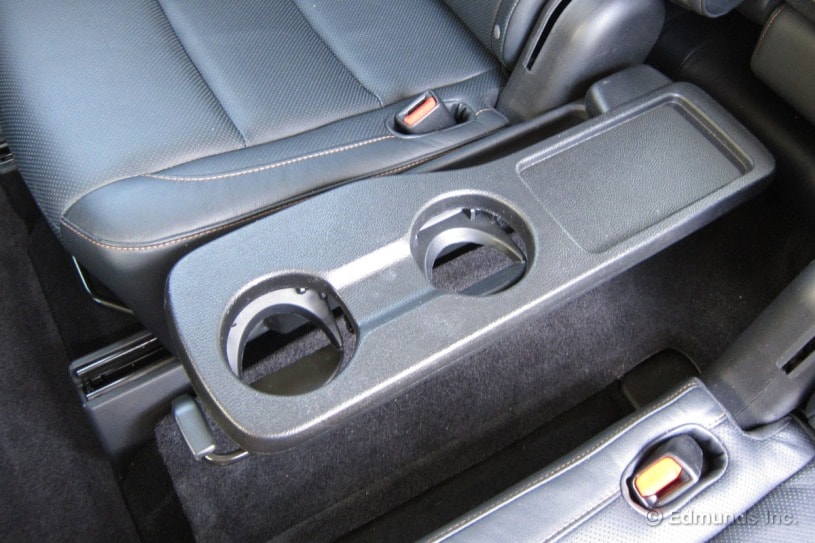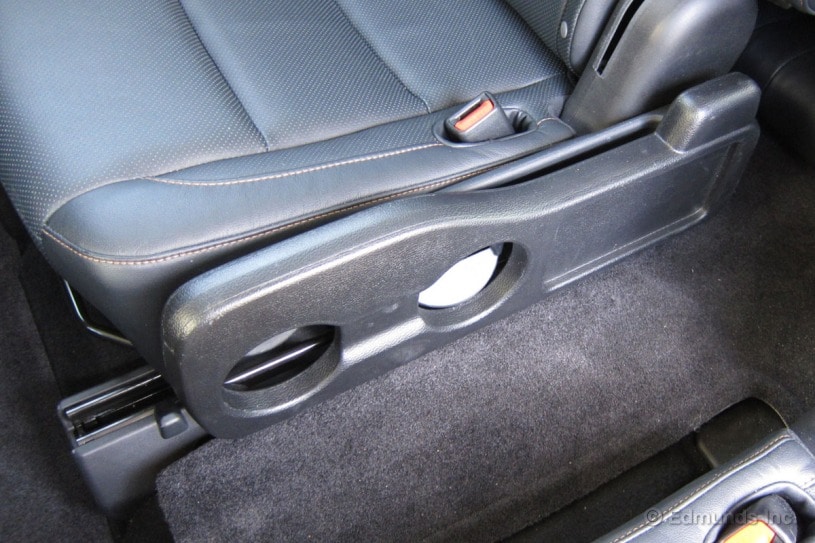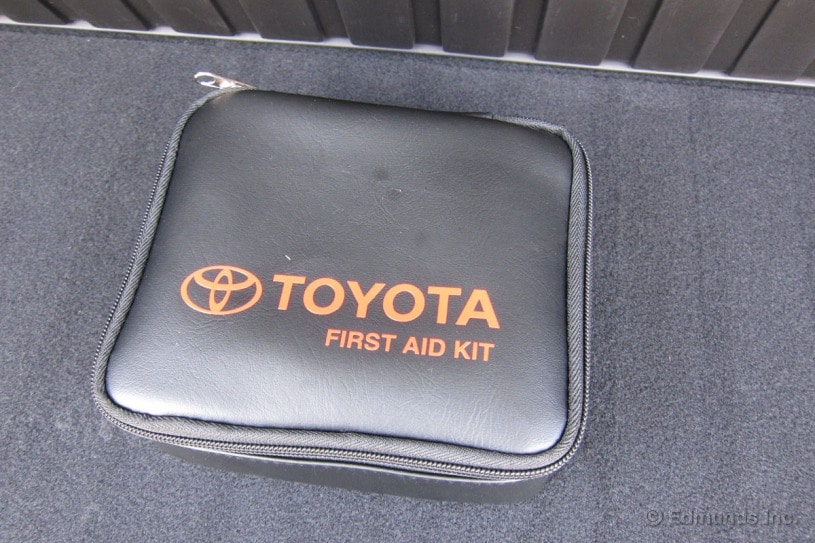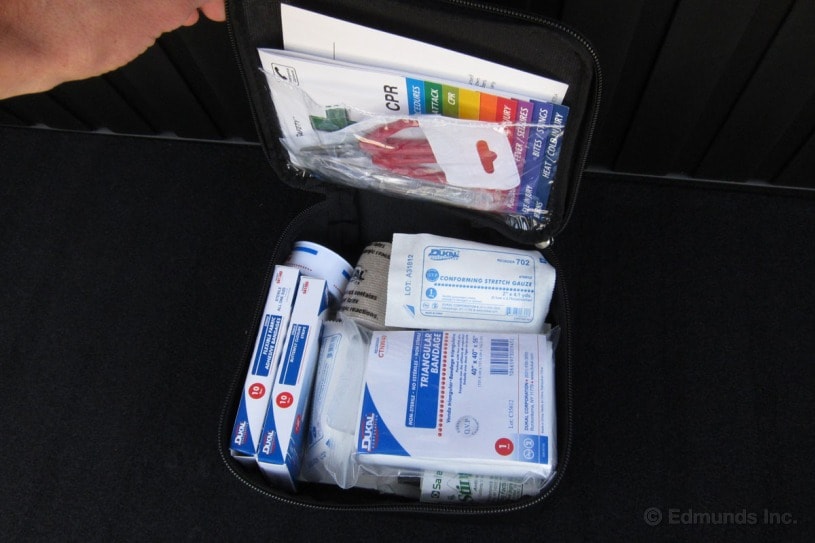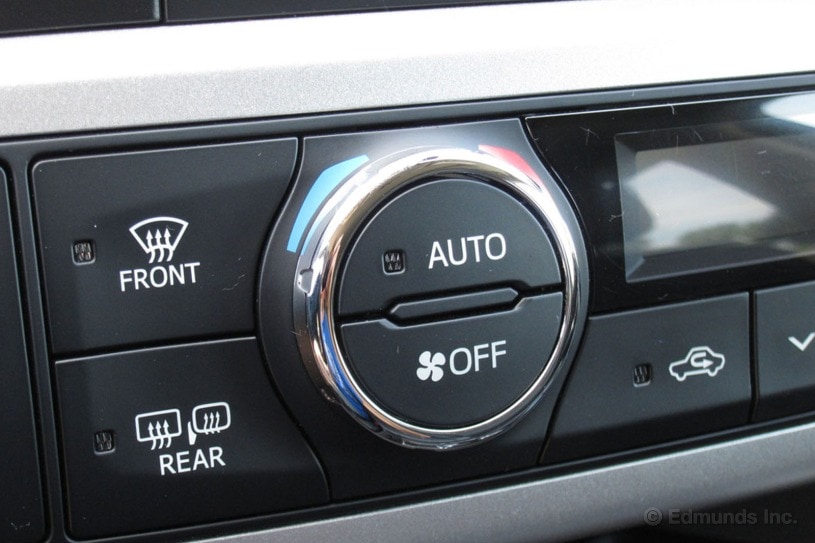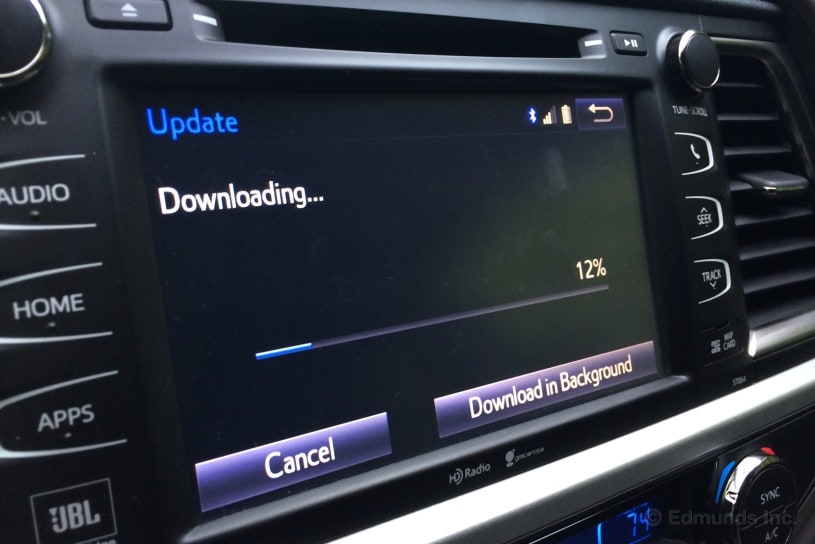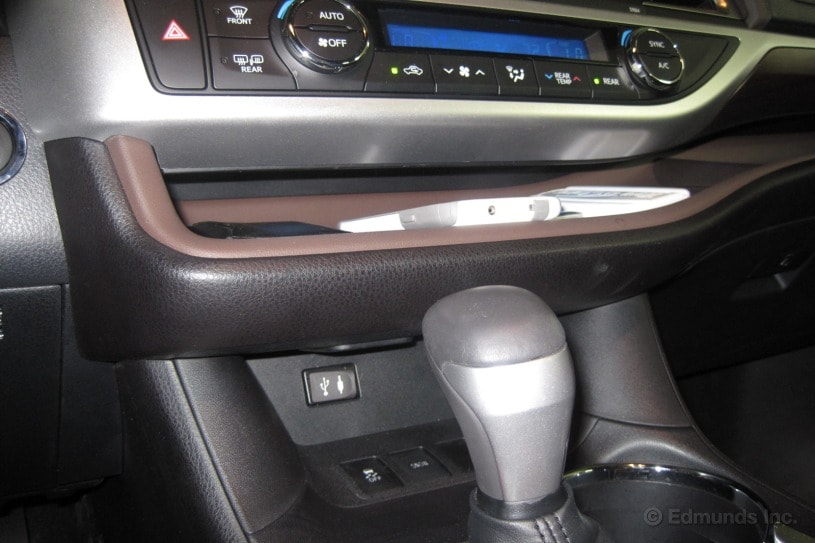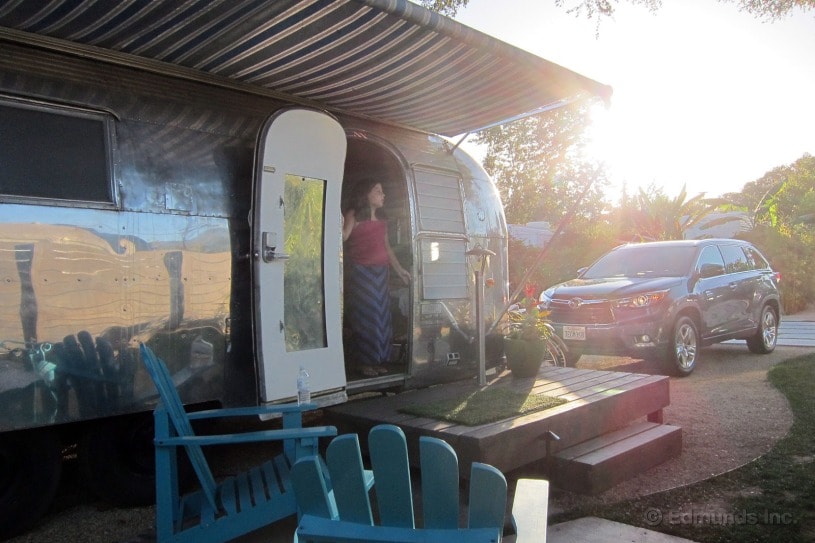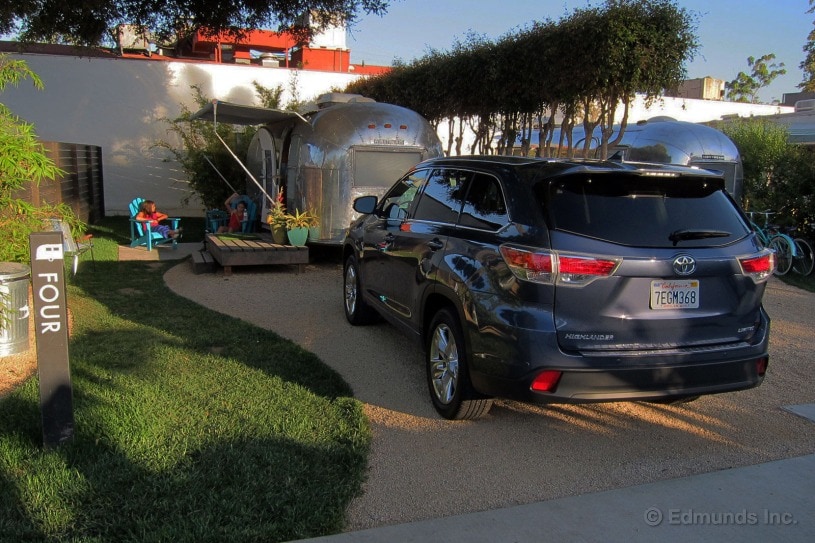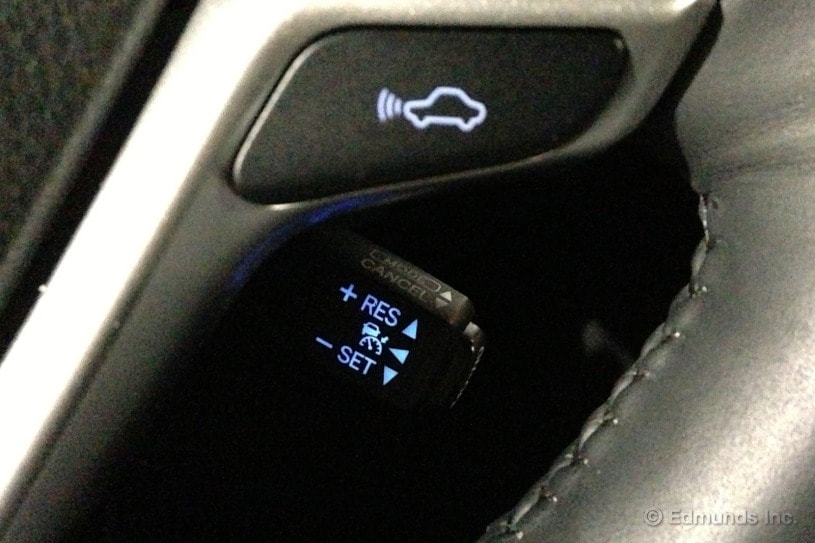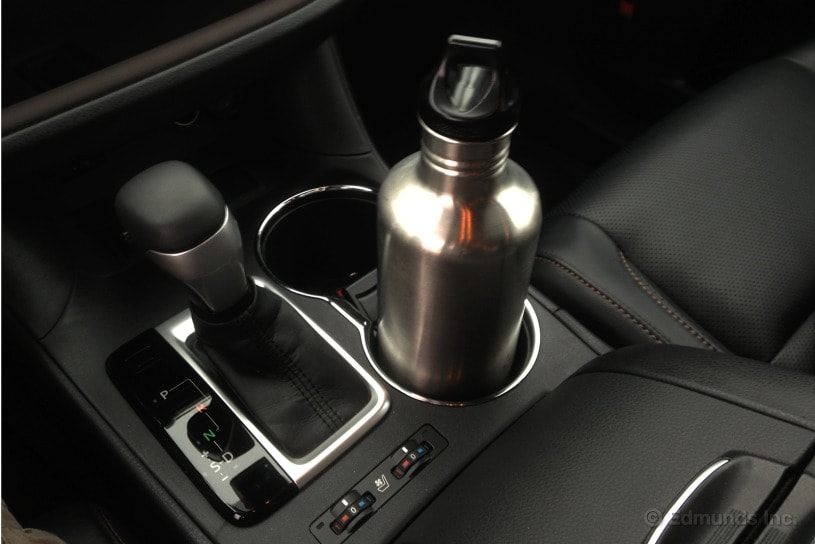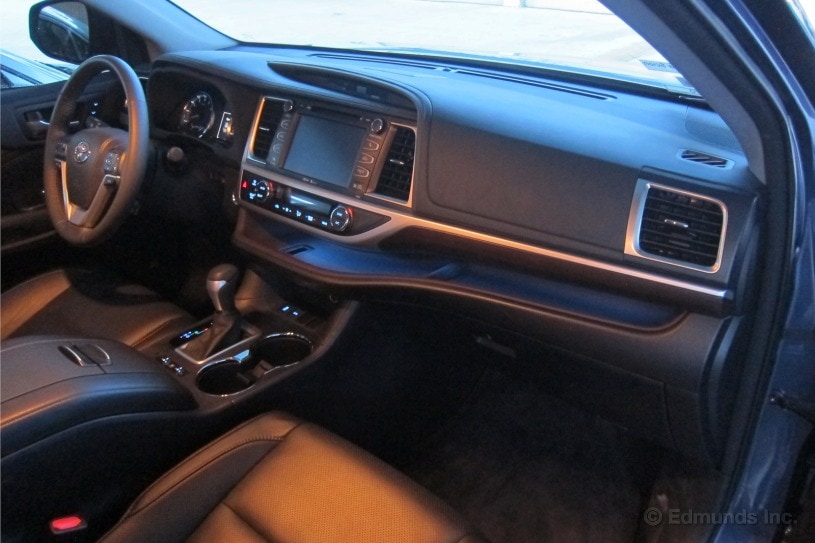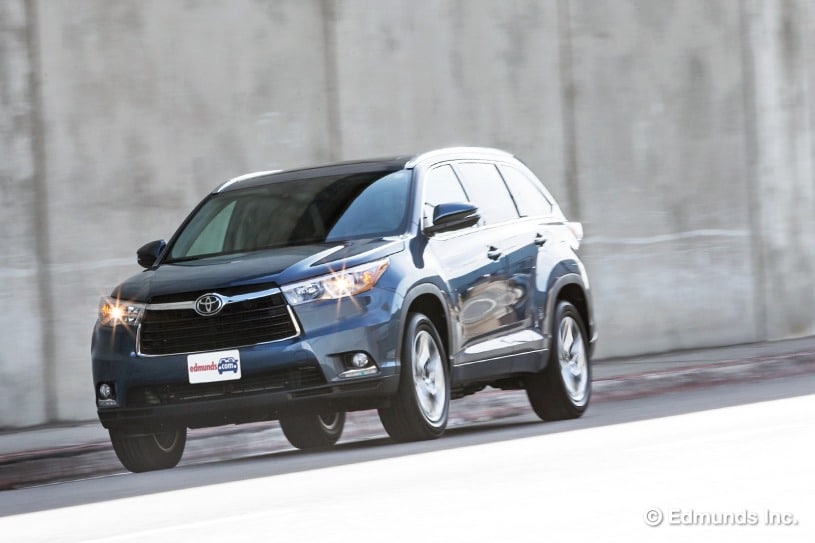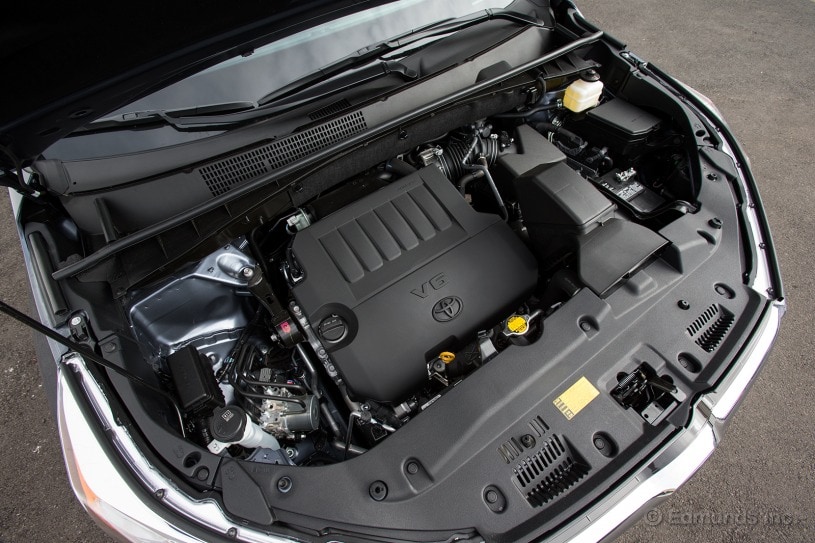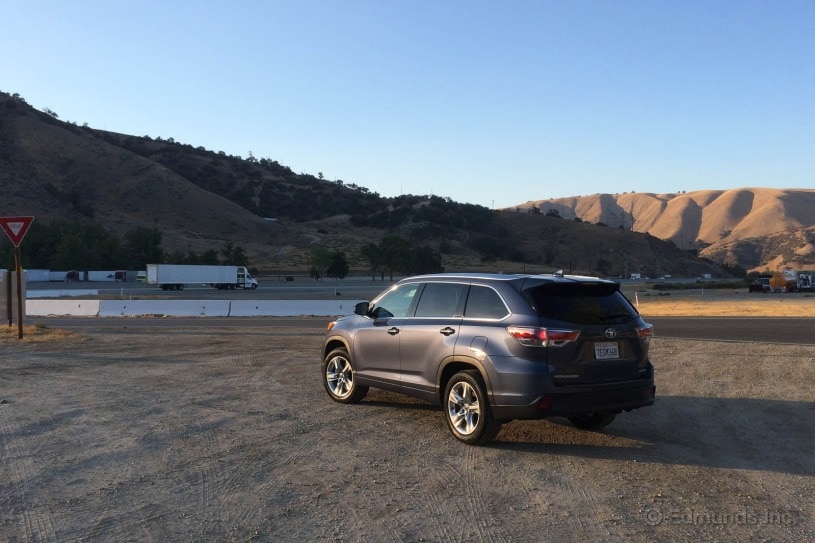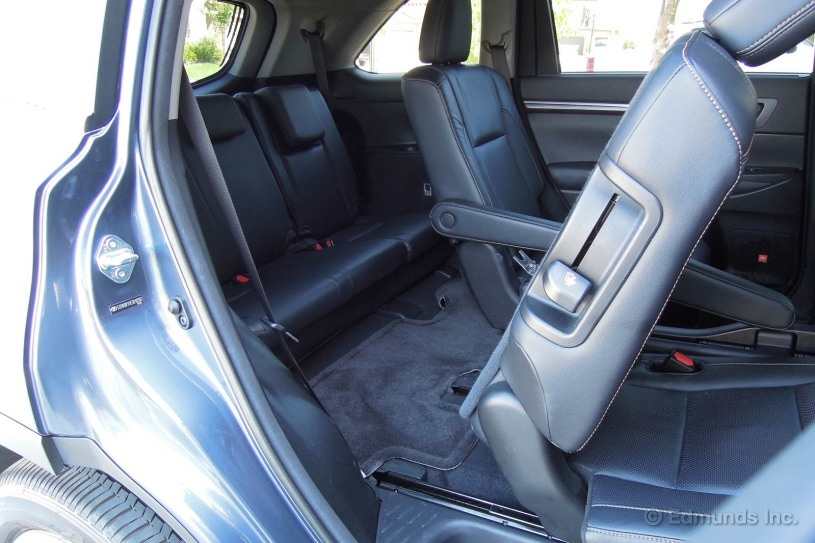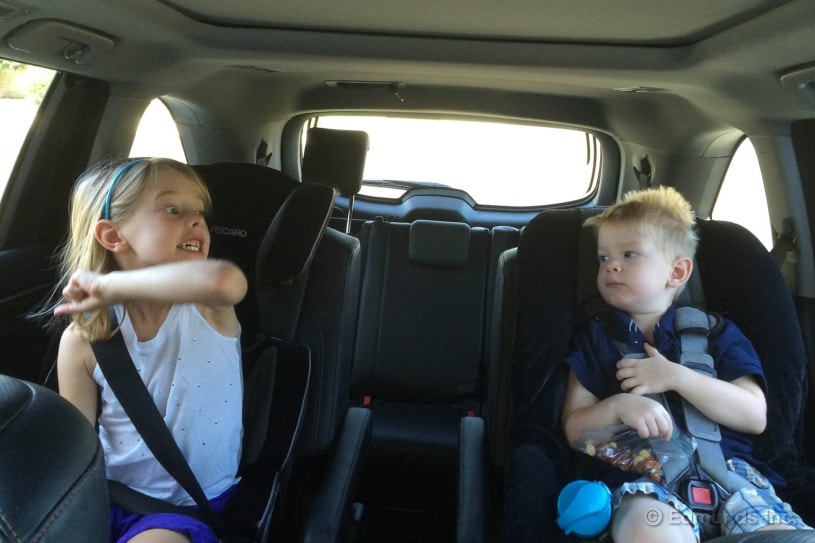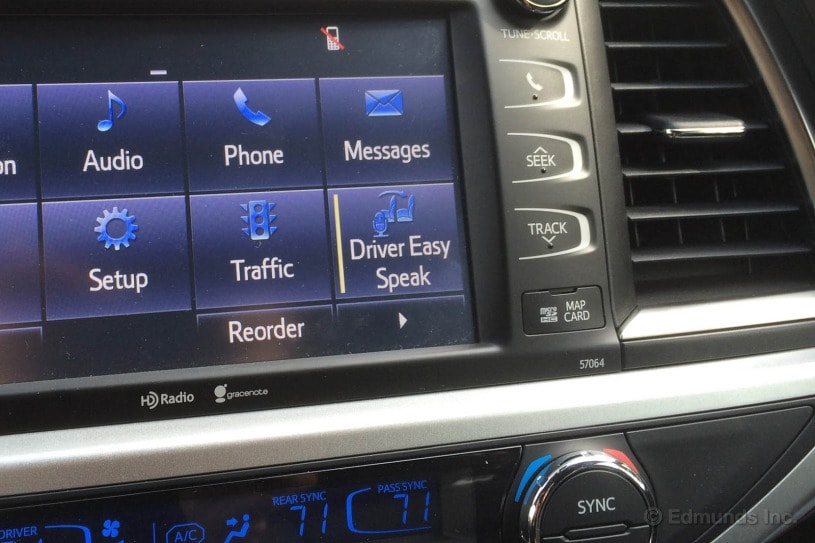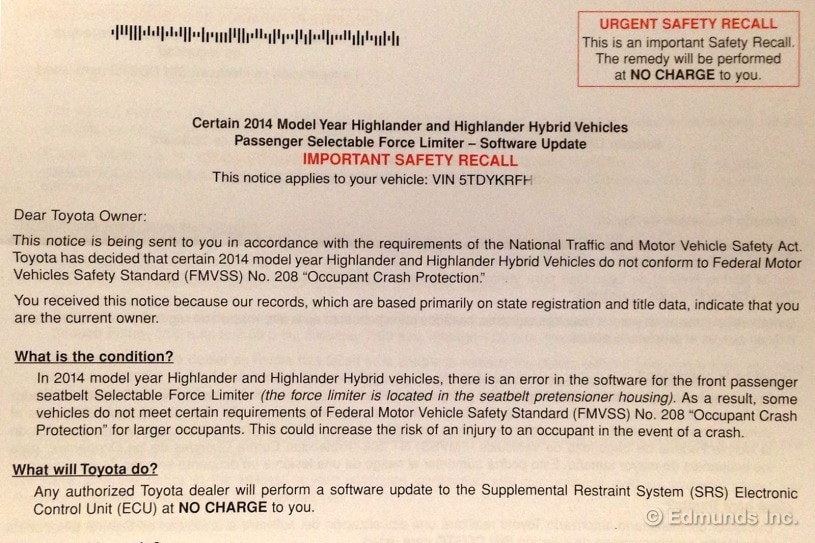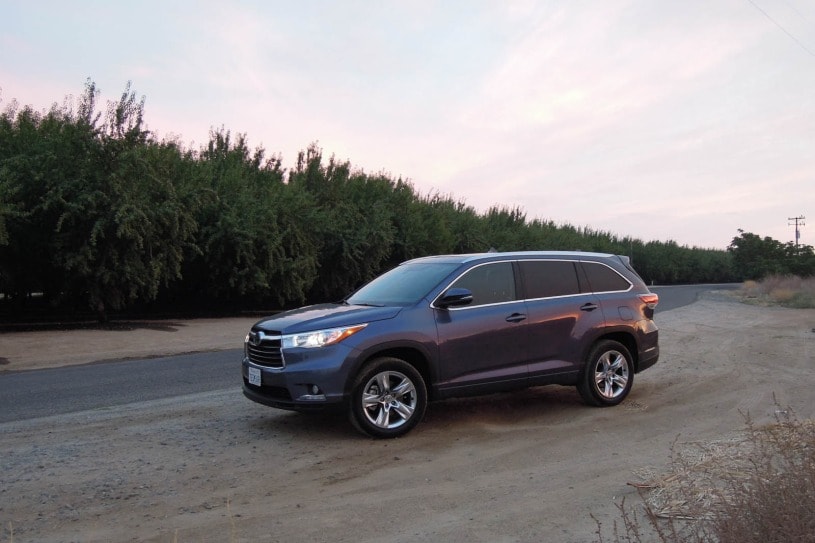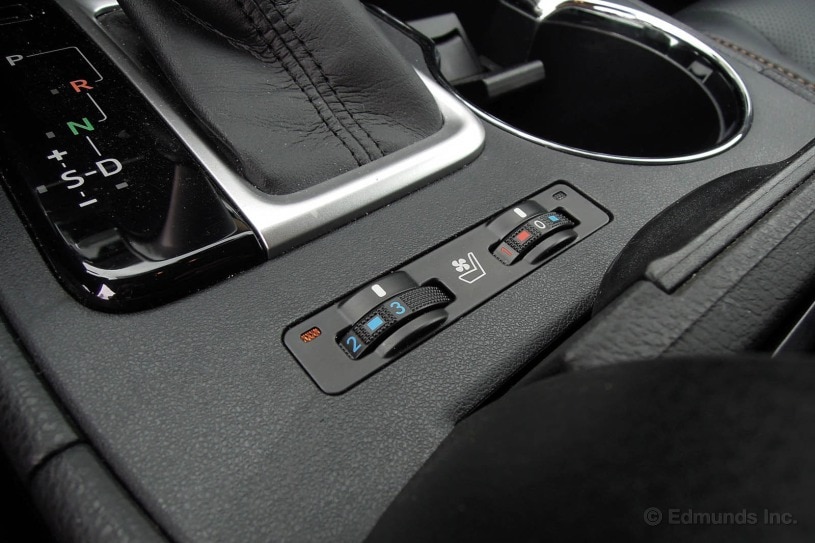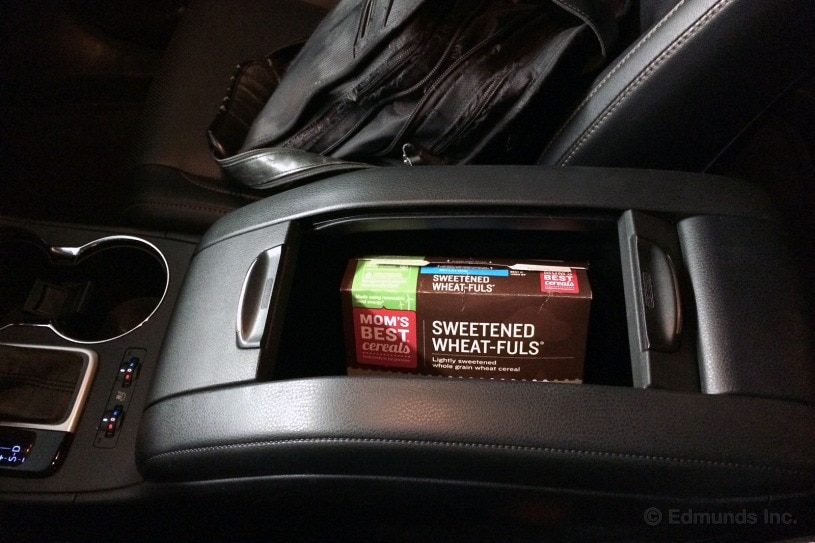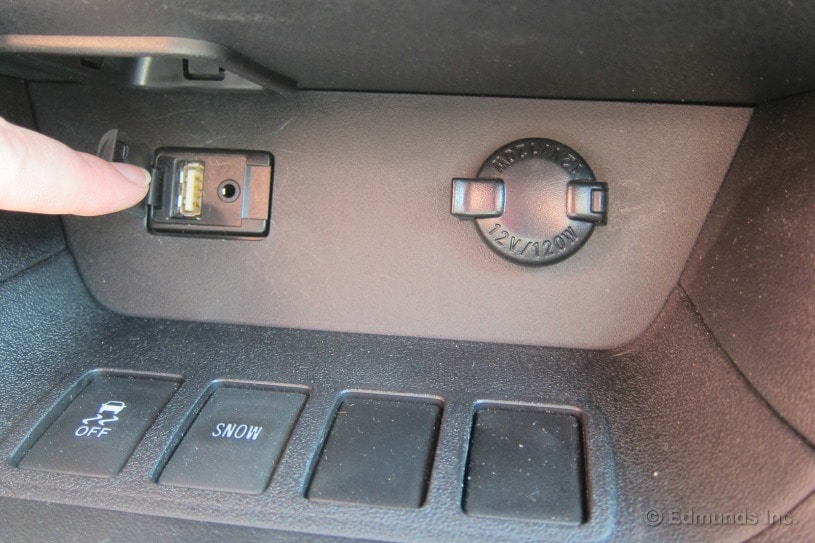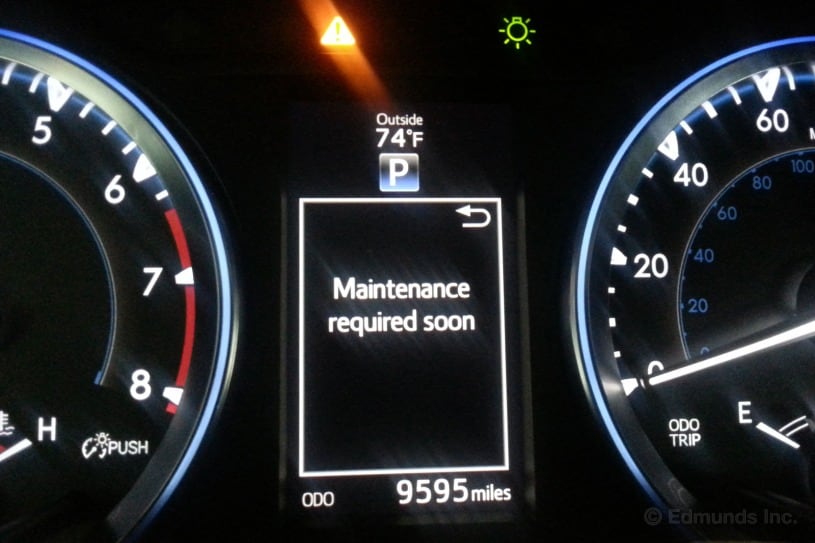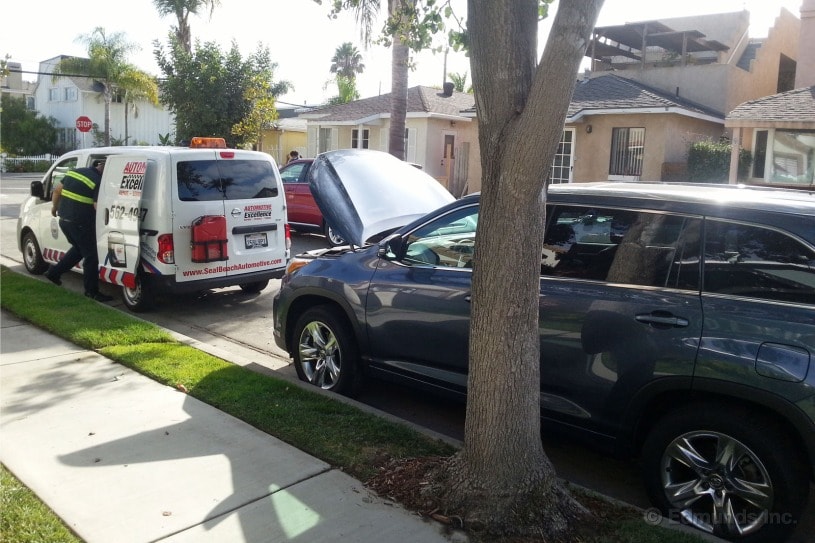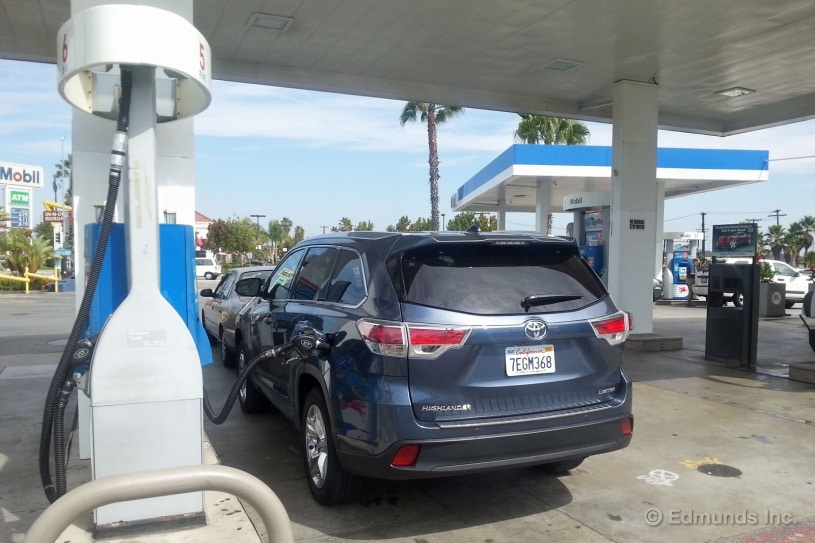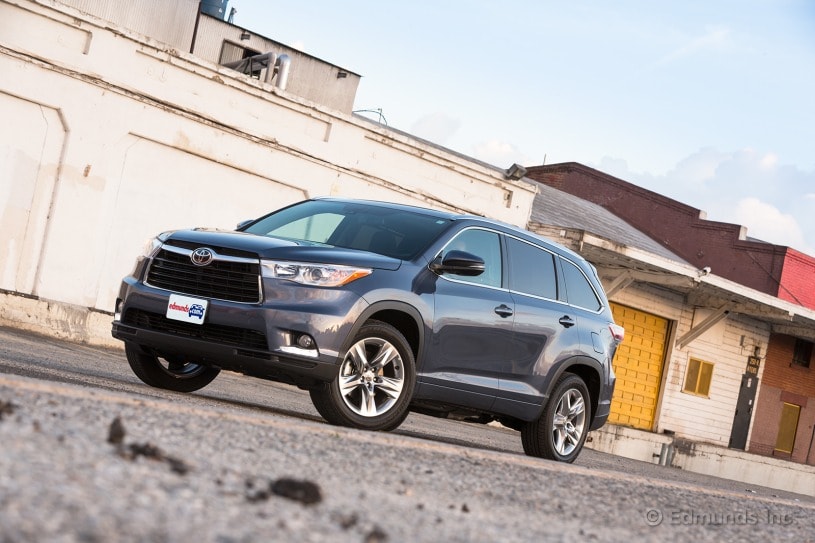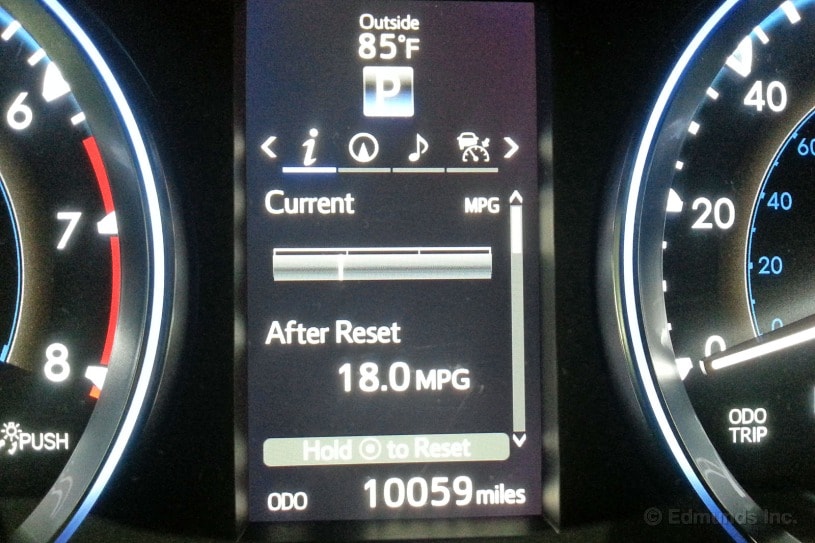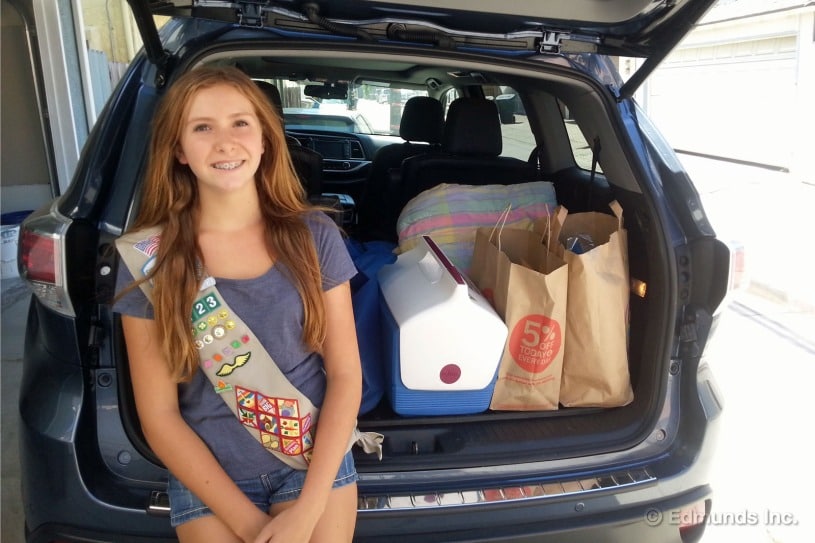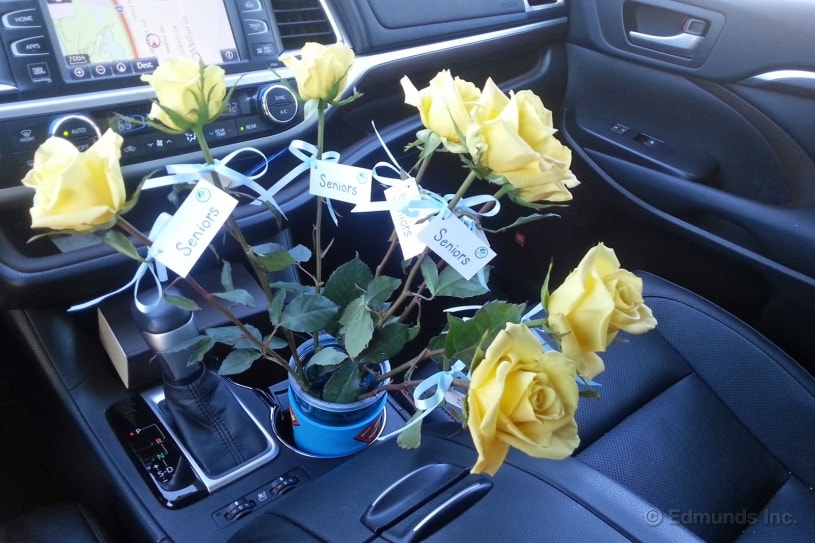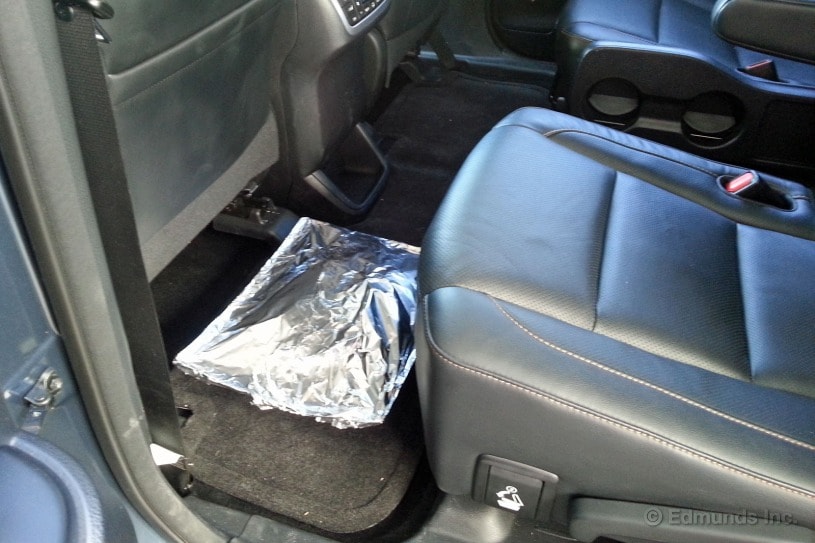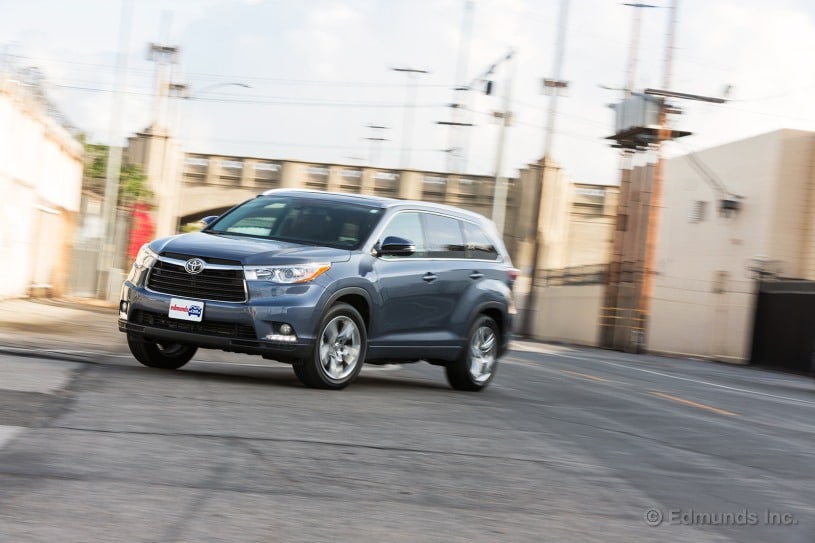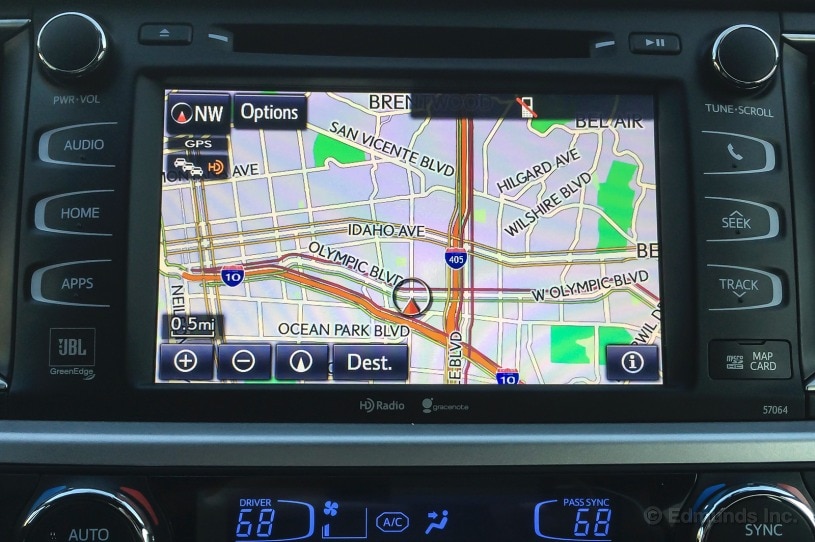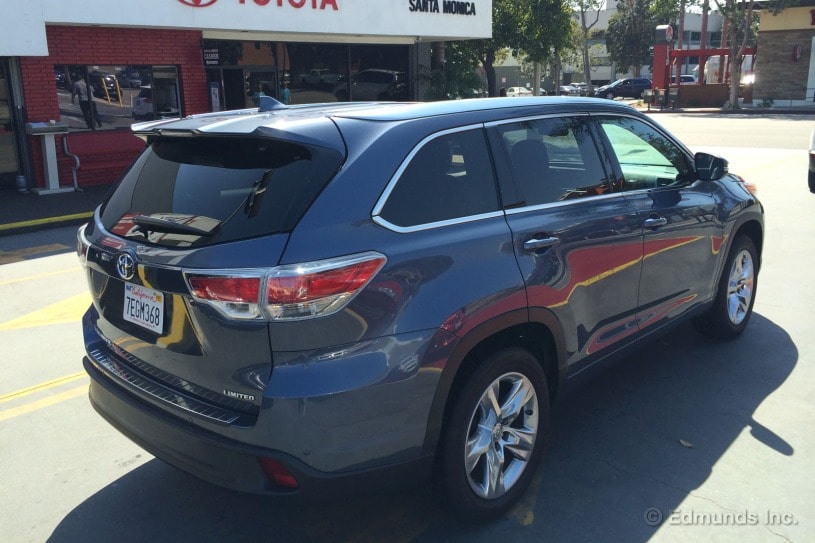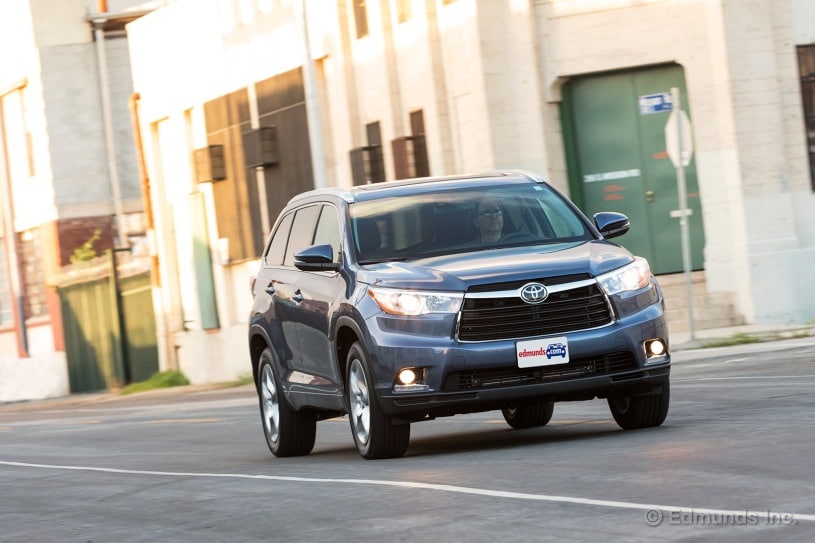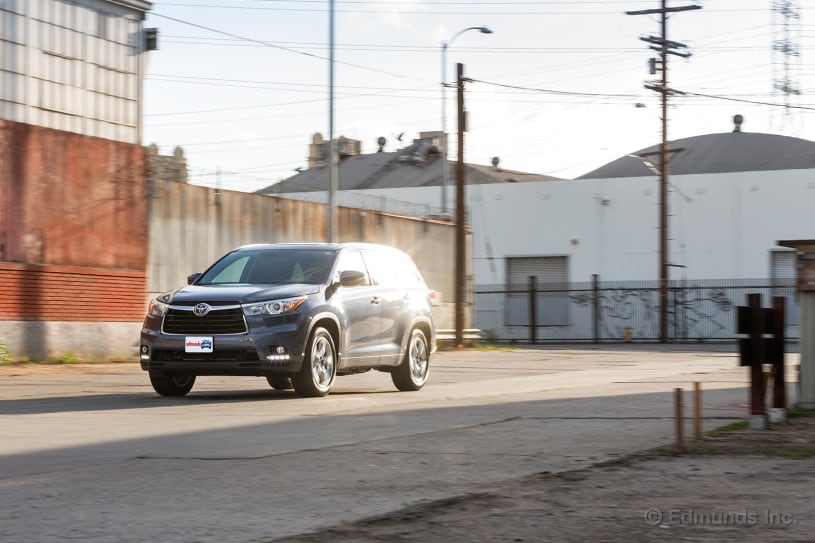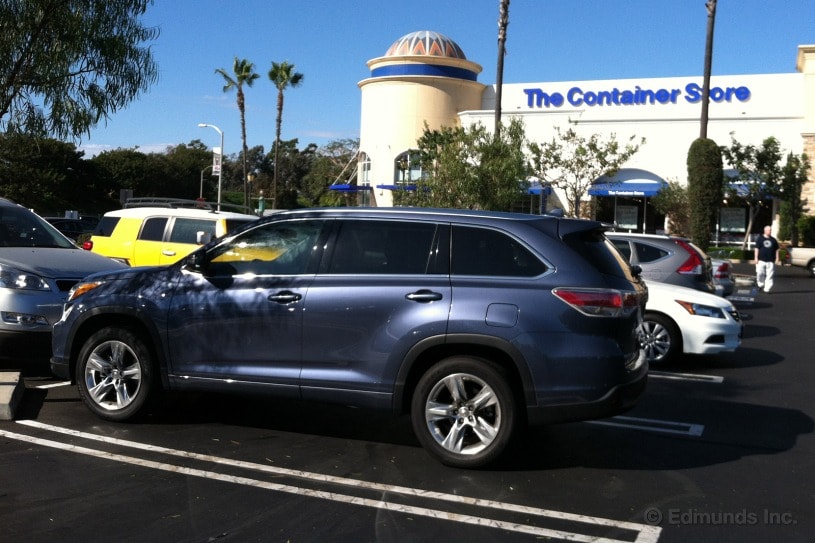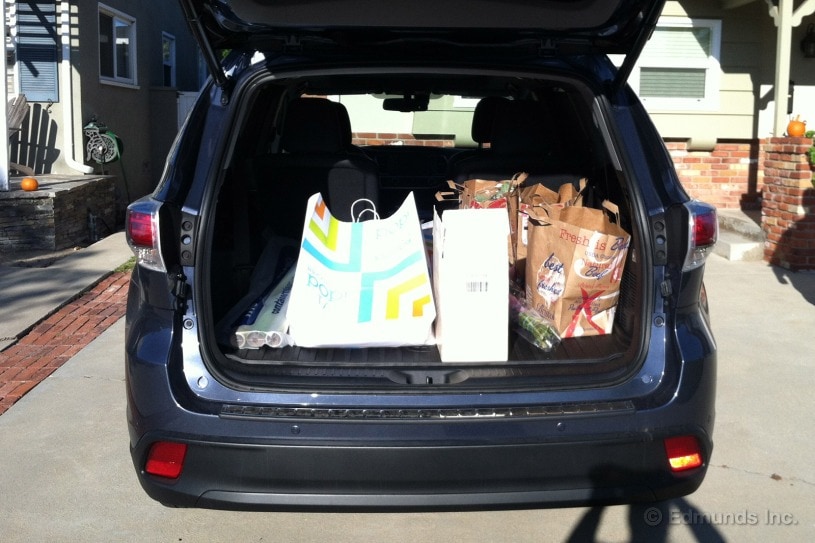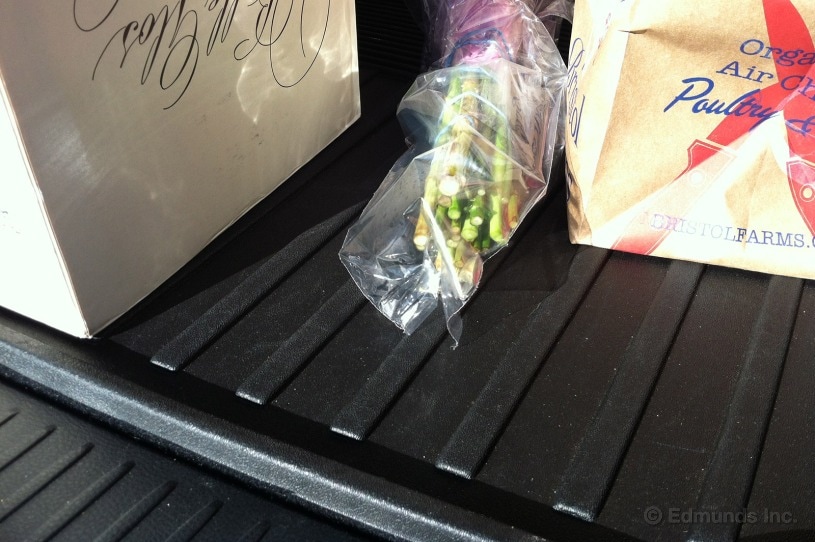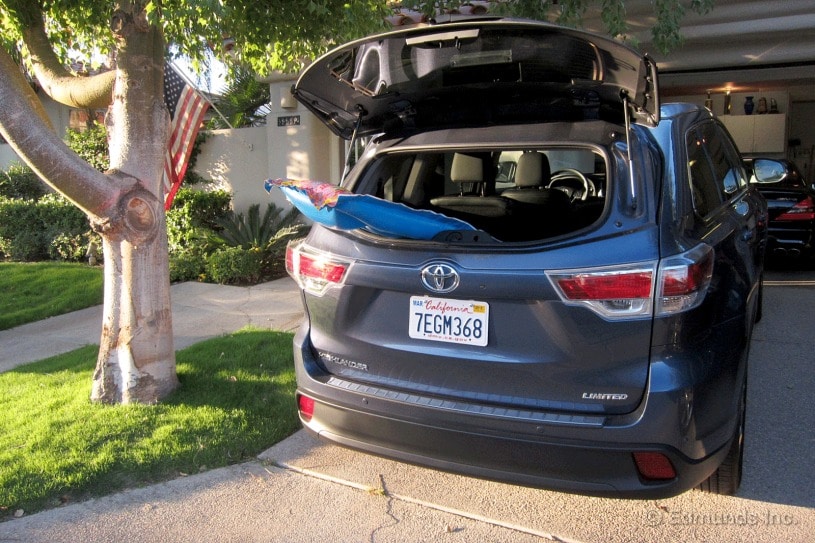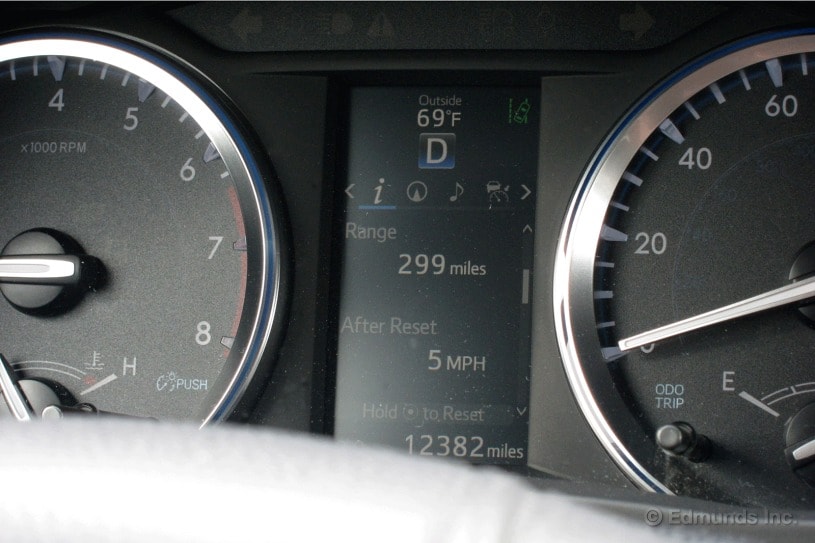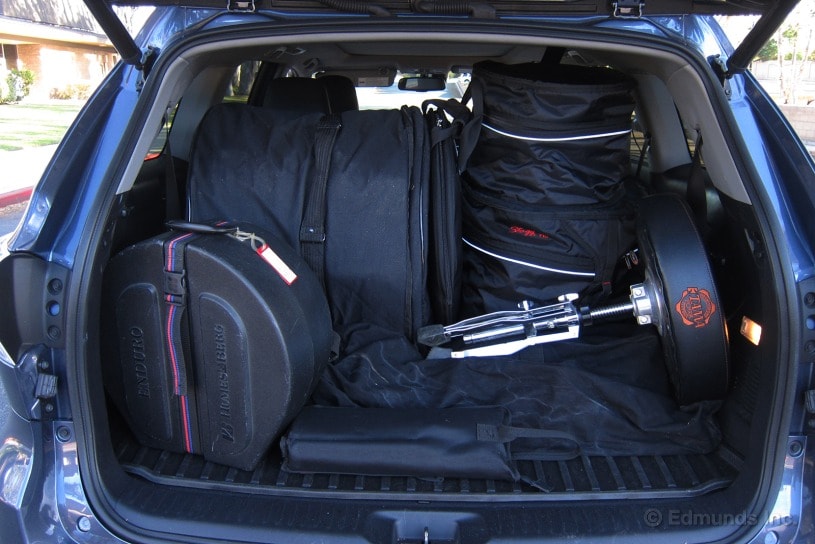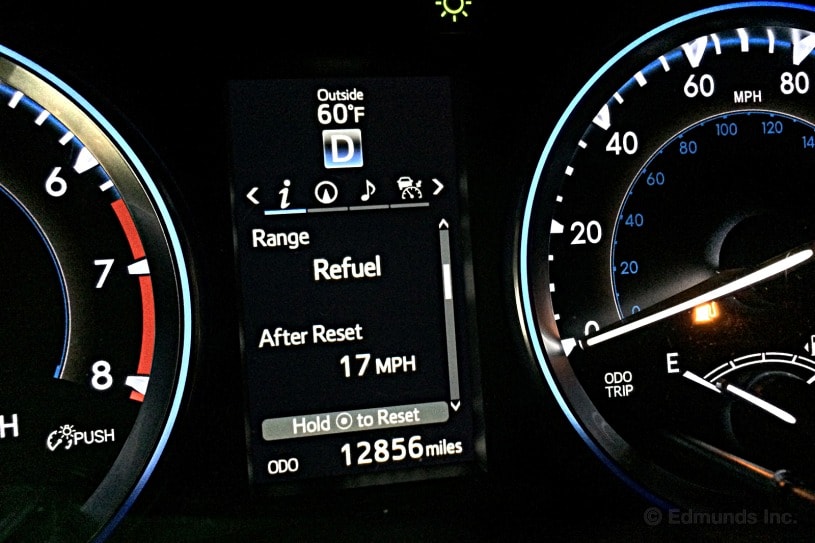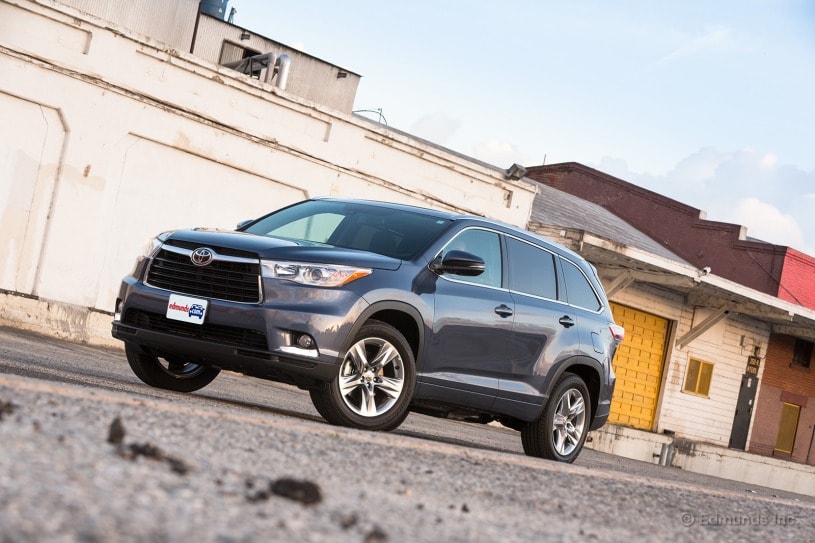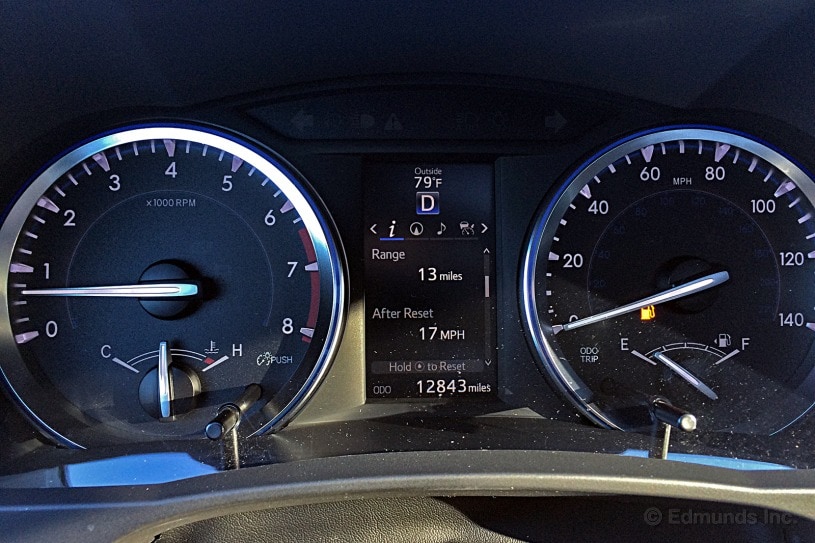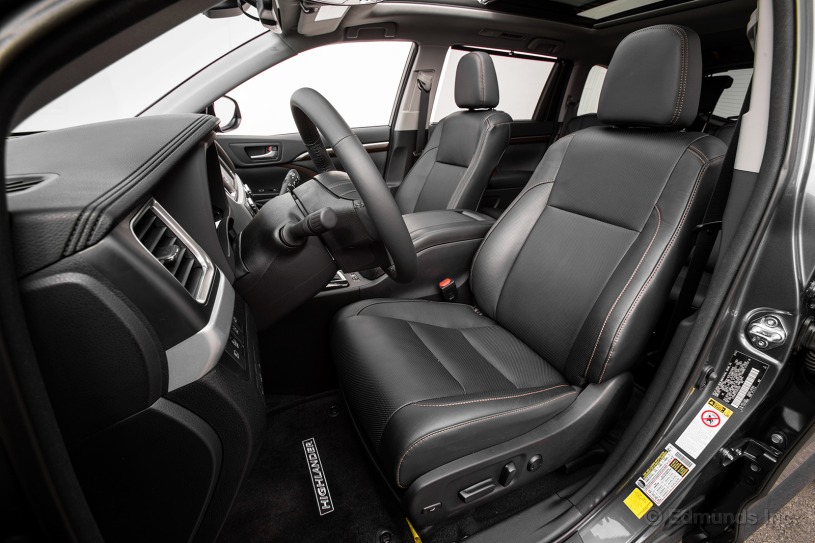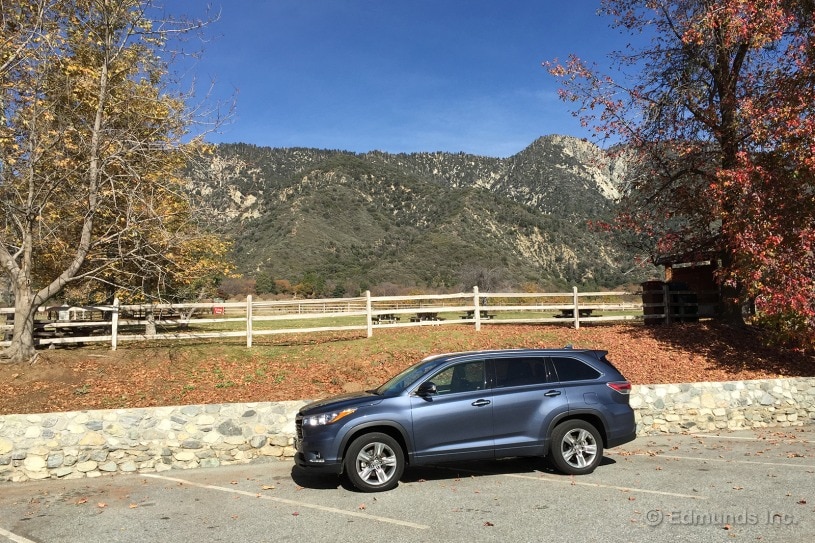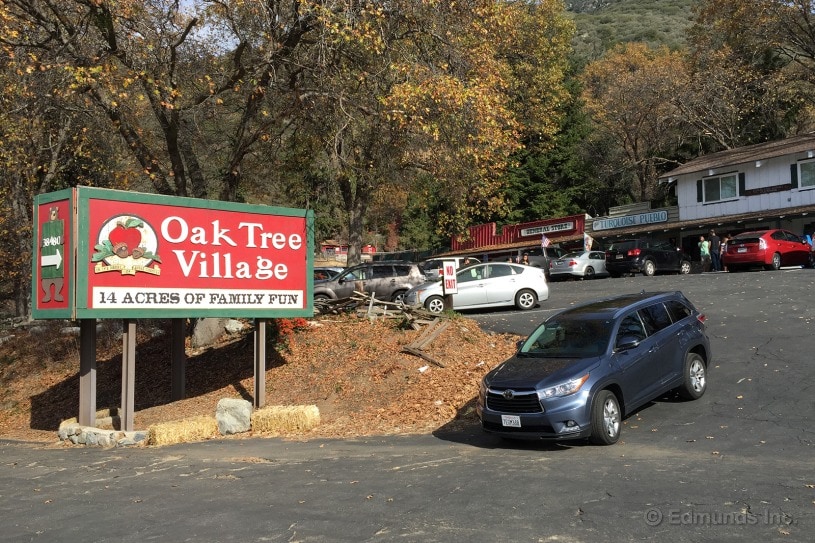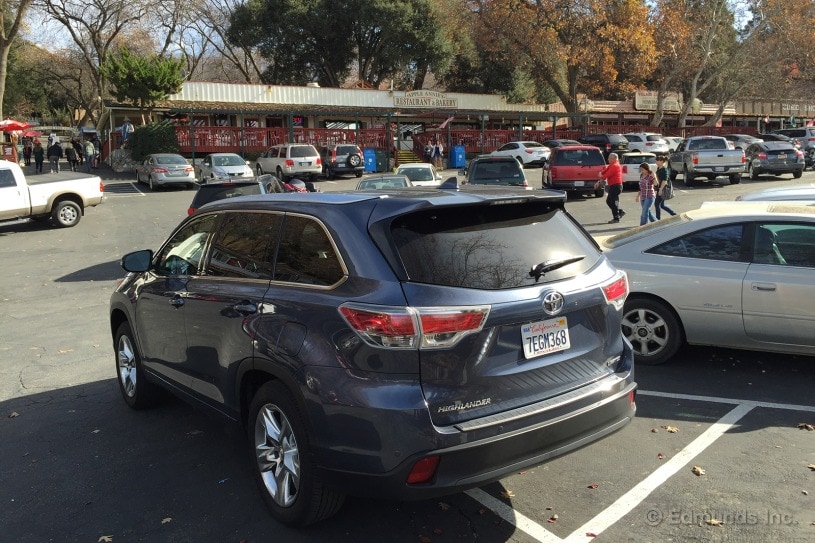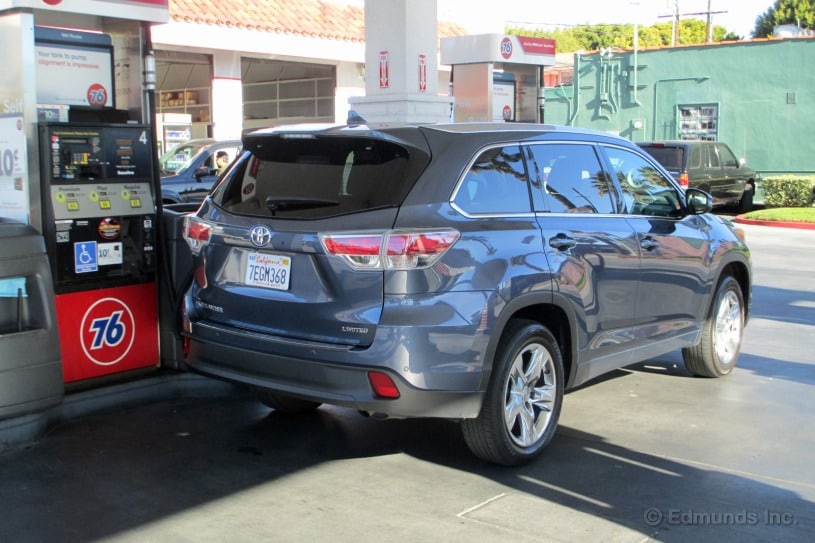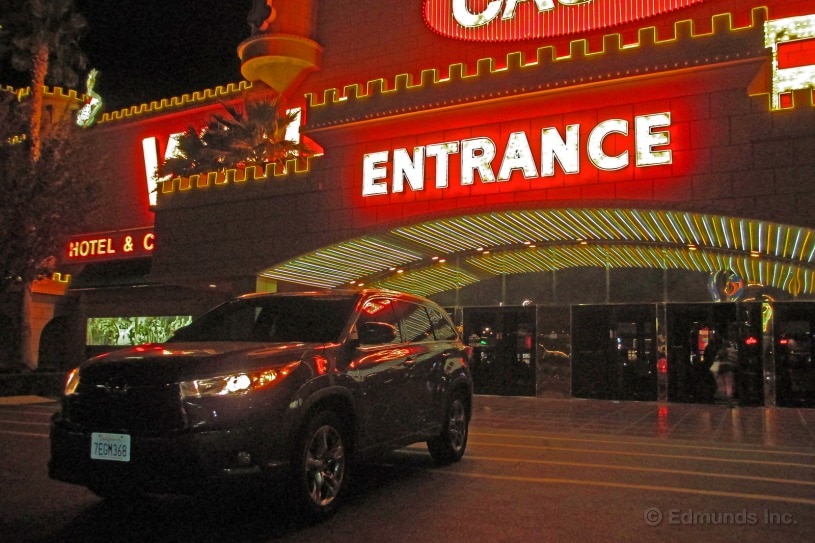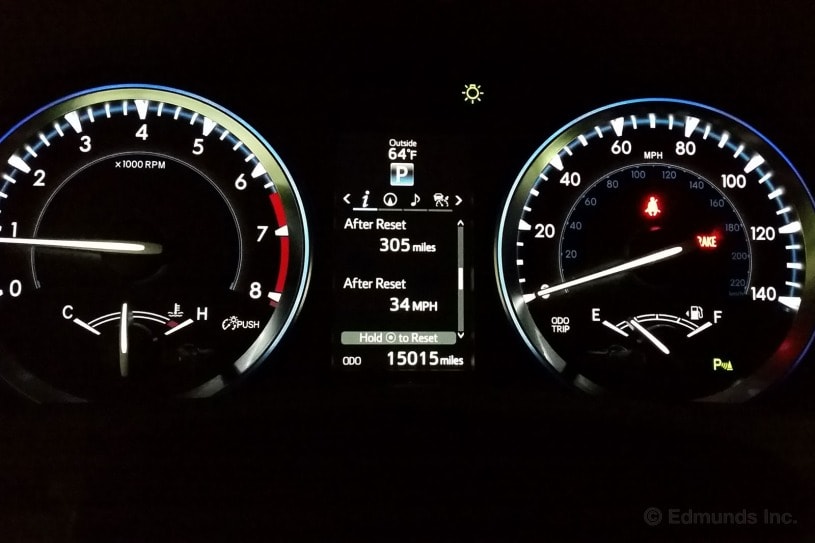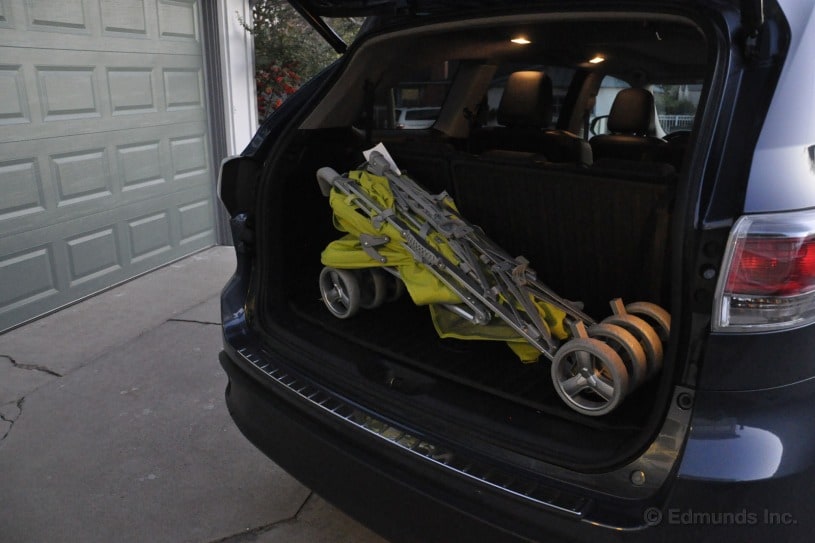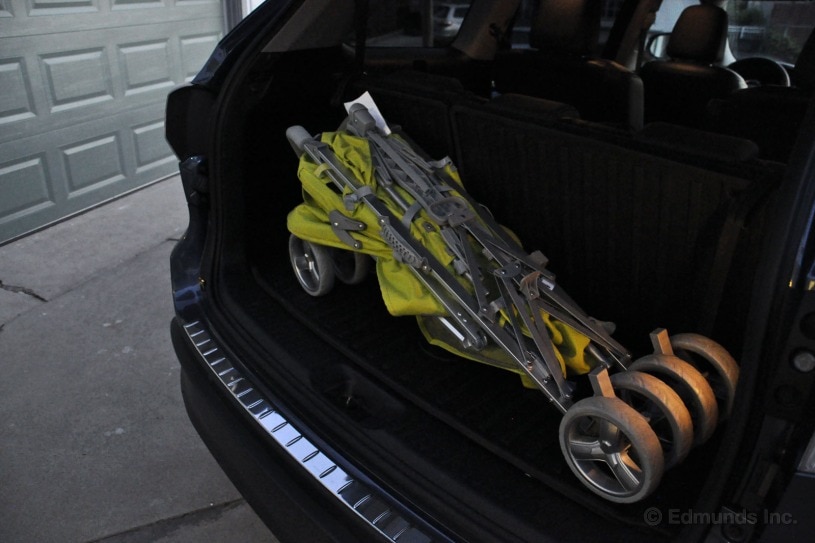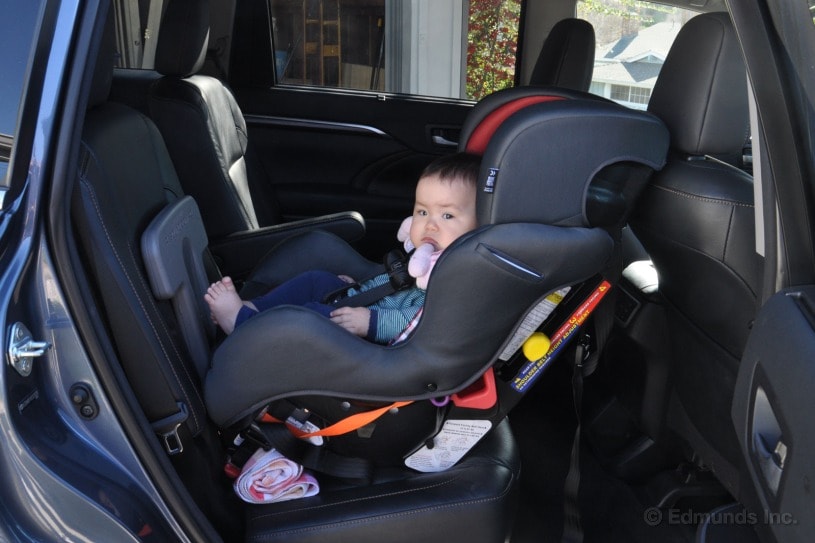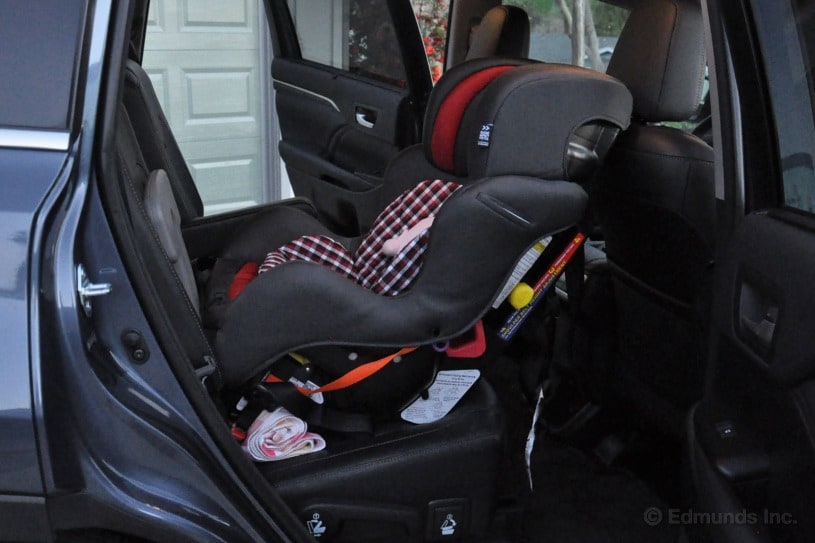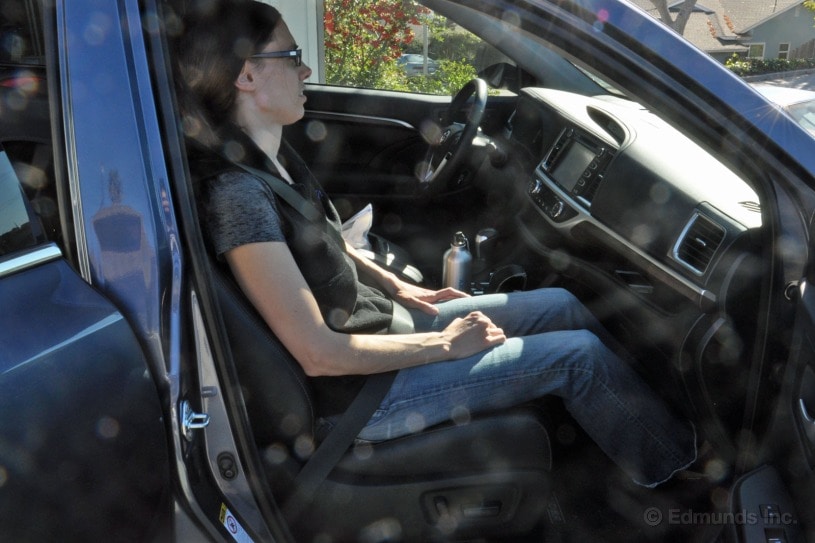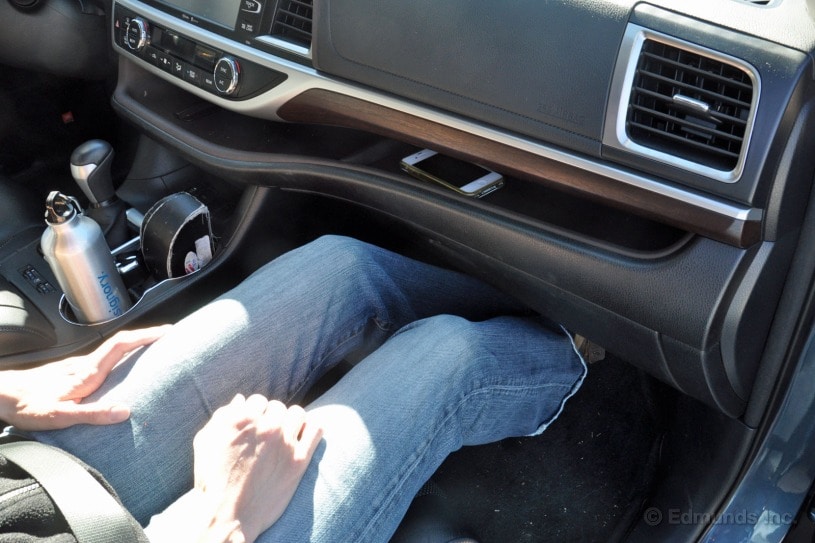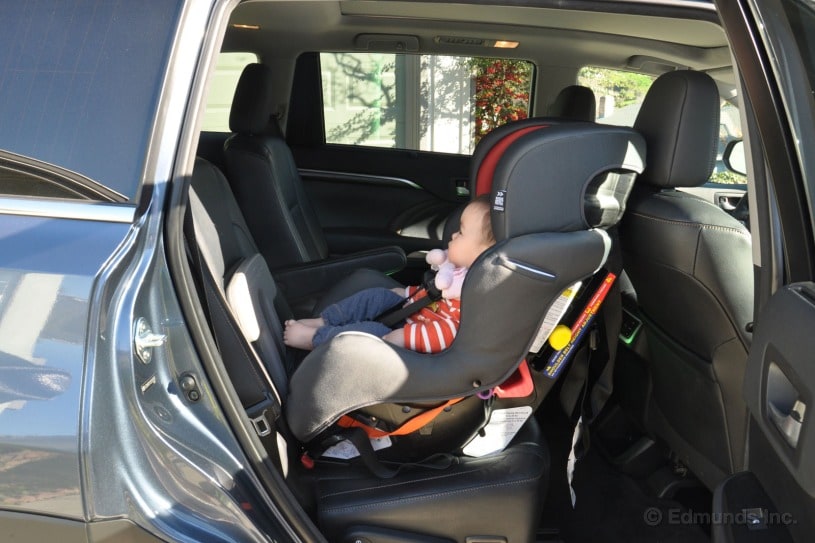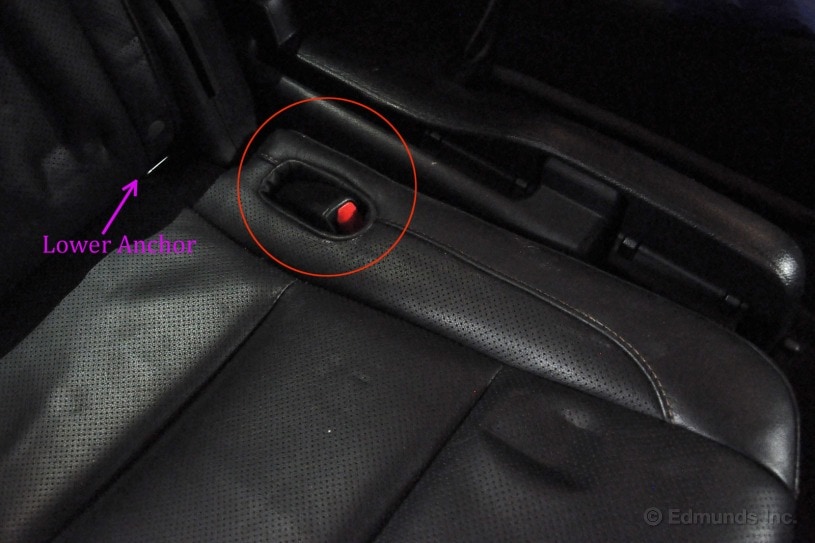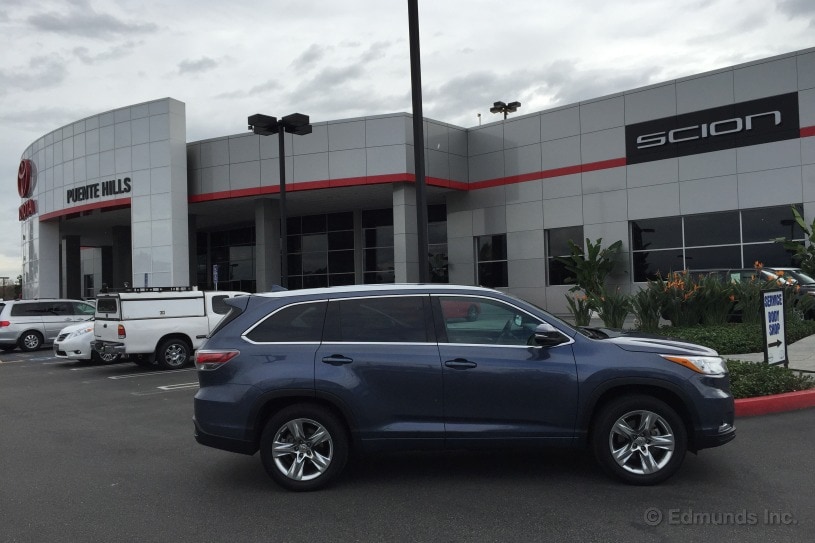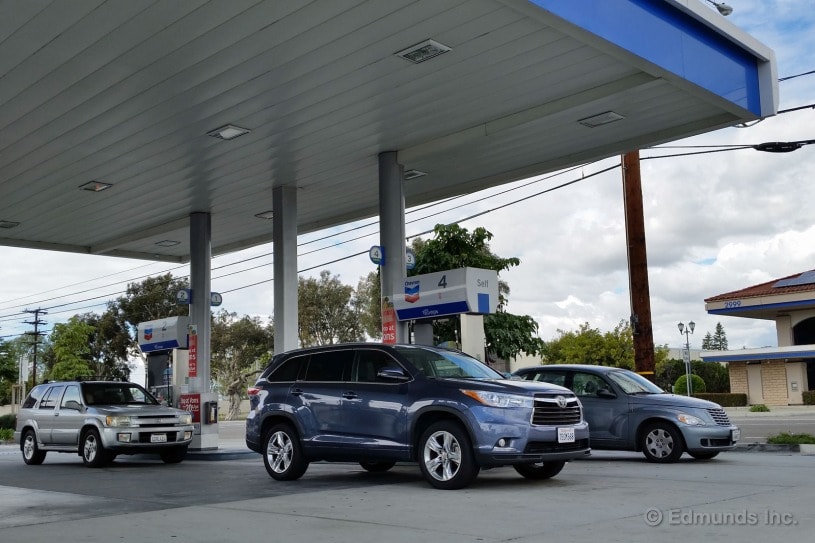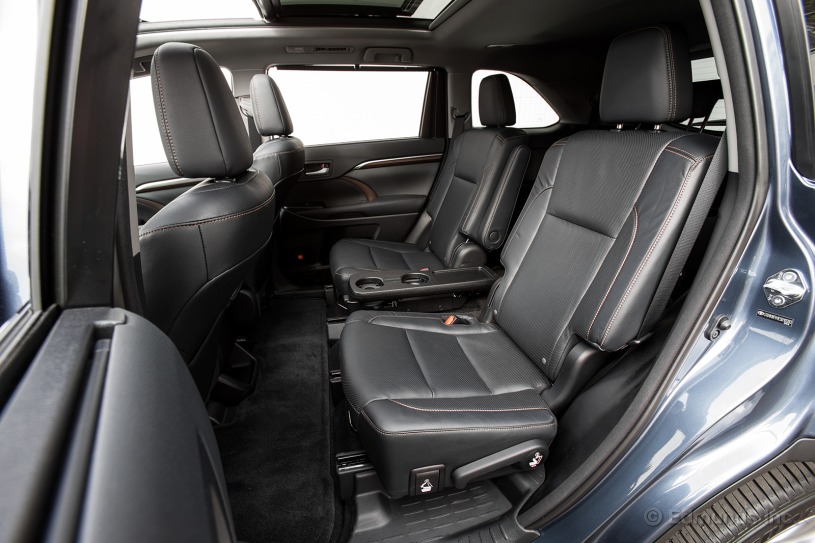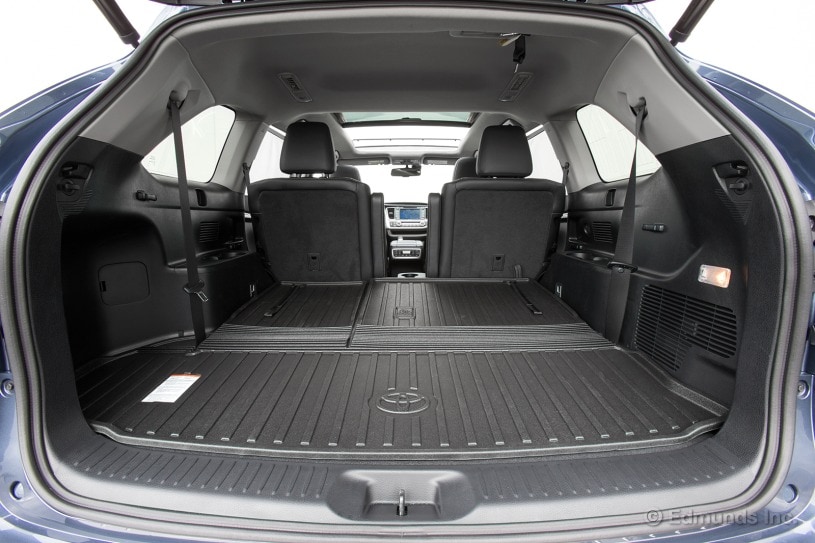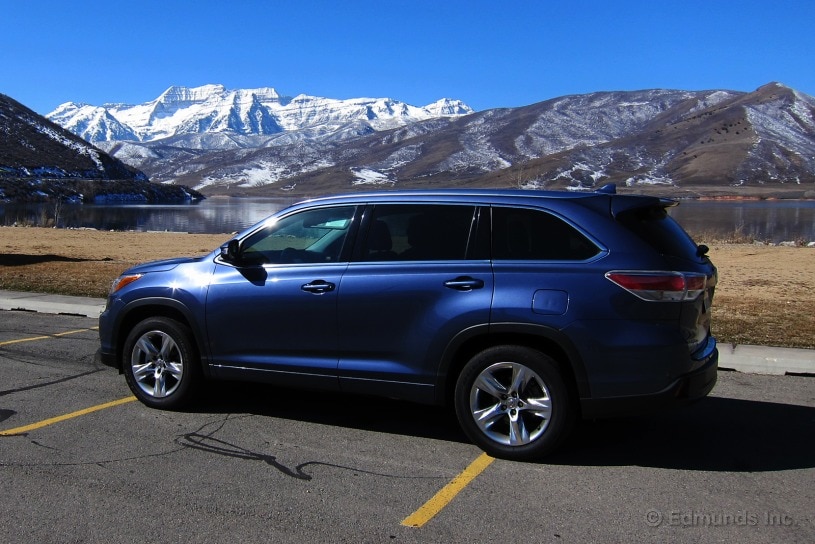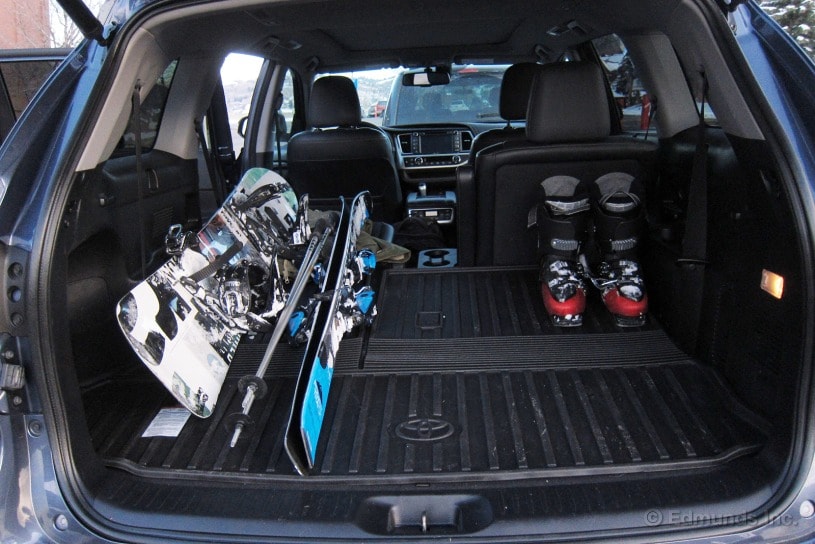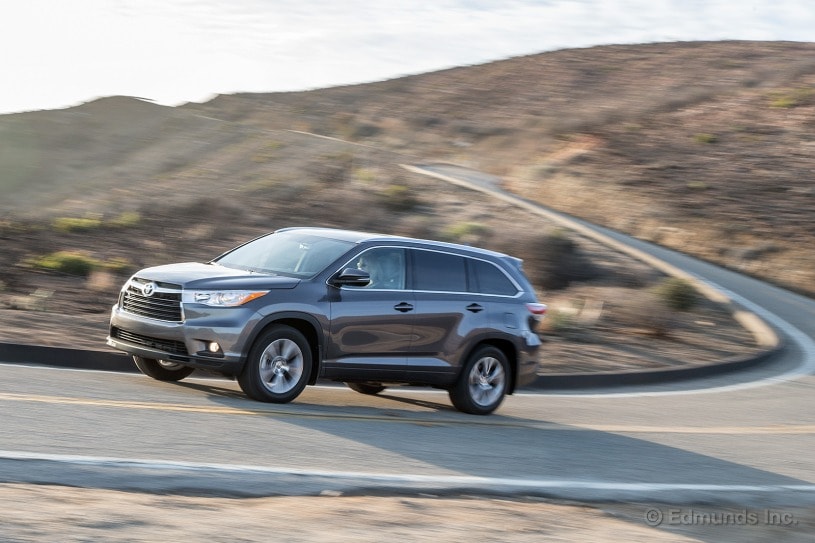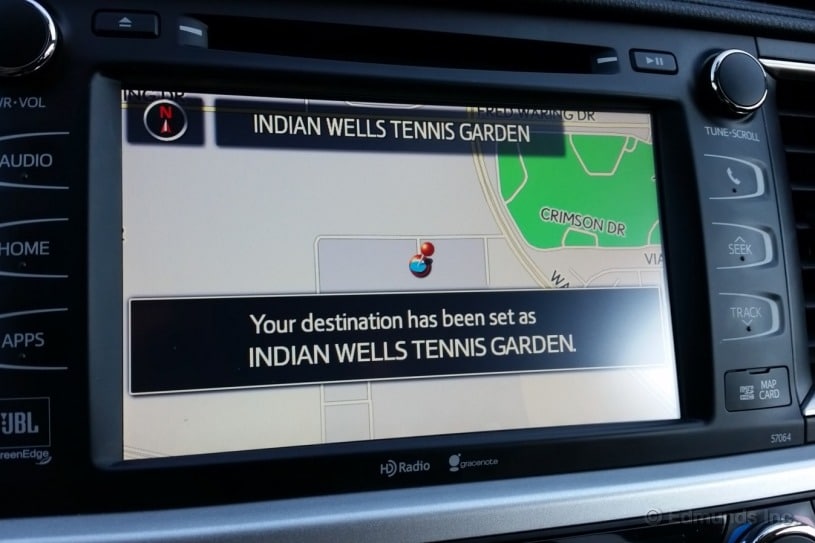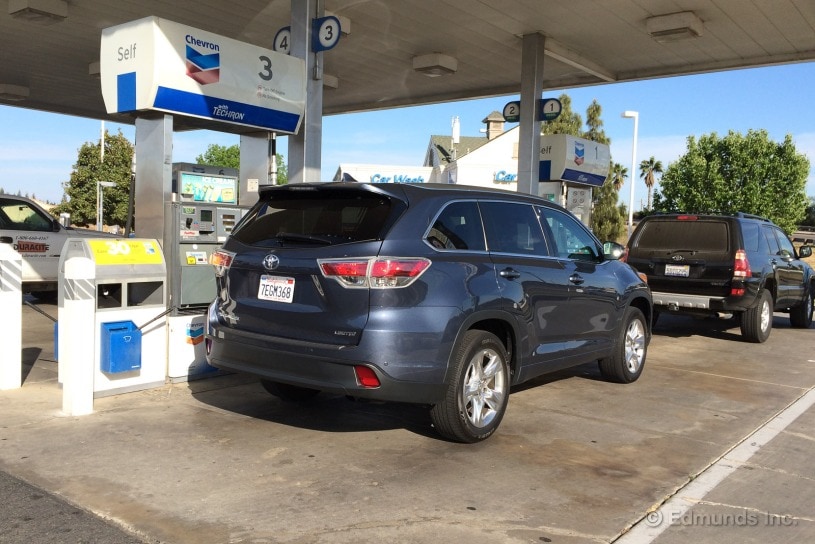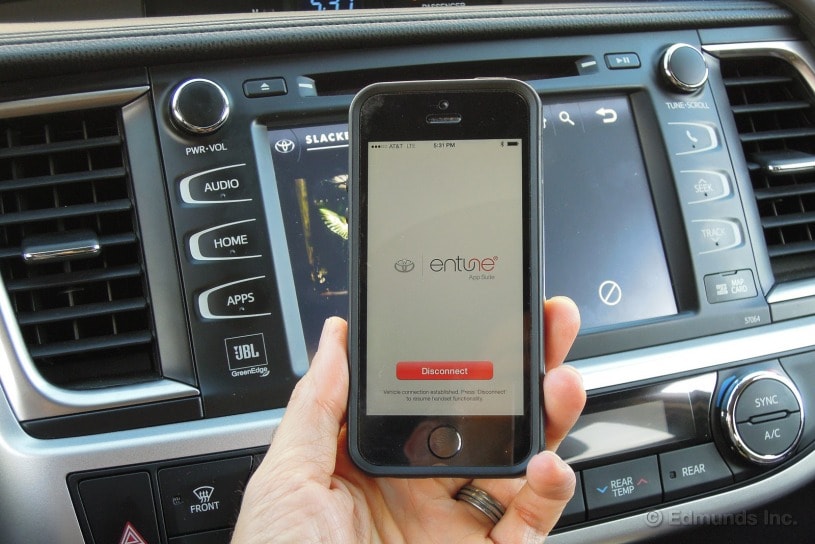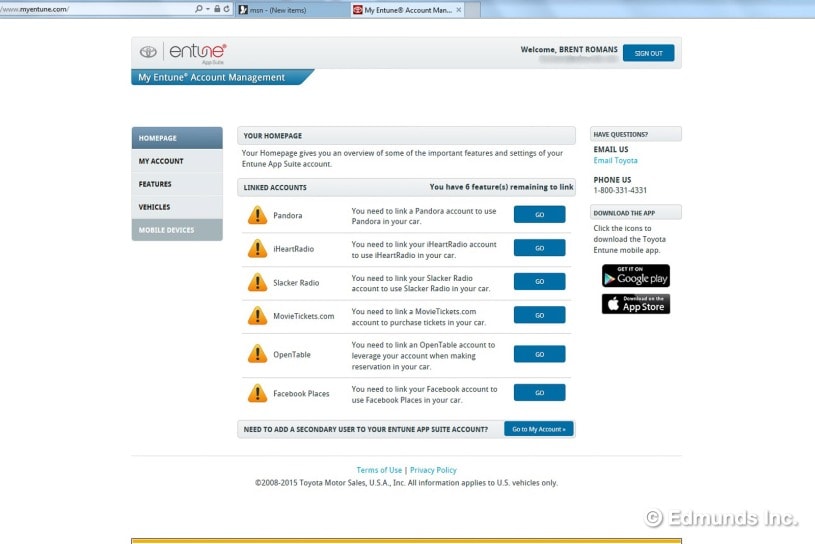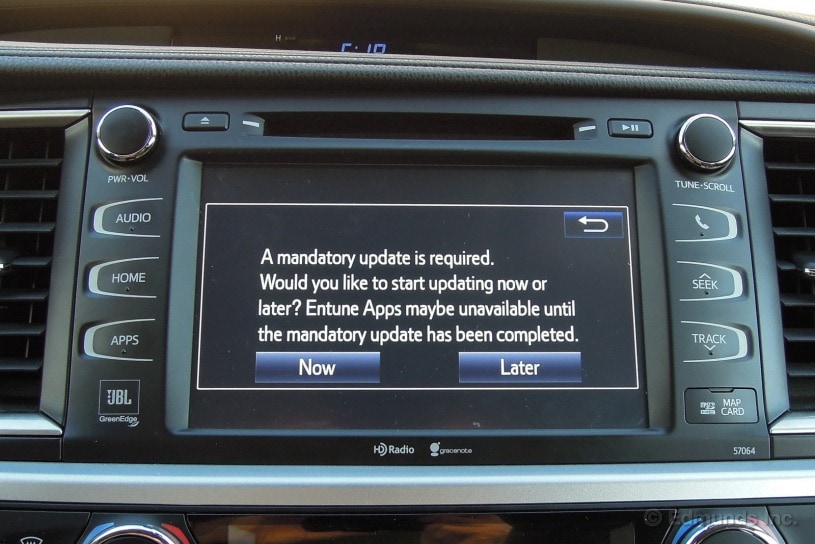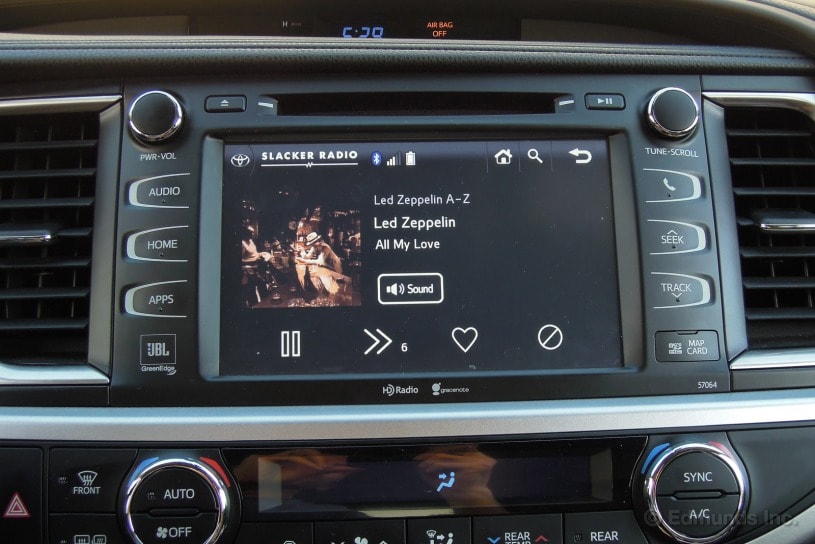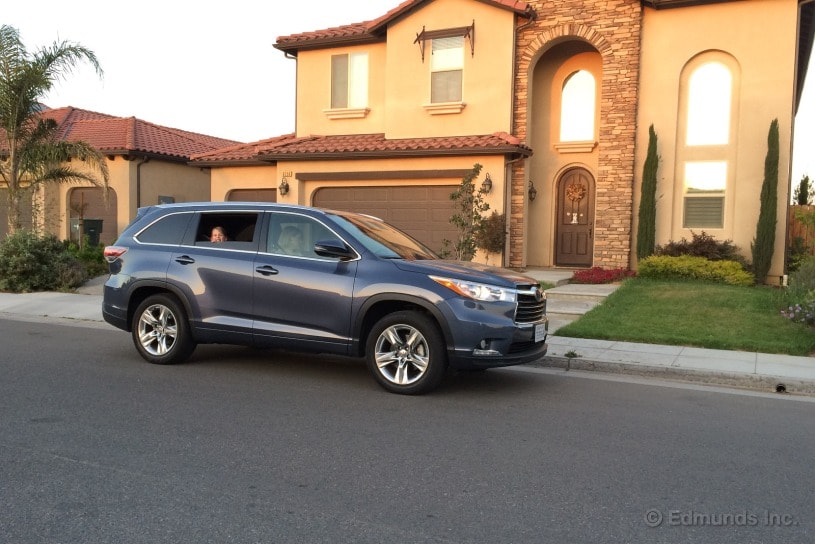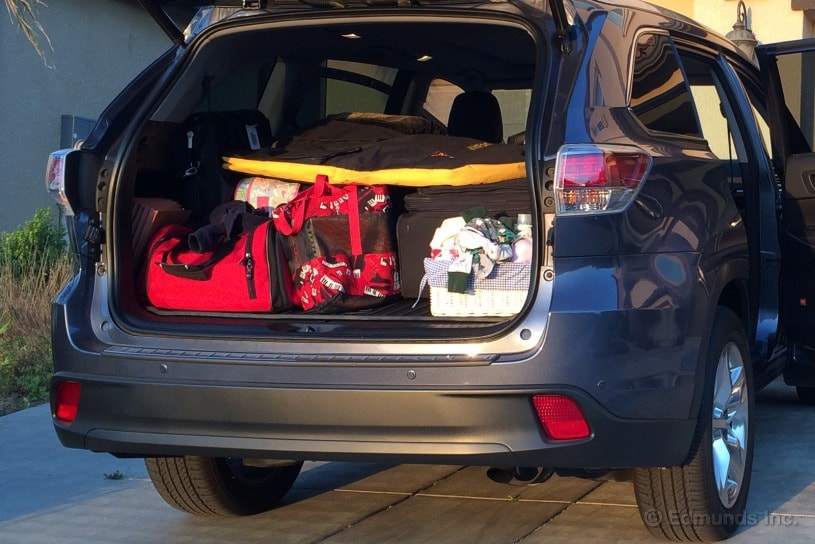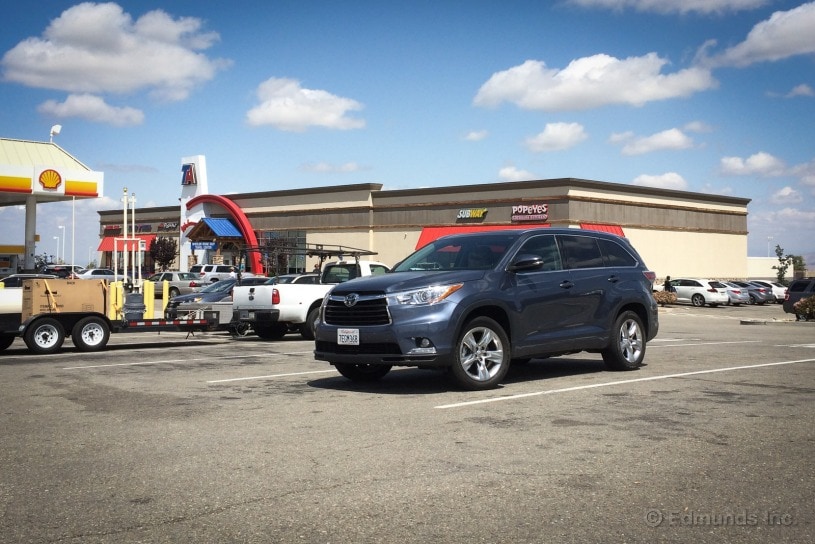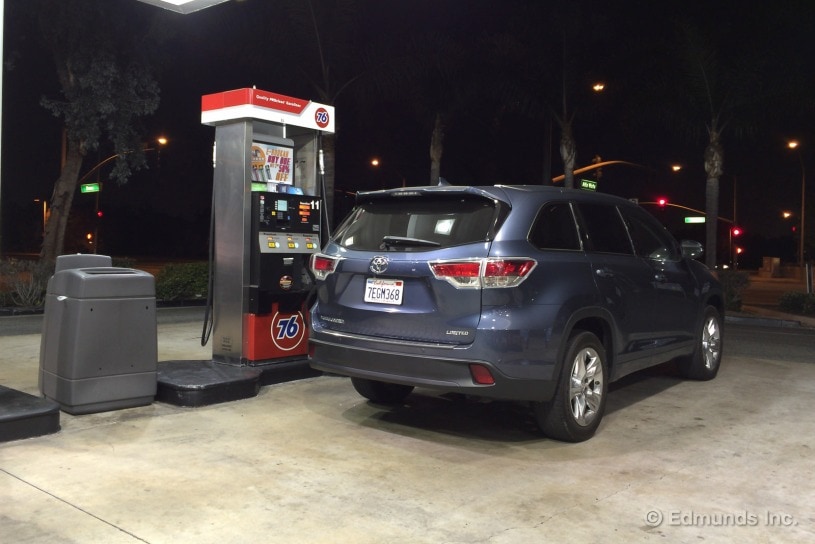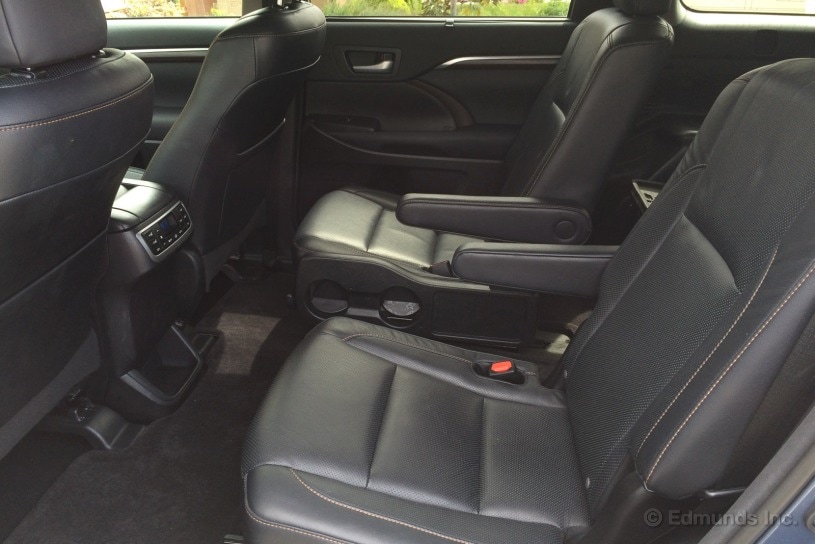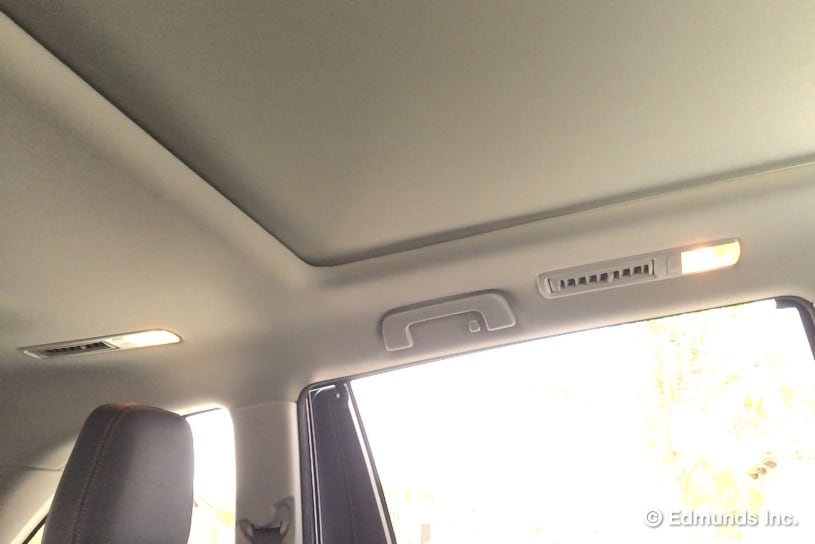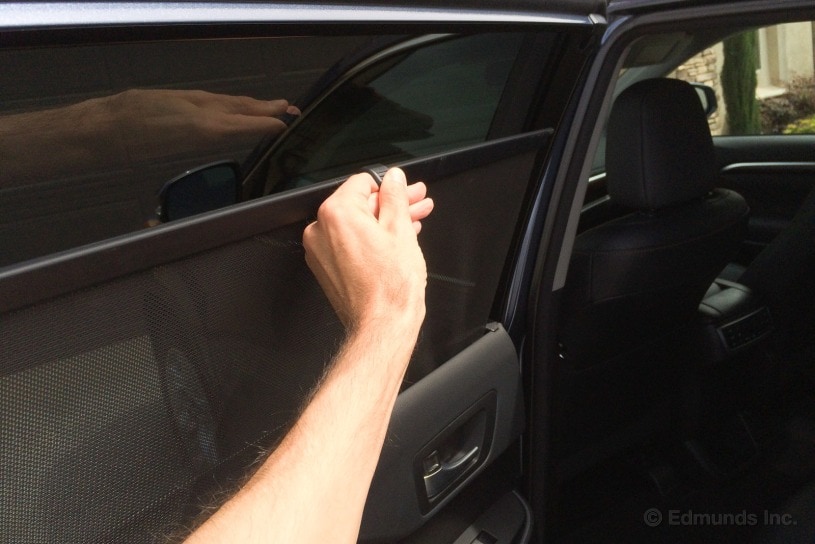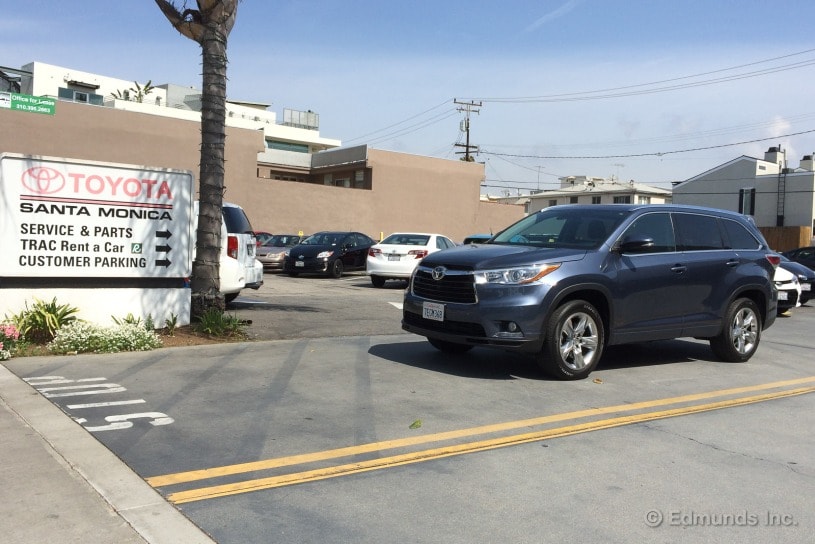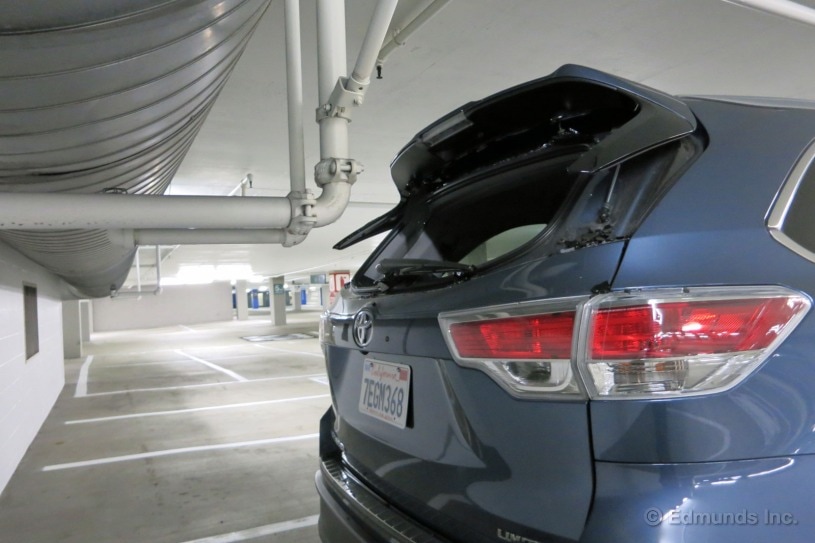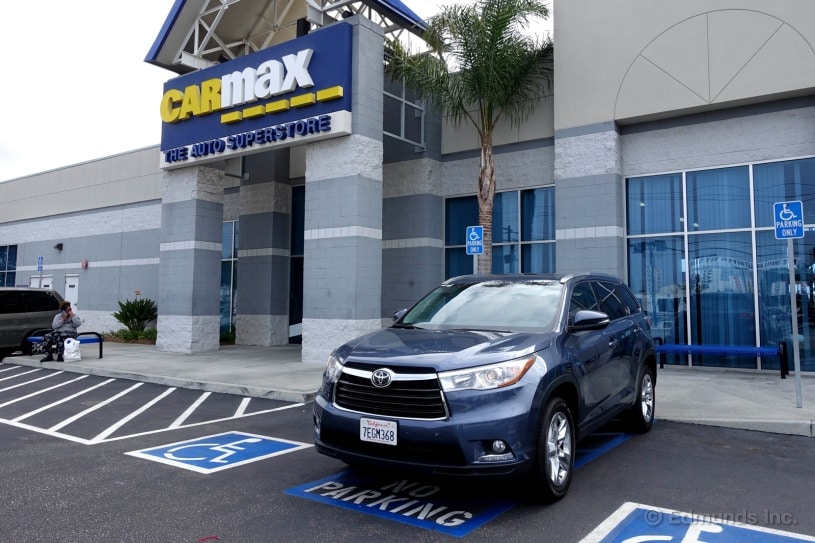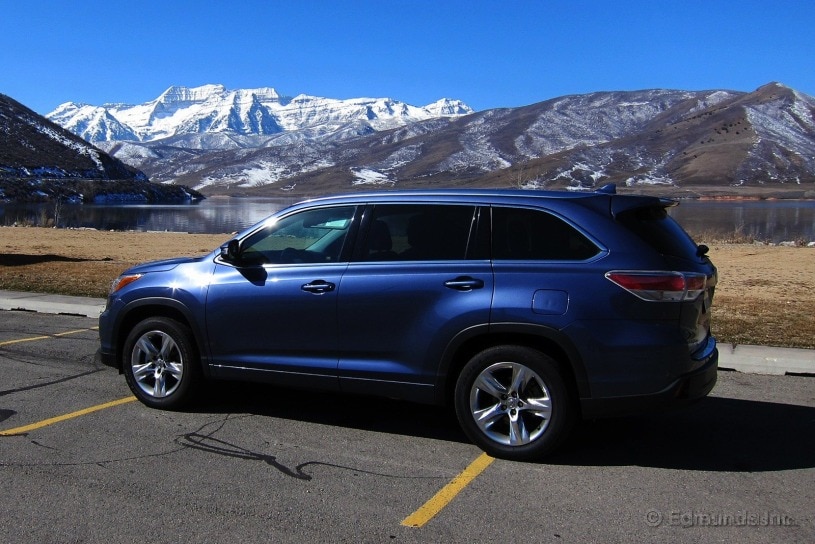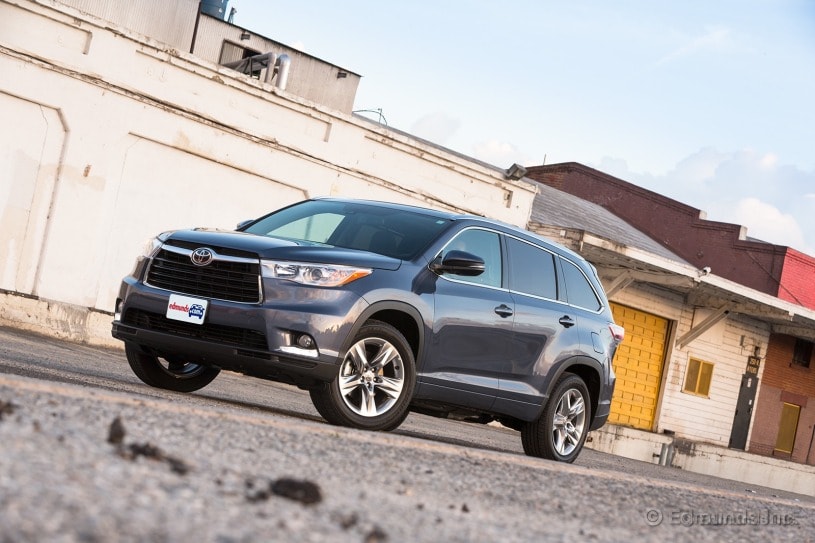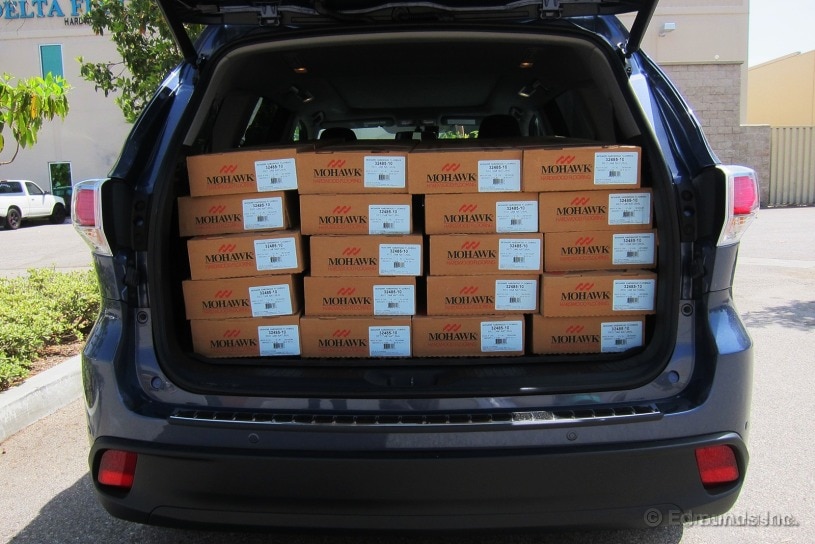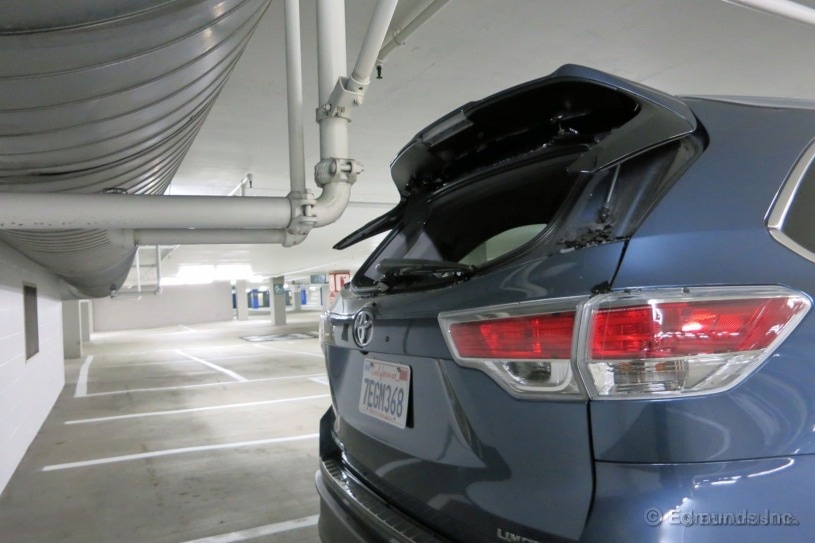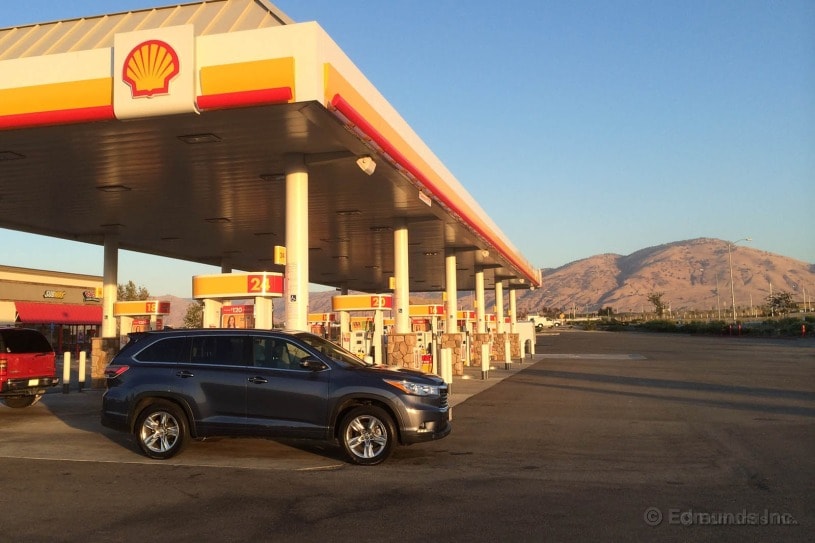2014 Toyota Highlander Limited: What's It Like to Live With?
Read daily updates on our long-term road test of the 2014 Toyota Highlander Limited and follow along as our editors live with this car for a year.
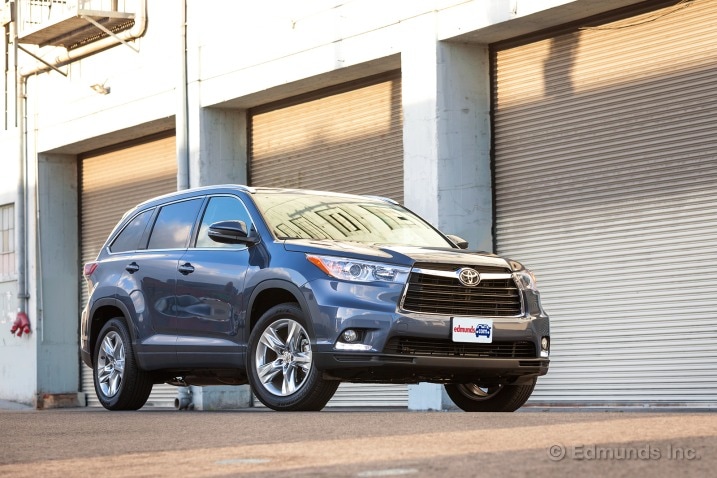
What do you want to know about?
- Introduction
- Shopping With Price Promise
- Radio Controls Not Ideally Placed
- Well Placed Dash Storage
- Campus Visit Road Trip
- Handy Interior Storage
- Induces Nostalgia For V6 RAV4
- Bluetooth
- Cargo Space
- Smooth, Easily Accessible Power
- Can It Run on Ethanol?
- Power Delivery and Torque Steer
- Maintenance Required
- Fuel Economy Update for April
- Iffy iPod Indexing
- 5,000-Mile Service
- 5,000-Mile Service Pick Up
- Sunlight Washes Out Navigation Screen
- Fuel Economy Update for May
- Maxing The Payload
- Massive Center Console
- Second-Row Cup Holder
- First Aid Kit
- Imprecise HVAC Knobs
- Getting Entune
- Fuel Economy Update for June
- My Hands Are Too Fat
- Great for Glamping
- Adaptive Cruise Control
- Beverage Bus
- Nice Dash Design
- Performance Testing
- Well Suited For Long Highway Drives
- Third-Row Seat Access and Comfort
- Using the Driver Easy Speak Feature
- Seat Belt Recall
- Fuel Economy Update for July
- Paradise Machine
- Cooled Seats Don't Cool
- Does the Cereal Box Fit?
- Well, This Is Awkward
- Maintenance Required Soon
- Dead at the Curb
- Fuel Economy Update for August
- Name That Window Squeak
- 10,000 Miles
- Party at the Park
- Caterer's Delight
- Fuel Economy Update for September
- Getting the Navigation Right
- Weekend MVP
- 10,000-Mile Service
- 2015 Pricing
- How Do You Interpret Crash Test Ratings?
- Cargo Liner
- Fuel Economy Update for October
- Rear Glass Opens
- More Fuel Range Than You Think
- Toy Hauler
- Fuel Economy Update for November
- Twist for Long-Haul Adventure
- Low Fuel Warning
- Long Seat Cushions
- Apple Cider Run
- Fuel Economy Update for December
- Lane Departure Alert
- 15,000 Milestone
- Oh, So That's Why Parents Buy These
- Fuel Economy Update for January
- Gigantic Rear-Facing Convertible Car Seat Fits With Room to Spare
- 15,000-Mile Service
- Fuel Economy Update for February
- DVD Player
- Cargo Bed
- Highlander Hits the Slopes
- Snow Gear Fits
- Freeway Brake Test
- Trip to Tennis Tourney
- Fuel Economy Update for March
- The 1.5-star Entune App
- Road Trip Number Eight
- Anti-Excitement On The Road to 20,000 Miles
- Thoughts On Six-Passenger Comfort
- Last Visit to the Dealer
- Why You Shouldn't Always Rely on Technology
- Sold to CarMax
- A Minivan for the Minivan-Averse
- Wrap-Up
Introduction
It may surprise you to learn which of our long-term test cars are consistently checked out first as the weekend approaches. Our sports cars are popular, but don't go first. Neither do the luxury cars.
In fact, our car-picking habits closely mirror those of the American car buyer. When push comes to shove, ample cargo space, three-row seating, a comfortable interior and everyday versatility win out every time. And with summer nearly upon us, we knew that another seven-seat road trip warrior would be a welcome addition.
The 2014 Toyota Highlander is one of the most shopped crossovers on Edmunds.com, which immediately put it on our radar. Add to that its laundry list of improvements over the 2013 model and it was clear that we had to add one to our long-term road test fleet.
What We Bought
The Toyota Highlander has been completely redesigned for 2014. The interior is markedly improved with higher-quality materials; a clean, modern layout; handy storage compartments; and available eight-passenger seating. On the powertrain side, the Highlander sticks with its four- and six-cylinder engines but swaps in a new six-speed automatic when you tick the box for the V6. Front-wheel drive and all-wheel drive continue to be available on V6 models except for the Highlander Hybrid, which comes in all-wheel-drive flavor only.
The 2014 Toyota Highlander comes nicely equipped in base LE trim, which starts at $30,075 and includes heated and power-folding outside mirrors, remote keyless entry, a 6.1-inch touchscreen radio and an integrated back-up camera. It's also saddled with a 2.7-liter four-cylinder, front-wheel drive and a five-speed automatic. A 270-horsepower, 3.5-liter V6 is available as an option here, and is standard across the rest of the Highlander line.
Stepping up to the $33,600 LE Plus adds an adjustable power liftgate, three-zone climate control, environmentally friendly synthetic leather seats and a leather-trimmed shift knob and steering wheel. Keep going and the XLE increases the price another $3,300, and adds leather seats, a power moonroof, Smart Key and a larger, more advanced infotainment system.
As with most of our long-term cars, we purchased a loaded 2014 Toyota Highlander so we could try out all the new features. The top trim Highlander Limited starts at $40,500 and adds a 12-speaker JBL audio system, perforated real leather seats, 19-inch wheels and a blind spot warning system.
We also wanted our Highlander Limited to have the Platinum package, a $2,400 add-on that combines the $1,400 Driver Technology package (subscription-based emergency assistance service, lane departure warning, pre-collision braking aid, radar-guided cruise control and automatic high-beam headlights) with a panoramic moonroof, heated steering wheel, and heated and perforated second-row captain's chairs. We also ticked boxes for a rear bumper protector ($129) and a Preferred Accessory package ($308), which includes carpet floor mats and cargo liner, a cargo net and a first aid kit.
Since our long-term Acura MDX, Hyundai Santa Fe and Nissan Rogue are equipped with all-wheel drive, we decided to switch it up and purchase a front-wheel-drive Highlander. AWD is great for people who need it, but we can get by without it. The system would have added $1,460 to the bottom line and dropped fuel economy by 1 mpg both in the city and on the highway.
All in, the window sticker for our 2014 Toyota Highlander Limited was $43,427. We located at least three Highlanders that met our specifications on our Web site. From there we anonymously used our Edmunds Price Promise® feature to get guaranteed quote certificates. Ultimately, we settled on a Shoreline Blue Pearl Highlander at Auto Nation of Irvine with its guaranteed price of $39,704.28.
Why We Bought It
The Highlander is the third best-selling midsize crossover on the market, and even with the optional V6 underhood (only 8.2 percent of Highlander buyers chose the four-cylinder last year), the Highlander remains Toyota's least expensive three-row SUV.
During a recent test, we were so impressed with the all-new Highlander that we gave it an "A" rating. The few demotions were for the hard-to-reach infotainment console and notable size increase compared to the 2013 model, and these were easy to overlook compared with what this crossover does so well.
After 12 months and 20,000 miles, will we remain enamored with its ability to effortlessly play taxi, or will we tire of its comfort-above-all driving dynamics? Will this front-wheel-drive Highlander be just as practical and desired as our AWD SUVs, or will the threat of weather restrict long road trips? Will the thousands of dollars of tech and safety goodies prove worthwhile, or just get in the way? Follow along on our Long-Term Road Test Page to find out.
Best MPG: 23.7
Worst MPG: 17
Average MPG over 1,289 miles: 22.3
Edmunds purchased this vehicle for the purpose of evaluation.
The long-term 2014 Toyota Highlander joined our fleet recently and also made some Edmunds history. It was the first vehicle we purchased with Edmunds Price Promisesm. Here's how it went down.
I was instructed to buy a 2014 Highlander Limited with the Driver Technology package and preferably a dark interior color. I searched the local inventory and started to notice a pattern.
Most of the Highlanders in the Limited trim didn't come with the Driver Technology package (automatic headlights, dynamic radar cruise control, lane departure alert and pre-collision system). Those that did came bundled with stuff we didn't want, like a rear seat Blu-ray disc entertainment package.
We decided to step up to the Limited with Platinum package (it's more of a trim level than a package, but that's what Toyota calls it). It costs $2,490 more than the Limited but included the Driver Technology package and added a panoramic moonroof and heated steering wheel. Not a bad deal.
I found three or four comparable vehicles that fit the bill and clicked the button to get a Price Promisesm quote. It didn't take long to find the clear winner. AutoNation Toyota in Irvine was offering the car for $39,704. This was $3,723 below the manufacturer's suggested retail price and $3,000 better than the other Price Promisesm offers I received. For reference, Edmunds TMV was $42,309 and the invoice was $39,608. We bought the Highlander for $100 over invoice without any negotiation.
We called up the sales department at AutoNation Toyota to verify that the Highlander was in stock and soon after we had an out-the-door price. It was that easy.
Irvine is about 56 miles from the Edmunds office, so we didn't ask the dealership to deliver the Highlander to us. We were fully prepared to make the cross-county drive, but Vanara Phuong, our Internet salesperson, offered to deliver the Highlander to our Santa Monica office. In fact, he and a colleague did so on their day off.
This was a smooth buying experience, overall. If you tend to stress out over the negotiation process or simply want to save some time, check out shopping with Price Promisesm. We think it's the way to go.
Apparently, Toyota didn't quite learn its lesson with the Tundra pickup. You might recall that when the big Tundra debuted in 2006, it had a pretty glaring issue with the design of its center stack.
It involved the tuning knob for the radio which was placed in the upper right hand corner of the navigation screen. By itself the placement isn't a problem, but combine it with a very broad dashboard that doesn't tilt toward the driver and that tuning knob becomes a very long reach away for the driver.
It's not quite as exaggerated in the Highlander, but it's still not ideal. I have relatively long arms and I have to stretch all the way out to reach the tuning knob when I'm in a comfortable seating position. Not a deal breaker by any means, but not a mistake I expected Toyota to make twice.
This is easily one of the best features in the new 2014 Toyota Highlander. It's just a plain old storage shelf, but its location in the middle of the dash makes it perfect for holding keys, a wallet or even the largest of cellphones.
That's clearly what Toyota designers had in mind since the shelf also features a well-placed pass-through opening that lets you plug in a phone without having the cord hanging out over the edge.
None of this is groundbreaking stuff, but it's a good example of how well-tailored this vehicle is for its intended audience. And even if you're not the intended audience it's a solid design that's had drawn widespread praise so far.
The timing couldn't have been better. My wife and I needed something spacious to take on a Spring Break road trip with our eldest daughter and her friend, and our brand-new 2014 Toyota Highlander long-term test vehicle arrived at the perfect moment. And Toyota's fairly simple break-in procedure, which lasts just 621 miles, was complete just before we were scheduled to load up and head north.
The girls have been accepted to colleges in Oregon. My daughter is about 90-percent sure she'll attend the University of Oregon this fall. Her friend has been accepted at Reed College in Portland but hasn't yet seen the state, let alone the city or the campus. The TV show Portlandia is her only reference point.
A side trip to visit my parents on the Oregon coast will make this a 2,500-mile journey when all is said and done.
For now, we've only just crossed the border on the first leg of our journey. But I can already tell the 2014 Toyota Highlander is much better suited to this trip than our 2013 Hyundai Santa Fe proved to be last fall on the very same roads in almost identical circumstances. The difference is night and day.
It's the ride.
This all-new Highlander is not as squishy as I expected. It expertly manages the weight of 4 adults (my daughter is now old enough to vote) and nine days' worth of luggage on the same slumped and wavy northwest roads that brought the Santa Fe, quite literally, to its knees. And by knees I mean bump stops.
We could ride in the Highlander all day — in fact we just did — with no complaints. As for the Hyundai, my family made it quite clear weeks ago that the Santa Fe was to be removed from consideration for this trip. For them, once was enough. Me, too.
It's as if the Hyundai was optimized for those times when the driver is commuting home from work solo, when the kids are at school. On the flipside of the coin, the Highlander may have felt a tad sharp when I drove it home alone before we began our Oregon quest. We'll have plenty of chances to sort this out after we get back and insert the Highlander into the regular rotation.
It's also the handling.
No, really. It's clearly not a sports car, but our new 2014 Highlander didn't go all wonky when the road climbed out of the valley and began to hug the snaking canyon walls of the mountains. It went where it was pointed and it felt confidently planted through the most awkwardly scribed turns. The body never seemed to roll overmuch and it easily shrugged off ripples and sinks that cropped up mid-corner with no ill effects.
Just now I came back alone from a hike, late for dinner. I was pushing more than I would with my passengers aboard and the Highlander stayed right there with me. I daresay it was even a bit engaging and fun. This is a Highlander?
And it's the interior.
The rear seat is not only spacious, it slides fore and aft a generous amount, and the seatback reclines. My daughter's friend stands six feet tall, not including hair, of which there is a lot. She fit quite comfortably back there.
Our front-drive Limited has seat heaters for all four of us and a heated steering wheel for the driver. Sunshades can be lifted up to cover the rear side windows. There's a flip-up console between the rear seats.
Front seat space is generous and the huge panoramic sunroof gave everyone a good view of the immense California Redwoods we passed through on a side trip.
We had no problem dealing with our luggage. I'm not certain how the capacity in cubic-feet stacks up, but our stuff fit easily with room to spare. And the split between the rear seats has made it easy for the girls to fish out strategically placed items like food and water while we roll down the road.
And the pop-up rear window within the hatch is a nice feature for those times when you just want to reach in quick to grab something sitting on top, like a rain jacket.
What's not so hot? I wish the telescopic steering wheel pulled back about an inch more, which would have enabled me to slide my seat back for a comfortable leg position. This issue is a bit of déjà vu for me. I have the same gripe about most other Toyota products.
Surprisingly, there seems to be a lot of wind noise as the air streams up the windshield and around the mirrors. It sounds as if there's a strong crosswind blowing even when the roadside trees and grass are standing utterly still. Road noise varies with the road surface. They use a lot of studded tires up here in winter. But the wind noise stands out above the fray on all but the coarsest surfaces. At least I brought an iPhone loaded with audiobooks.
We're not halfway through this journey just yet. More impressions to come later. The same goes for my daughter's impression of the U of O.
A car tends to accumulate lots of random stuff in the course of a long road trip, and our run to Reed College and the University of Oregon in our new 2014 Toyota Highlander long-term test vehicle is no exception.
Fortunately, the Highlander's design team has built in a few clever storage features, the most prominent of which is The Shelf.
The Shelf runs under the dash from a point just out of range of the driver's right knee to the passenger's door. It looks unobtrusive and somewhat stylish when empty, and the list of the things it can hold is long: keys, phones, those little travel size Kleenex packets, pens, pay-to-park receipts, iPhone cords (there's even a hatch in the bottom to thread the business end to the USB jack below), Starbucks gift cards, my wallet and those archaic paper foldy things called road maps.
The surface is slightly tacky so our junk doesn't scoot around much in corners. However, as Confuscious once said, "Pens and pencils are easy to roll. Deal with it."
The mood lighting you see above doesn't come on at night unless you shut off the engine or open the door. The idea is to remind you of the items you've stashed there so you don't walk off and leave something important behind.
It's not so deep that you lose things in the dim recesses and it's ridiculously easy to wipe clean when it gets grubby.
The Shelf gets a huge thumbs-up from me and my crew.
And then there's this roll-top center console box.
You can open the back part if that's all the access you need.
And then you can open the front part if you need a larger opening. The cavity inside is deep enough to swallow a purse or, in our case, leftover pizza. There's a removable shelf about halfway down and they've placed near the bottom in case you want to charge anything laying on said shelf.
Two cupholders sit in front of the console box, and the front and rear doors have map pockets with notches molded in to steady cans of soda, water bottles or the like.
Another two cupholders are built into this folding tray between the rear seats. It folds down and out of the way if you'd rather use the space for something else.
All of it works great, but I must say I'm a bigger fan of The Shelf than I thought I would be when I first laid eyes on it.
It would be inaccurate to call our 2014 Toyota Highlander overpowered. At around 4,350 pounds, the Highlander asks a lot of its 270-horsepower V6. But when you demand power, the 3.5-liter delivers with smooth, rich urgency. It kicks down a gear, a polite suggestion, really. Then it kicks down a second gear, sends a wave of torque steer through the column, and a jolting reminder that a two-ton object in motion tends to stay in motion, even with good brakes.
It's enough to make one nostalgic for the V6-powered RAV4. Now that car, which bowed out in 2012, was wonderfully oversauced at around 13 pounds per horsepower. You almost felt like you could shake loose the body panels if you just kept your foot in the V6 long enough. The Highlander by comparison feels like a freshly-cast ingot hurtling through a wax factory.
What remains to be seen is how this dopamine hit affects our long-term fuel economy.
When the boss calls, you answer. And with my cell phone paired to the Bluetooth in our long-term 2014 Toyota Highlander, there's no excuse to hide from Editor in Chief Scott Oldham.
Especially when the Highlander's large display features Scott's cheery photo.
Crossover shoppers may note that the 2014 Toyota Highlander's cargo capacity has been cut by nearly 12 cubic feet compared to the 2013 Highlander. The latest Highlander now offers a total 83.7 cubes.
But the good news is that the storage space behind the third row has expanded by nearly 3.5 cubic feet to 13.8 cubes. Even with all eight seats occupied, families will still have ample room to stow their gear in the far back.
Do you really need a V6 for a midsize crossover? Not always, but now that the 2014 Toyota Highlander has grown to truly gigantic proportions, it's worth the extra money.
That's probably why the 270-hp V6 is now standard on every trim level except the base LE. Good thing, too, as it's able to deliver the kind of low-end torque that gets it up to highway speeds even when there's a full load of kids and cargo on board. That's the kind of power you miss with a four-cylinder.
Reduced mileage is usually the big drawback, but even that's not as much of an issue as it used to be. Our front-wheel drive V6 is rated to deliver 21 mpg in combined driving while the four-cylinder model with the same setup only bumps that number to 22 mpg.
Factor in the smooth, responsive power of the V6 and it's definitely a worthwhile upgrade. If there's a drawback to the extra power, it's the fact that the Highlander tends to sit back on its haunches too much under full throttle. If that's the only price to pay, I'd say pay it.
Remember Ethanol? It was the hot alternative fuel there for a while not too long ago. GM even put yellow gas caps on all E85 capable vehicles to encourage people to uh..."go yellow."
Those drums aren't beating very hard anymore for various reasons, but there are still plenty of stations that serve up gasoline mixed with varying levels of ethanol. And there are still plenty of vehicles that are certified to burn both, but our Highlander isn't one of them.
As you can see, Toyota only recommends gas mixed with up to 15% Ethanol. It'll probably run on higher dosages, but doing so will likely void the warranty. Probably not worth whatever minor price difference there might be between ethanol blends and pure gas.
My esteemed colleague Mr. Dan "Hace" Frio touched on our long-term 2014 Toyota Highlander's power delivery and torque steer in an earlier post. I'd like to expound on his observations.
First, despite the Highlander's considerable mass, I too would still characterize its 3.5-liter V6 as gutsy, given one condition. And that condition pertains to the 6-speed automatic transmission. See, it is quick to select higher gears (almost assuredly for fuel economy and noise reasons), making the potent engine feel a bit short-breathed when subjected to little squeezes of the throttle.
But once it drops a gear or two, the true nature of the engine's thrust is revealed. And it is good. Toyota's corporate 2GR V6 has always been a really impressive performer. It's not the most aurally delightful thing in the world when you give it the beans, but there is surprising midrange grunt even when saddled with the Highlander. Plenty adequate thrust. More than you might expect, even.
The transmission's manual mode neatly circumvents the propensity of auto mode to select top gear at a moment's notice. There is, however, a noticeable pause between when you command a gear change and when said gear is delivered (and no rev-matching, which isn't really a surprise). Not the most responsive manual mode, then, but better than nothing.
And then there's the torque steer. Torque steer is far more pronounced in this Highlander than in other applications. You don't even need to give the throttle full whack to summon noticeable lane squirm. One the one hand, torque steer means torque, which is good. On the other hand, it's not the most confidence-inspiring trait in any car, and particularly so in the type of vehicle like this Highlander that's likely to be piloted by average Joes (read: non-enthusiasts). They're less likely to understand or accept behavior such as this.
Our long-term 2014 Toyota Highlander popped up the alert you see above upon startup the other day. There's no missing it, as the alert was accompanied by an audible chime.
Since our Highlander has just shy of 5,000 miles on the clock, this alert is giving us a heads up that it's almost time.
This was the first full month in the fleet for our 2014 Toyota Highlander. It started things out with a lengthy trip to Oregon followed by a few other highway-heavy weekends.
Not surprisingly, its mileage numbers came in slightly above its official EPA ratings. Not only did it deliver a best tank of 26.5 mpg on one leg, its overall average so far is 21.3 mpg. Oh, and 431 miles on a tank isn't bad either.
Expect to see its numbers smooth out in the coming months as our Highlander spends more time sitting in traffic and carting kids around town.
Worst Fill MPG: 17.0
Best Fill MPG: 26.5
Average Lifetime MPG: 21.3
EPA MPG Rating: 21 Combined (19 City/25 Highway)
Best Range: 431.3 miles
Current Odometer: 4.654 miles
I didn't download the silly Entune software for our long-term 2014 Toyota Highlander. I'm not going to. It's silly. I don't want Toyota telling my telephone what to do. So maybe this "problem" would be fixed that way. I don't know. I won't be the one to find out though.
The issue? Our Highlander is trying to play songs, artists and albums that aren't on my iPhone.
Check the photos. Both of these are sorted alphabetically by album. The iPhone shows Acoustic EP by Against Me!, (untitled on my phone for some reason) Album by Elijah Wyman, The Amazing Royal Crowns by The Amazing Royal Crowns and Bakenal by Mischief Brew. Now check the one the Toyota shows. Hmm, something's different. ABCDEFG. That's an album by Chumbawamba that isn't on my iPhone but IS in my iTunes library.
There are a number of other items indexed on the Toyota that are in my iTunes cloud (streaming of those is disabled) that just aren't on the phone. Thankfully, the car doesn't waste too much time trying to find these things and just skips over the item as soon as it can't be found. Still, the whole thing is very odd.
On the way to the office this morning, I delivered our 2014 Toyota Highlander to Toyota Santa Monica for regular service. I did not call ahead for an appointment, and there were three other vehicles already in the service drive when I pulled up.
It only took a minute for a service writer, Hollie, to introduce herself and write up the Highlander for an tire rotation and regular inspections. She asked if I wanted to wait while the service was completed, but since the Edmunds office is close by, I told her someone would be back later to pick it up.
The first service for our 2014 Toyota Highlander was a quick and painless one. Kelly dropped the SUV off in the morning for a tire rotation, fluid top-off and a few inspections. We were a little surprised to learn that while scheduled maintenance is set at 5,000-mile intervals, the Highlander only needs an oil change every 10,000 miles. Most of the cars in our long-term fleet get an oil change every time.
We received a call about an hour later, informing us that our people mover was ready to be picked up. It cost us nothing, thanks to Toyota's service program that covers maintenance costs for 25,000 miles or 2 years, whichever comes first.
The navigation system in our 2014 Toyota Highlander works great, as long as you can see it. Anytime there's direct sunlight streaming through the windshield, the navigation screen gets washed out to the point of uselessness.
It's a tough issue to crack for any manufacturer. If you bury the screen enough to shade it from the sun it can appear too far away to see clearly. Put it right out front like the Highlander and it's easy to see in terms of distance but far more susceptible to iffy lighting.
There must be some middle ground there that balances the two better than our Highlander, though, as I don't remember a screen getting washed out as often as it does in this Toyota.
Our long-term 2014 Toyota Highlander has been in our fleet for just over two months, but it's already cracked 5,500 miles. Most of those miles were driven during the month of April on long road trips, and with so much driving the Highlander required 12 stops at the gas station. The month of May was far less eventful, but we still recorded a new lowest-fill MPG.
That new worst fill mileage? 14.3 miles per gallon. With only five trips to the pump during May, the Highlander recorded a total of 17.3 mpg, bringing the lifetime MPG down from 21.3 to 20.5. Not to worry though, as this spacious crossover SUV has ten months left to recover.
Worst Fill MPG: 14.3 mpg
Best Fill MPG: 26.5 mpg
Average Lifetime MPG: 20.5 mpg
EPA MPG Rating: 21 Combined (19 City /25 Highway)
Best Range: 431.3 miles
Current Odometer: 5,534 miles
Our front-wheel-drive, Limited trim level 2014 Toyota Highlander is rated to handle 1,385 pounds of payload. That's not the Highlander's max rating, though. An LE model can handle an additional 70 pounds.
Thirty-seven boxes of hardwood flooring, each weighing about 40 pounds, exceeded the Highlander's rating by about 100 pounds. I thought it over. With some clever Tetris-ing, I could probably bring home all of the boxes. There was still plenty of room lengthwise behind the front seat backs and more room to reach the roof. Surely the extra 100 pounds wouldn't cause long-term harm to our Highlander's suspension or components. Surely the Highlander is capable of transporting five NFL linemen, right?
I erred on the side of caution. It required re-arranging (and lowering) the load and a second 60-mile round trip to the flooring vendor. But it meant that each load was well under payload rating and gave me a broader margin of safety for any evasive maneuvers. I felt like I'd cheated the Highlander out of an opportunity to prove itself. In fact, I'd probably just avoided an opportunity to prove myself an idiot.
Our 2014 Toyota Highlander has a massive center console. Seriously, this thing is big.
Small tablet computers, notebooks, whatever, they will fit. There's also a removable tray and a 12-volt outlet. The clamshell-style lid is functional, too. This is another example of Toyota recognizing how this vehicle will be used and designing accordingly.
If you haven't sat in the back of a 2014 Toyota Highlander then you can't fully appreciate the space and utility available there. One of the SUV's coolest second-row features is this flip-down cup holder/table.
The lever on the front of the table allows it to flip to this vertical position when not in use. There are also bottle holders in each rear door, but, hey, this is America, we can't have too many.
Our 2014 Toyota Highlander came with this first aid kit. It's a family car. Families need Band Aids.
But wait, there's more...
There are plenty of bandages in there, one for every sized cut. Also included are several wrap-style bandages, gauze, scissors, medical tape, sting-relief wipes, tweezers, a magnifying glass and of course a space blanket, to make you feel good as you become hypothermic.
Most of this stuff is absolutely useful, however. The kit resides in the Highlander's underfloor storage, but has Velcro on its backside which allows it stick to any carpeted surface as well.
Most of the interior pieces in our 2014 Toyota Highlander fit well and look decent. But the knobs controlling temperature for the dual-zone climate control could be better. They move laterally way too much and utterly lack precision.
Bottom line? Their sloppiness belies the rest of the interior's quality.
Scheduling is sometimes tough. I was asked to show a TV news program what's available for in-car apps. That week, we had a loaded Toyota Camry test vehicle so I planned on using that as an example. Schedules changed and the Camry was gone, but fortunately we still had our long-term 2014 Toyota Highlander.
The night before the cameraman showed up, I made sure to sign out the Highlander, but once I got in it my stomach sank.
There weren't any apps. My phone was connected and was running the Entune app, which is necessary to power the system. I tried and tried to find something. Anything.
Nothing.
Just as I pulled into my driveway, after I notified our in-house PR person that we might be outta luck, I saw an update button in the screen. After a few minutes of downloading and a few more to install, I was back in business. All the expected apps (Pandora, OpenTable, Movie Tickets, Yelp, etc.) were up and running. No need to sign in either, as the Entune app stores that information.
Personally, I only use Pandora on the road, but if I were in an unfamiliar city, I could see how Yelp and OpenTable could be useful.
After a few months in the fleet our 2014 Toyota Highlander is proving to be a popular vehicle for weekend errands as well as week-long road trips. With well over 6,000 miles on the odometer its overall mileage has dipped slightly, but is still solidly over 20 mpg in combined driving.
We've had no problems with it in terms of maintenance, and its functionality has been impressive at every turn. We expect that in a midsize family crossover like the Highlander, so it's been surprise-free thus far. We'll see how it handles the summer road trip season over the next couple of months.
Worst Fill MPG: 14.3
Best Fill MPG: 26.5
Average Lifetime MPG: 20.4
EPA MPG Rating: 21 Combined (19 City/25 Highway)
Best Range: 431.3 miles
Current Odometer: 6,684 miles
I have big hands. Not long, just...pudgy. I don't think the 2014 Toyota Highlander was made for people with fat hands. At least the front shelf storage area isn't.
Don't get me wrong, I'm actually glad the shelf is there. Right below the navigation display and HVAC controls is a fantastic little storage space, which is a great place to store stuff that you may want to grab easily when you leave the car. It's especially useful for a person like me who hates to have his wallet in his back pocket while driving.
The shelf seems perfectly made to hold a wallet, cell phone, and whatever other little items I'd take along with me. Instead of rooting around in my overstuffed center console, the things I need are front and center.
There is even a thoughtful opening in the shelf to allow a USB cord to be threaded down to the port below. That's where the problem is for me. I can hardly fit my hand in the space below the shelf to plug in the USB cable. My hand can actually fit but being able to manipulate my fingers in the confined space is a challenge. To add a little spice to the challenge, I couldn't see into that little space once my hand was in there. It took a bit of wrangling, but I finally got it hooked in. I wouldn't have been able to do it while driving for sure.
I asked a friend to try to plug in her iPhone cord, and she had the same problem, even with her dainty hands. Her problem wasn't that her hand was too large for the space, but the port is placed in such a way that a hand trying to connect to it will likely block the view of the operation.
I suppose this isn't something a driver would do on a regular basis, unless switching from an Android cord to an iPhone cord needed to happen, as was the case with me over the weekend. Using the under-shelf socket is a bit of a hassle, but a small price for the super convenient shelf.
Last weekend the Oldhams packed up the Edmunds long-term 2014 Toyota Highlander and we went glamping.
That's glamping with a gl. As in glam camping. It's how the modern urbanite roughs it. And it's kinda become a thing.
Our glamp of choice was the Auto Camp in Santa Barbara, California, about 120 miles north of our Santa Monica office. I've always wanted to sleep in an old Airstream trailer, and this was my chance.
Unlike most glamps, there are no tents at the Auto Camp. No tents. No sleeping bags. The entire hotel is made up of five nicely restored and fairly modernized old Airsteams ranging from a 1959 Overlander to a 1972 Sovereign. I booked Airstream #4, a 26-foot 1962 Overlander that sleeps four and features a full bath with a stand-up shower.
Situated in the shade of a 100-year-old oak tree, #4 featured all the modern conveniences of home including a microwave, a Mr. Coffee and two bikes. It's not exactly the famous Santa Barbara Biltmore, which is just a mile or so away, but it's definitely more glam than a tent in a KOA.
And so we drove our four-month-old Highlander to our 52-year-old Overlander. And it was the perfect vehicle for the trip. The Toyota proved to be extremely comfortable for the four of us, and its cargo area swallowed our blatant over-packing with ease. We also made full and frequent use of its power tailgate, and I found its navigation system to be easy to program and very accurate in its directions.
Although my kids appreciated the Highlander's rear air conditioning controls and its heated captain's chairs, the heated driver's seat was a bit too weak for me, even on its highest of three settings. Come on, Toyota, I wanna feel the burn.
I did, however, very much like the Sport setting on the crossover's six-speed automatic transmission, as well as its manual shift gate. Both make it easy to ring out all 270 horsepower from our Toyota's big V6. At the expense of fuel economy, of course.
But hey, when you're living the glam lifestyle, what are a few miles per gallon among friends.
Our 2014 Toyota Highlander is equipped with the Driver Technology package. It's a $1,400 option that includes lane departure warning, pre-collision braking assistance, automatic high-beams, subscription-based emergency services and radar-guided cruise control. I've driven numerous examples of adaptive cruise from various manufacturers, and I have to say, the Highlander does it well.
Perhaps the best example of adaptive cruise control, in my experience, is in the current Mercedes-Benz S-Class. It offers multiple distance settings and its application is instant and gradual. The moment a slower vehicle enters its path, the system adjusts speed. It is ever so slight and unobtrusive. Acceleration back to the target speed is also instant, yet gradual. To me, this is the benchmark. And to me, our Highlander is only a couple of steps behind.
Like the Mercedes, our Toyota offers multiple distance settings. If there was a knock against it here, it's that the settings are too extreme. At the closest range you get about 4 car lengths. The next-closest stretches that to 8 car lengths. A setting somewhere in between would be ideal.
As for the adaptive cruise, I like its execution. Activation of the system leans to the conservative side. Unlike the S-Class, there is a slight delay between the time an object enters the radar-zone and the Highlander reacts. This delay is nice because it avoids the touchy, oversensitive characteristic of some lesser systems. When the brakes do engage, they do so smoothly. Similarly, the cruise resumes its programmed speeds slowly once the object leaves its path. This is welcome in low-traffic situations. In some higher traffic scenarios, especially when motorists continually change lanes in front of you, I found it less annoying to just disable the system.
Another notable aspect of the system is the location of the cruise engagement stalk. It might not seem significant. But I like where it's tucked behind the wheel on the lower-right side. Push the button to toggle it on and off and click down to engage. Simple. The location of the cruise distance button is conveniently placed on the wheel near the stalk. On the whole, I think this is one of the better systems out there.
A friend told me he recently moved into product planning at a major automaker. He comes from the engineering corps, but apparently you can't wait for old engineers to peel off into retirement if you want to rise in that department. Not if you want a steadily rising paycheck, anyway.
Product planning sounds like a tough gig. You have to manage minutiae and sweat mind-numbing details. If you work for one of the Asian automakers, you have trans-Pacific conference calls at 10:00 p.m. I told my friend that in his new position of influence, he must not forget cupholders. Americans love cupholders, I reminded him, especially wide ones like those in our 2014 Toyota Highlander. These cavities are massive, wide enough for a 40-ounce Klean Kanteen with a roughly 3.5-inch diameter.
Finding these in the Highlander is a bit of a surprise, though. This isn't a car that necessarily plays to the adventure lifestyle customer, the ones who regularly tote cans of this size. Little too big and bulky. Or maybe, rather, it's a perfectly pitched product plan, aimed at the both the yoga moms and their polycarbonate water jugs and the wholesale Starbucks drinker.
When writing about cars for a living, one of the things you have to guard against is falling down the enthusiast well. We all have an idea of what makes an enthusiast. He or she is the car expert in their social circle, the one who subscribes to the magazines, reads the Web sites, follows new models and commits 0-60 times to memory. It's tempting to write for this reader because you don't have to explain as much.
It's easy to forget that a lot of people who don't internalize horsepower ratings are still enthusiastic about cars. And it's instructive, to me anyway, to observe what enthuses them. A friend and I took a ride in the 2014 Toyota Highlander recently and he was immediately impressed by the dash and instrument panel. Clean, symmetrical lines and a good look, he said. I hadn't even noticed until he mentioned it. He also found the undertray, its space lighting and the cable pass-through thoughtful touches.
My friend is a car guy in his own way. He's got a non-running Mustang of some 1960s origin in his garage. In his driveway there's a Chevy truck, a Mazda Protégé and a barely-running Fiero. He's not reading car magazines every month, but he likes burnouts, utility and, obviously, weirdness. And he likes a well-executed interior design feature that I'd only vaguely registered. In my defense, I was preoccupied with the cupholders.
One of the highlights of our very nice 2014 Toyota Highlander it its 270-horsepower, 3.5-liter V6 engine. Without really trying, it's almost too easy to bang the go-pedal, have the automatic kick down a few gears and spin a few dozen miles worth of rubber off of the front wheels.
But what happens when you take a more grownup approach to see what the limits on this Highlander actually are? And how does it stack up against a 2014 Toyota Highlander XLE with all-wheel drive we tested previously?
| Highlander Limited | Highlander XLE AWD | |
| Curbweight as tested: | 4,511 | 4,487 |
| 0-30 (sec.): | 3.0 | 2.7 |
| 0-45 (sec.): | 5.0 | 4.7 |
| 0-60 (sec.): | 7.6 | 7.3 |
| 0-60 with 1-ft Rollout (sec.): | 7.3 | 7.1 |
| 0-75 (sec.): | 11.0 | 10.8 |
| 1/4-mile (sec @ mph): | 15.6 @ 90.7 | 15.4 @ 91.0 |
| Skid Pad Lateral Accel (g): | 0.80 | 0.79 |
| Slalom: | 61.1 | 59.7 |
Vehicle: 2014 Toyota Highlander Limited
Odometer: 4,129 Date: 4/22/2014
Driver: Mike Monticello
Price: $43,427
Specifications:
Drive Type: Front engine, Front-wheel drive
Transmission Type: 6-speed automatic
Engine Type: Naturally aspirated V6
Displacement (cc/cu-in): 3,456/211
Redline (rpm): 6,400
Horsepower (hp @ rpm): 270 @ 6,200
Torque (lb-ft @ rpm): 248 @ 4,700
Brake Type (front): Ventilated disc
Brake Type (rear): Disc
Suspension Type (front): MacPherson strut
Suspension Type (rear): Double Wishbone
Tire Size (front): 245/55R19 103T M+S
Tire Size (rear): 245/55R19 103T M+S
Tire Brand: Bridgestone Tire Model: Dueler H/L 422 Eco P1A
Tire Type: Low Rolling Resistance
As tested Curb Weight (lb): 4,397
Test Results:
Acceleration
0-30 (sec): 3.0 (3.0 w/TC on)
0-45 (sec): 5.0 (5.1 w/TC on)
0-60 (sec): 7.6 (7.8w/TC on)
0-60 with 1-ft Rollout (sec): 7.3 (7.4 w/TC)
0-75 (sec): 11.0 (5.3 w/TC on)
1/4-Mile (sec @ mph): 15.6 @ 90.7 (15.7 @ 89.4 w/TC on)
Braking
30-0 (ft): 30
60-0 (ft): 122
Handling
Slalom (mph): 61.1 (60.6 w/ESC on)
Skid Pad Lateral acceleration (g): 0.76 (0.80 w/ESC on)
RPM @ 70: 2,000
Comments:
Acceleration comments: This V6 is sweet and smooth with decent power seemingly everywhere on the tach. Upshifts are supple but not overly quick. This front-drive model was considerably harder to launch than the AWD example we tested previously. The Highlander has more than enough power to spin the front tires, and it took careful application to get just the right amount of wheelspin. Quite often it would spin the front tires so much that it would upshift early, and then promptly bog in second gear, ruining any shot at a good time. Going straight from brake to full throttle, or power braking (overlapping throttle and brake prior to launch) to full throttle, would just light up the front tires. The quickest time was achieved by feeding in slightly less than full throttle when launching the Highlander down the drag strip. Manual shifting is via the center console lever (pull back for downshifts), but it still upshifts for itself at 6,000 rpm just like it does in Drive. It does not blip the throttle on manual downshifts.
Braking comments: Moderate to spongy pedal feel. There's a decent amount of nosedive here which causes some rear lockup and slight side-to-side squirming. Oddly, this Highlander didn't stop as short as the AWD model we tested previously. The first stop was 126 feet. The second stop was the shortest at 122 feet and the fifth and final stop was the longest at 129 feet. Lots of brake odor by the time we were done.
Handling comments:
SLALOM: Steering is on the slow side but intuitive. The suspension is soft with plenty of body roll but the Highlander stayed composed, with the occasional stability control slam-on-the-brakes freak out if I pushed too hard.
SKIDPAD: Here's another case of the machine working better than the man (darn it!). We got a considerably better lateral g number with stability control fully on than with it off. With the traction control turned off, and without a limited-slip front differential, and also because of considerable body roll, the outside front tire wanted to spin up anytime you dialed a bit more power in as you drove around the circle.
It's summertime. It's time to pack up your family and head out for the Great American Road Trip to Wally World. But what are you going to drive? "A Tesla Model S!" you might say, having gained inspiration from our record-setting LA-to-NYC drive (and back).
The more practical and obvious choice, though, would be something like our 2014 Toyota Highlander.
I haven't yet taken an exhaustive trip like that in our Highlander. (In fact, fellow editor Dan Edmunds, who also did the Tesla drive, drove our Highlander to Oregon earlier this year.) But I did do a recent six-hour highway stint in our Highlander and came away pretty impressed. Of course, there's a good amount of room inside for a family of four and their luggage. The driver seat is very comfortable for multiple hours, and there's a lot of storage for your personal effects, such as the big center console bin and the (more controversial) dashboard storage tray.
Even more impressive in my opinion is the way the new Highlander drives. It's stable and secure on the highway in a way that you may not expect from a Toyota SUV. The ride quality is smooth, certainly, even with our Platinum trim's 19-inch wheels. But this softness doesn't translate into the vehicle wallowing over bumps and dips. Hit some undulations and the Highlander stays composed. The steering is direct, too. You just point and the Highlander obediently follows.
I'm less sure of how the Highlander fares in regards to quietness. There seemed to be a fair amount of wind noise on my drive coming from around the side mirrors, or at least more than I expected. This is something that Dan also noted on his Oregon trip update. However, in our official Edmunds testing, the Highlander posted a very quiet decibel reading at highway speeds. So I'm not sure what to think, honestly.
Overall, though, our Highlander is a very impressive long-distance companion.
The 2014 Toyota Highlander comes standard with a third-row seat, giving it either a seven-passenger or eight-passenger capacity depending on whether you've got the captain's chairs (like ours) or the second-row bench. So maybe you've got to take your spouse, your two kids and your in-laws out to dinner at The Cheesecake Factory. How's the Highlander going to do?
Pretty well, I think. There are two levers to slide the second-row seat forward (the one on the seat back is the one in the photo). Both are clearly marked, and sliding the seat forward is pretty easy. Going all the way forward provides a decent space to step through (more than the last Highlander). With the captain's chairs like our Highlander has, you can also just step between them.
The third-row seat's legroom and headroom are certainly suitable for children or young teens. The seatback also reclines and has adjustable head restraints. Amenities include two cupholders and an overhead air vent for each outboard position.
If you're putting your kids' grandparents back there, though, it might be a little more problematic. I'm 5-foot-10-inches tall, and my head rubs up against the headliner. I have to tilt my head a little to fit. There is enough legroom for me, though. That legroom is partially influenced by where you position the second-row seat. But I set both the first and second row seats for normal adult comfort and still had enough legroom in the third row. Of course, it's not exactly comfortable, as the low-mounted seat has my legs and knees angled up. Also, while it's technically a three-person seat, you're never going to want to put three teens or adults back there.
Some larger three-row crossovers like the Chevrolet Traverse or the Ford Flex are going to give you a little more third-row space. But realistically the Highlander will have most family life situations covered.
If you're a parent with more than one kid, there has probably been a time when you've been driving and needed to yell at your little miscreants in back. You've likely said things like, "Bobby, stop touching your sister." "Jackie, for the tenth time, stop kicking my seat." "If you guys can't get along I'm just going to turn around right now."
With the 2014 Toyota Highlander, Toyota is hoping to make this a little easier with the Driver Easy Speak feature.
This is not to be confused with a Driver Speakeasy, which sounds like a theoretical place I'd like to visit someday. Instead, it's essentially an in-car intercom system that allows the driver to more easily communicate with passengers seated in back.
You activate it by pressing a touchscreen menu button. Once done, the driver seat microphone — the one used for Bluetooth phone calls and such — is used to pick up the driver's voice, and then said voice is piped back to be broadcast over the Highlander's rear speakers. The volume of the system can also be adjusted through the touchscreen.
Alas, if you're thinking this is some sort of voice-of-God-through-a-Bullhorn feature that will frighten your hellions into subservience, you're going to be disappointed. (Okay, that's exactly what I was hoping this feature would be.) Even when cranked to the maximum volume of seven, Driver Speak Easy is there to just boost your voice a little. You can hear yourself through the speakers, albeit in a barely heard kind of way. Nor does it adjust the volume of the audio system if you've got that going at the same time. It's more like Voice Helper.
I suppose there's some value in this feature, especially if you've got people seated in the third-row seat and you don't like raising your voice. Also, it comes as standard equipment with the XLE trim level and above, so it's kind of a freebie. But it also seems kind of gimmicky to me. And, as you've probably figured, it only works one way. If you've got quiet little kids in back that you need to hear, you're out of luck.
You'll just have to yell at them with Driver Easy Speak to, well, speak up.
We received this recall notice for our 2014 Toyota Highlander. The supplemental restraint system electronic control unit requires a software update because it does not conform to the Federal Motor Vehicles Safety Standard. That's a mouthful. In simpler terms, the SRS ECU fails to meet the FMVSS.
Translated again, "In 2014 model year Highlander and Highlander Hybrid vehicles, there is an error in the software for the front passenger Selectable Force Limiter (the force limiter is located in the seat belt pretensioner housing). As a result, some vehicles do not meet criteria requirements for Federal Motor Vehicle Safety Standard (FMVSS) No. 208 'Occupant Crash Protection' for larger occupants. This could increase the risk of an injury to an occupant in the event of a crash."
Sounds like it's time to see the dealer.
July was a fairly quiet month for our 2014 Toyota Highlander. We added about 1,300 miles commuting around Southern California and posted fuel economy similar to what we've seen in prior months.
For the month, we averaged 19.1 mpg. That dropped our lifetime average a little, which is now at 20.2 mpg. (Last month we were at 20.4 mpg). The good news, though, is that we're still not far off from the EPA's estimate of 21 mpg for combined driving.
Worst Fill MPG: 14.3
Best Fill MPG: 26.5
Average Lifetime MPG: 20.6
EPA MPG Rating: 21 Combined (19 City/25 Highway Combined)
Best Range: 431.3 miles
Current Odometer: 8,131 miles
Our 2014 Toyota Highlander isn't going to wow you like our new Jaguar F-Type. It's just a vehicle for getting it done. It's there for taking your kids to school. Going to work. Picking up your kids from school. Going grocery shopping. Taking your kids to an Organized Sport that you hope will somehow benefit them but really just seems to suck up all of your weekend time and forces you to stand around talking to other parents who you really don't like anyway.
But if you're going to live this life of paradise, you might as well do it with a Highlander.
The advantage of a three-row crossover like the Highlander is undeniable. Keep the third row folded and you've got the space you need to haul a good-sized amount of stuff. Or, if you have to take your neighbor's kids to the Organized Sporting event, you can raise those seats and bring your passenger carrying capacity to six people (excluding the driver and front passenger).
Granted, you can't take six people and haul a bunch of stuff like you can with something like a Chevy Suburban or Ford Expedition. But the flipside of that is that the Highlander thankfully doesn't drive like a boxy, trucky SUV. This is a Toyota that might surprise you. It's stable and secure around turns. The V6 is strong and nicely complemented by the responsive six-speed automatic transmission. Fuel economy is solid, too, at an EPA-estimated 21 mpg combined.
Plus, when you get the fancy pants Highlander Limited with the Platinum package like our long-termer, you get features galore to make your paradise life even better. The power liftgate and keyless ignition and entry are handy, the 8-inch touchscreen is sharp-looking, the JBL audio system can pump out the movie Frozen's "Let It Go" song with gusto and panoramic sunroof is a kid pleaser. If it's safety you're concerned about, our Highlander covers you with blind spot monitoring, rear cross-traffic alert, lane departure warning and forward collision warning and mitigation.
Yeah, you could say I'm pretty fond of our Highlander.
It's summer. It's hot, as in 108 degrees hot. You're perspiring profusely as you hop into your sunbaked 2014 Toyota Highlander to go home from work. It's got cooled front seats. That should be a godsend. But it's not.
It's actually been more than 100 degrees each day for more than a week where I live. And each day our Highlander's cooled seats (ventilated would perhaps be a more accurate term) have let me down. Even when set to the maximum "3" setting, it doesn't feel as if they're doing anything at all.
I can hear the seat's ventilating fan(s) running, so I know this feature is supposed to be working. But there's not a whole lot of action happening.
Dan Edmunds has previous extolled the virtues of our 2014 Toyota Highlander's interior storage space, and specifically the deep center console. However, he failed to answer a very important question: Is it big enough for a cereal box?
Why yes, yes it is. I had a previously opened cereal box (it was an early morning at the office) and to prevent Mom's Best Sweetened Wheat-Fuls from being strewn about the cabin, I needed someplace secure to put it. Voila!
This might seem like an absurd discovery, but given how much kids like Cheerios, I bet I'm not the only person for whom this comes in handy.
Back in July Matt reported that his hands were too large to be able to reach the USB port in our long-term 2014 Toyota Highlander. It's hidden away in this tiny space behind the shifter.
Well, I'm here to tell you that it's not Matt's hands. As you may have noticed in my many interior tour videos, I have freakishly small baby hands. And even I have a hard time plugging my iPod into this USB port. The space is not at all tall and has no light. I had to use the flashlight from my phone so I could see what I was doing.
Toyota could have put this USB/Aux port in the large center console and made life easier for everybody's hands.
Our 2014 Toyota Highlander test vehicle is nearing a trip to the dealer. I know this because this morning, the Highlander flashed me the "maintenance soon" sign, prompting me to glace at the odometer.
Sure, enough, we're now in the high 9,000s, so the mileage countdown to a 10,000-mile service has begun.
Rushing out the front door, hands full of laptop bag, gym bag and things-I-must-mail-at-the-post-office bag, I fumble for the 2014 Toyota Highlander's key fob. I press "unlock." Nothing. I press it again. Twice. Still nothing.
Dropping all my daily baggage on the dusty sidewalk, I walk toward the SUV, looking directly at the remote as I again press the unlock button. A little red light blinks on indicating power to the remote, dashing my hopes that it's just an issue with the key fob's battery.
I take the teeny, tiny metal key out of the fob and unlock the driver's door. Door swings open, cabin remains dark. No welcoming light of any kind. At this point, putting my foot on the brake and pressing the Start button is just a formality. I already know the Highlander is as dead as a doornail.
I refrain from kicking the neighbor kid's scooter as I drag my bags back in the house to call AAA. Forty minutes later, the local garage sends help. The technician pops the hood and prepares to zap the battery. I climb in the Highlander, waiting to start it up.
First push, the dash lights illuminate, but there's no cooperation from the engine. Second push, the Toyota's 3.5-liter V6 whirs to life, and in less than 5 seconds, it sounds healthy as ever.
The service tech unhooks his cables and peers into the cabin.
"Don't see anything that was left on," he says. "No lights or anything."
"Me, neither," I say, thanking him for his help.
User error? Guess so. Unless it happens again.
Our 2014 Toyota Highlander didn't see much action during the month of August. With no big end-of-summer road trips on the calendar, the comfy SUV was pretty much regulated to moving people 'n stuff around town.
Adding just 700 miles to the odometer didn't move any metrics, either. All fuel economy averages from July remain the same with a minor "average lifetime mpg" lift from 20.2 to 20.3 mpg.
Worst Fill MPG: 14.3
Best Fill MPG: 26.5
Average Lifetime MPG: 20.3
EPA MPG Rating: 21 Combined (19 City/25 Highway Combined)
Best Range: 431.3 miles
Current Odometer: 8,815 miles
I quite liked driving our long-term 2014 Toyota Highlander this weekend. It was the first time I've driven it.
But today it sprinkled a little bit in usually sunny Southern California, and I noticed this odd squeak/squelch/squerch when I was closing the driver-side window.
I took a video of it. Check it out.
I'm not sure if it's because the window and its weatherstrip seal are a tad wet or if it's been doing that all this time and I just noticed it.
Anyone else with a Highlander experience this little squeak? How would you characterize it?
Somehow, when nobody was looking, our 2014 Toyota Highlander crossed the 10,000-mile mark.
Guess that's what happens when you're an unfailing favorite. Drivers feel comfortable enough to just hop in and go, with hardly more than a cursory check of the car's vital signs.
The time had come for my Girl Scout troop to "bridge" from Cadettes to Senior-level scouts.
Since this ceremonial adventure typically includes a real bridge, we packed our 2014 Toyota Highlander full of outdoor party supplies and headed to a local expanse of greenish grass, complete with a drought-stricken stream and wooden-plank bridge.
Per usual, the Highlander was the perfect companion for hauling our camp chairs, picnic blanket, ice chest and bags of party supplies.
Eight Senior "friendship" roses also made the trip, tucked safely in one of the Highlander's front cupholders.
Continued thumbs-up to the handy Highlander.
Parties, picnics and potlucks have eaten up my last few summer weekends, and the 2014 Toyota Highlander has been a big help in safely delivering my family and our "assigned" dishes.
Last weekend's high school choir picnic required enough homemade Chinese Chicken Salad to feed 12 people.
The Highlander's wide, flat rear-seat footwell was an excellent place to carefully stow the large plastic tray.
Every slippery sunflower seed and wily noodle remained intact.
We added about 800 miles to our 2014 Toyota Highlander's odometer in September. It suffered a dead battery, endured a little rain, helped out some Girl Scouts, and passed the 10,000-mile mark.
Its lifetime fuel economy suffered somewhat, dropping to 20.0 MPG. Best and worst fills and best range remain unchanged.
Worst Fill MPG: 14.3
Best Fill MPG: 26.5
Average Lifetime MPG: 20.0
EPA MPG Rating: 21 Combined (19 City/25 Highway Combined)
Best Range: 431.3 miles
Current Odometer: 10,629 miles
Dan Edmunds recently praised the navigation in our long-term 2015 Porsche Macan. The vehicle position icon, instead of being centered, is offset to allow for more map space in the vehicle's projected path. Luckily for me, our long-term 2014 Toyota Highlander has a similar design.
The extra space is useful for scanning traffic conditions, directions to unknown locations and planning future maneuvers. And with the functional stuff out of the way, it's hard to miss the fact that this navigation system has some seriously crisp graphics. Well done, Toyota.
I'm not sure which door I opened most during the past three days while driving our 2014 Toyota Highlander, the driver's door or the rear hatch.
I took four high-school girls and their overstuffed backpacks to and from school. I picked up Benjamin Moore paint and supplies, plus a room's worth of new baseboard from Ganahl Lumber. I returned 110-inch curtain roads to IKEA. I dropped off three Hefty bags of old towels and bed linens at the Goodwill. I delivered four show choir superstars and their individual clothes baskets of costumes, stage makeup and hair products to the performing arts center for an all-day dress rehearsal. I drove five Girl Scouts to Hollywood's Ripley's Believe or Not museum on a Saturday evening.
None of those errands would have been nearly as convenient without the Highlander's efficient nav system, power rear hatch and easy-folding third-row seats.
The Toyota SUV was definitely my weekend's MVP.
As the maintenance minder in our 2014 Toyota Highlander finally changed from "maintenance required soon" to "take me to a dealership now or suffer the consequences," we made an appointment at our local dealership to placate the SUV's incessant startup message.
We arrived at Toyota Santa Monica bright and early without an appointment, and were tended to right away. The drop-off took less than 10 minutes, with the majority of the time trying to find the Highlander in the Toyota service system (a digit in the VIN was transcribed incorrectly before plugging it into the computer). With that problem solved, we bolted.
The car was ready a few hours later, with fresh oil and a pretty decent wash to boot. The service was covered by Toyota's complimentary maintenance program, which covers regular service costs for 2 years/25,000 miles.
Total Cost: $0.00
Our year-long test of the 2014 Toyota Highlander isn't finished yet, but the 2015 Highlander is already in dealer showrooms.
With a base price increase of just $200 (starting at $30,300), the popular Toyota SUV shouldn't lose any favor among car shoppers.
As Kelly mentioned in her last post, the 2015 Toyota Highlander is already for sale. It also just received a five-star safety rating from the NHTSA. That's the same rating our long-term 2014 model received.
The 2015 Highlander received four stars in the front crash test, five stars in the side crash test and four stars in the rollover crash test. How two 4s and one 5 average out to an overall top score of 5 I don't understand.
But I'm not looking to debate the math. I'm wondering how this affects sales, if at all.
Does it matter to you if a car gets a 4-star rather than a 5-star rating? Do you think people consider this when shopping for a car?
I'm not sure it's a deal breaker. Now, if it earned 2 stars I could see people turning away.
What do you think?
I'm on a mission to declutter my life and home. I started adopting the 15-minute plan. I set a timer then tackle a project for 15 minutes. When the alarm goes off I move on to another task. It really helps keep things in order. And if you despise cleaning as much as I do, you don't feel so bad knowing you only have to do it for 15 minutes.
I have a way of accumulating a lot of stuff. To help with clean-up I took a trip to The Container Store. If you give any credence to astrological signs having certain personality traits, you'll want to know that this store is a Virgo's dream. That store has a solution to organize anything in your life. They even have a hanging tissue box holder.
For the record, I decided not to get it. But I got lots of other bins and cabinet organizers and piled all of my purchases into the back of our long-term 2014 Toyota Highlander.
I made several other stops that day for groceries, wine, flowers, and other goodies for entertaining that evening. The point of this story is the convenience of the Highlander's cargo liner. All of my packages, bags, and boxes stayed securely in place as I made my way home through the twisty streets of the South Bay. No sliding around like on a carpeted surface.
The cargo liner is part of the optional Preferred Accessory Package along with carpet floor mats, a cargo net, and first aid kit. It's worth the extra $308.00.
What features do you like in a cargo area? And have you ever tried 15-minute days?
Our 2014 Toyota Highlander averaged 19.4 mpg over 1,362 miles of mixed driving in October. No big road trips this month, just normal commuter duty.
This slightly dropped its lifetime fuel economy over a total of 11,879 miles to 19.9 miles. As such, we're presently falling 1 mpg below the EPA's combined estimate of 21 mpg.
Worst Fill MPG: 14.3
Best Fill MPG: 26.5
Average Lifetime MPG: 19.9
EPA MPG Rating: 21 Combined (19 City/25 Highway Combined)
Best Range: 431.3 miles
Current Odometer: 11,879 miles
Unique features are rare these days in the car world. Today it seems every car has this and every car has that.
But the flip-up rear window on our long-term 2014 Toyota Highlander is pretty unique, and I dig it.
Decades ago this feature was commonplace. Full-size wagons with retractable rear windows were the norm. But as the people mover evolved to minivans and crossovers, the one-piece liftgate with fixed backlights became ubiquitous.
With the Highlander, Toyota bucks that trend, and it really makes loading small items easier. It also makes it possible to haul longer items.
Although it isn't power-operated like the tailgate, it flips up easily after you push that small black button above the license plate, and it's easy to close.
Last week I drove our long-term 2014 Toyota Highlander out to La Quinta, California to visit my parental units. La Quinta is about 150 miles due east of my home base, all of which is covered on Interstate 10, a major roadway.
When the trip was complete, imagine my surprise when, despite averaging 22.1 mpg over the 306.7 miles, the Highlander was in need of a refill.
So I poked my nose in the Highlander's logbook and sure enough, this thing is consistently light on range. After 12,000 miles we've squeezed more than 350 miles of driving out of only six tanks of 87-octane fuel. And only three with more than 375 miles.
Disappointing.
So I looked deeper, expecting to find that it's our heavy Burt Reynolds driving style that's causing this. But it isn't.
The EPA rates our FWD Highlander at 21 mpg combined. And we're averaging 19.9 mpg after eight months of ownership. So we're not that far off.
I looked a little deeper. Expecting to find a small fuel tank within the Highlander's specs. Nope. 19.2 gallons.
So I poked around further. Our Highlander has never taken more than 16.445 gallons at any one gas stop. And after my little road trip it took only 13.9 gallons.
Basically, we have more gas left and more range than we think we do. A lot more. And we're not alone. Highlander owners are all over car boards and forums complaining about the same thing.
I then opened the owner's manual and sure enough, there it is on page 565: Low fuel level warning light indicates that remaining fuel is approximately 2.9 gal..."
Basically Toyota has taken an ultraconservative approach to reporting the Highlander's Distance to Empty. So much so, it essentially dupes owners into buying gas unnecessarily early. If a Highlander is driven 20,000 miles per year at the published combined mpg of 21 mpg, and you did complete fills when the tank was well and truly empty, you'd buy 49.6 fills per year. However, if you did complete fills when the "low fuel" indicator says you needed to refuel, it would require 58.4 fills per year.
That's an additional 8.8 fills per year. Not quite an extra fill every month, but close.
Crazy.
OK, so it's no surprise that the 2014 Toyota Highlander can haul stuff. What's more impressive is the packaging efficiency of the cargo area. In this case, I managed a four-piece drumkit, cymbals and hardware in the 42.3 cubic-feet of space behind the second row seats. There's still loads of vertical room to spare. In my Jeep, where I usually haul this same or similar setup, the drums seemingly consume most of the 60 cubic-feet offered behind the Cherokee's front seats.
Compared to the Highlander, the Cherokee's wheel wells, doughnut spare and 4x4 packaging limit the width and height of the cargo area. Sixty cubic-feet sounds optimistic, actually. Then again, the Jeep has carried larger setups than this when packed to the roof. It's obviously not a direct comparison, but the Highlander makes a trip like this so easy. And it still leaves room for three or more admiring fans, depending how you spec the second row.
I'd take the 60/40-split-folding bench and the closed, flat load floor it offers instead of the captain's chairs in our Limited model. That little fold-up side table between the captain's chairs can't be trusted with anything heavy. Problem is, you can't go higher than the XLE trim if you want the second-row bench. The Limited and Limited Platinum offer only the captain's chairs.
But after studying the features list, you're not sacrificing much if you insist on the second-row bench. LED ambient lighting. Nineteen-inch wheels. Ventilated front seats. Some safety tech like adaptive cruise control and lane departure warning. A panoramic sunroof and heated steering wheel would be nice (Limited Platinum), but somehow I'd manage.
Our 2014 Toyota Highlander has been with us for 8 months now, and during that time we've run the odometer up to 12,970 miles.
November wasn't a particularly heavy month, only 1,499 miles, but this included a quicky road trip out to La Quinta, and a whole lotta city commuting. Did either of these things have an impact on our overall fuel economy?
A little!
Last month we reported:
Worst Fill MPG: 14.3
Best Fill MPG: 26.5
Average Lifetime MPG: 19.9
EPA MPG Rating: 21 Combined (19 City/25 Highway Combined)
Best Range: 431.3 miles
This month we're showing:
Worst Fill MPG: 11.9
Best Fill MPG: 26.5
Average Lifetime MPG: 22.0
EPA MPG Rating: 21 Combined (19 City/25 Highway Combined)
Best Range: 431.3 miles
Current Odometer: 12,970 miles
I like the 2014 Toyota Highlander the more I drive it. It's a car in my wheelhouse: big, roomy and versatile without consuming a massive footprint. Although I know it's a crossover, I can almost persuade myself that it's a direct descendent of the Land Cruiser and 4Runner with all of Toyota's off-road legend and tradition baked into its bones. As such, I believe all I need is a map, some sunglasses and a smattering of Spanish to drive it from L.A. to Buenos Aires. Maybe I will try this. It would make for great writing, especially the leg through Honduras.
Then I come to my senses and realize I'd settle for visiting far-flung corners of this country. At 20 mpg combined (but 24 highway), it won't be the most frugal way to travel, but something about the Highlander still urges you to adventure. That something, I've decided, is torque.
Never mind the cavernous interior and three-row seating. Or the 8-inch ground clearance and hill descent control. The Highlander's V6 is what makes you think you can pass 18-wheelers all day and still make it out of Texas before dinner. What's stranger is that the Highlander's 3.5-liter V6 is on the lower end of the pound-foot spectrum in its class.
It makes 248 lb-ft @ 4,700 rpm. The Honda Pilot makes 253 lb-ft at 4,800. The Ford Explorer, 255 @ 4,000. The Pilot and Highlander weigh about the same, 4,500 pounds, equally spec'd. The Explorer is a couple hundred pounds heavier. The Hyundai Santa Fe's smaller V6 makes about the same twist as the Pilot and it's much lighter, but the power delivery is a bit raunchy and unrefined.
It's really the Highlander's smooth and effortless pull, and whatever valvetrain voodoo working atop the cylinder banks, that inspires long-haul confidence. That the Highlander is also a fantastic place to sit while eating the miles is gravy.
Does one need a passport to cross Honduras? Or just a weapon and loads of luck?
Scott did the hard work last week. He figured out why our 2014 Toyota Highlander has never had a fill over 16.44 gallons into its 19.2-gallon fuel tank.
I'm doing the easy work and answering a question posed by s197gt. "What does the fuel gauge indicate when the light goes on?"
The photo above is what the highlander indicates, st197gt.
Let's go deeper.
So, unlike most cars which offer you a panicky low-fuel warning light (and sometimes prompt you to find a filling station via nav) at around 30 miles, the Toyota Highlander gives you only 13 miles warning and the needle is nearly touching the E. This would be slightly concerning if there weren't 2.9 gallons in reserve.
Keep pushing and the Highlander will give you a warning all the way down to 1 mile of projected range as the needle nestles itself on the thick line for E. Blitz past that and the needle stops moving and the range is displayed as "Refuel."
It was well past midnight when I got to this point and couldn't remember if we had 1.9 or 2.9 gallons of reserve fuel, which means I couldn't tell if I had a 42(ish)-mile or 63(ish)-mile buffer, and I didn't really push it. Still, I managed to dump in 17.046 gallons which is a new record. One of these days I'll grab a jerrycan and push this thing to its theoretic limit. Maybe there are some secret warnings we haven't found yet.
When I drive the 2014 Toyota Highlander I feel like a little kid sitting in her parent's car. The long seat bottom cushion hits my short legs about mid-calf. And the headrest of the driver seat is slightly above my head, even when lowered as far as it will go. Not an ideal driving position for me.
For the record, Magrath says he doesn't feel he needs any thigh support when he drives the Highlander because the seats fit his longer legs just fine.
If you or your spouse have shorter legs, and you are looking for a three-row vehicle, this is something to consider when test-driving. Do you fit?
Because when I drive it, I feel like this:
Oak Glen, California is a small town just east of Yucaipa on the southeast portion of the San Bernardino Mountains. I try to go every fall to visit some of the area's many apple orchards and stock up on the beautifully cloudy apple cider. You can mosey around the rows of trees and pick your own apples during the autumn, but my schedule prevented me from visiting during the busy season. I couldn't procure my own apples in December, but I still wanted to grab some of the good stuff to use in a Warm Vanilla Cider recipe I found one day as I casually lurked on Martha Stewart's Web site. So I grabbed a few friends, tossed them into the 2014 Toyota Highlander and headed for the mountains.
I had five passengers, which I noted in my Vegas blog is an unsuitable number of adults to cram into the Highlander for a long trip. Oak Glen is only about 1.25 hours from my house, so those stuffed in the back only had to pack in for a little while. The fact that the second row can slide forward and the third row has reclining seats aids the rearmost passengers with the fitment situation.
The second row captain's chairs don't slide forward enough for easy ingress and egress, however. We had a few stops to make over the course of the day, and getting in and out of the third row quickly became a chore. Especially after we were laden by our potato, ham, bacon, sausage, scrambled egg, and cheese skillets from Apple Annie's. And red velvet fudge. And apple cider floats. It was a rough day. We rounded out our trip by grabbing gallons of delicious cider from Los Rios Rancho.
The Highlander performed well on its short excursion to the mountains. The V6 was powerful enough to deal with its six inhabitants and never really felt sluggish. As always, don't ask your passengers to spend much time in that third row unless they are small in stature or very understanding.
Our 2014 Toyota Highlander didn't see too much action in December, starting the month with 12,970 miles and finishing with 13,972.
Grand total of 1,002 miles.
No long trips to report, other than a 2.5-hour road trip in search of apple cider.
Click through for the details:
Worst Fill MPG: 11.9 mpg
Best Fill MPG: 26.5 mpg
Average Lifetime MPG: 19.4 mpg
EPA MPG Rating: 21 Combined (19 City/25 Highway)
Best Range: 431.3miles
Current Odometer: 13,972 miles
My son was back home from college for winter break, and I thought it would be fun to take him and his girlfriend to a concert in Las Vegas. I selected our 2014 Toyota Highlander from our long-term fleet for the trip.
Home to Vegas is about 300 miles, and I figured I could get some good conversation with the kid and his girlfriend on the way over. I'd share with them sage words of wisdom, and in exchange, they could keep me in the loop with what the cool kids were doing these days.
I should have known better.
By the time we hit Barstow, the kids were busy playing iPhone games, and had already tired of my "when I was your age" stories.
By the time we passed Zzyxx Road, the kids were snoring, tuckered out as if they had spent the day at Disneyland instead of being stuck in Friday traffic on the I-15.
I didn't feel alone on the trip though, even though the kids were asleep. The Highlander kept me company with alerts, beeps, and visuals thanks to Lane Departure Alert (LDA). When engaged, Lane Departure Alert is designed to, you guessed it, alert the driver should he depart (drift) from his lane.
Lane departure warning systems (different brands call them different things) are one of my favorite new safety features. Two reasons why:
When I think of lane departure warning systems in some of today's vehicles, I really think of them as "Texter Alerts." In my mind's eye, I see a distracted driver looking down at his phone texting, and only being alerted of the drift because of the vehicle's beeping.
We've all seen it, a driver for no apparent reason, drifting listlessly into another lane, only to quickly correct themselves and pull back into their original lane. I know there are plenty of reasons for this, but my internal wiring makes me assume the drivers of these cars are texting.
I don't text and drive, so when the LDA beeped at me on the way to Vegas, it was because I had switched lanes without flicking on my blinker. Yikes. Aside from it being an unsafe habit, it is certainly not the thing to do when trying to be a good example of responsible driving. The LDA was a quick reminder to stay on my toes.
Because of both of these reasons, I'm now a huge fan of this feature. Yep, lane departure warning is probably my favorite of the new generation of safety features.
Keeping drivers engaged in the process of driving, especially considering the young drivers hitting the road soon, like the lovebird teenagers snoring behind me in the Highlander.
What newer safety features are most appealing to you? Lane departure warning? Adaptive Cruise Control? Blind Spot Monitoring? Adaptive Headlights? Something else?
Our 2014 Toyota Highlander has crossed the 15,000-mile mark with few hiccups. Other than basic maintenance and a single recall notice, there have been no incidents. We did have one dead battery, but we're not sure if that was driver error or not.
Most of the staff has grown fond of the Highlander's practicality. There's endless storage space inside, plenty of passenger room and a smooth running V6 with solid mid-range power. The more enthusiastic drivers on staff find it too bland for their tastes, but that's not surprising given its focus on family friendliness.
Like many new parents, I labor under the delusion that I haven't acquired too much baby gear. For example, I decided that we didn't need the most deluxe stroller out there. An umbrella stroller would do the job and be easy to store besides, right? Well, after much research, I went out and bought one of the largest, heaviest umbrella strollers on the market. See, I wanted a sturdy one. And I had to have one with four-wheel suspension (yes, really, that's a thing). So we now own a 17-pound umbrella stroller that accommodates children up to 55 pounds.
Needless to say, this stroller is not small even when folded. If I want to carry it in my Mazda 5, at least one half of the third-row seat has to be folded down and, even then, the stroller has to be wedged in diagonally.
But look what happens when I load the stroller into our long-term 2014 Toyota Highlander. It easily fits behind the third-row seat, and I could probably get a few bags of groceries back there with it.
Geez. No wonder people buy large crossovers (and larger minivans). Kid stuff fits in these with room to spare. Of course, I don't own a Highlander or other large crossover, and we have no plans to buy one. And that means the stroller stays at home more often than not and we use a soft structured carrier instead.
January turned out to be one of the busiest months for our 2014 Toyota Highlander. Thanks in no small part to senior editor Matt Jones's road trip to Las Vegas, Big Blue racked up an impressive 2,018 miles last month.
We only managed to improve our overall fuel economy by one-tenth of a point, however, to 19.5 mpg. That's slightly better than the EPA estimate for city driving. Our best and worst fills and best range stayed the same.
Worst Fill MPG: 11.9 mpg
Best Fill MPG: 26.5 mpg
Average Lifetime MPG: 19.5 mpg
EPA MPG Rating: 21 Combined (19 City/25 Highway)
Best Range: 431.3 miles
Current Odometer: 15,830 miles
You'd expect pretty much any car seat to fit into a large, family-first vehicle like our long-term 2014 Toyota Highlander. For a personal Highlander, I'd probably go with one of the lower-line models (below our Limited Platinum) so I could get a center seat in the second row. But the captain's chairs in our long-term Highlander are still very car seat-friendly, particularly with their nice, flat seat-bottom cushions and multiple seat-back recline positions.
My child's very large rear-facing convertible car seat fit easily. And I was blown away by how much legroom still remained for the front passenger.
It's a little hard to see given the harsh light (and my shabby weekend clothes) in these photos, but at 5-feet-10-inches tall, I'm able to set the front-passenger seat just about exactly where I'd have it if there was no car seat behind me.
And my knees are a long way from touching the glove box door. This would be a very comfortable arrangement for a long road trip.
For whatever reason, I had difficulty getting my seat (a First Years True Fit C680 SI) tight enough with a LATCH installation when using my customary pool noodle to achieve the proper car-seat recline angle for a rear-facing installation. I got it tighter without the noodle, but the seat was too upright according to the level indicator.
With no noodle or towel underneath it, this car seat is too upright, according to the level indicator on the seat. And it wouldn't be comfortable for my kid on a longer drive.
A rolled-up towel provided a good compromise: I got the seat snugged down to my satisfaction and the car seat's recline angle was spot-on.
Apart from this caveat, this was an easy installation. The lower anchor points are easy to access in the 2014 Highlander. I also like the little storage well for the seatbelt receiver: This is a nod in the direction of parents doing a LATCH car seat install. You can't use the seatbelt in combination with the LATCH connectors, so you want it well out of the way so that it doesn't interfere with getting the seat tight. This storage well pretty much ensures that will never be a problem.
Our 2014 Toyota Highlander last visited the dealer in October. A couple of days ago, the big blue crossover notified us it was due for routine service. The 15,000-mile interval called for a tire rotation and visual inspections of the brakes, wiper blades and fluids. I took the Highlander to Puente Hills Toyota just after noon.
I pulled up the service driveway and was immediately greeted by a porter. He introduced me to a service advisor. The advisor gave an estimated wait time of 45 minutes to an hour to complete the work. I found just the place to spend that time. It just so happened that this dealership has a full Subway in the waiting area. Good thing, because I was getting hungry. While carefully arranging slabs of turkey, the person preparing my sandwich told me all customers were eligible for a free drink and cookie. Score.
The car was ready to go at 1:00 p.m. The service cost nothing thanks to the ToyotaCare free maintenance program, which covers schedule service up to 2 years or 25,000 miles. A friendly staff, minimal wait time and lunch on-site made the experience painless. I'll be coming back.
Our 2014 Toyota Highlander continued to do its thing throughout the month of February, carrying people and cargo to a variety of local events. With no long road trips on the schedule, the Highlander still racked up nearly 1,500 miles.
The local runs didn't bump up the Highlander's average lifetime mpg number, but it didn't really do it any harm either, dropping it just one-tenth to 19.4 mpg.
The rest of the fuel numbers remained static.
Worst Fill MPG: 11.9 mpg
Best Fill MPG: 26.5 mpg
Average Lifetime MPG: 19.4 mpg
EPA MPG Rating: 21 Combined (19 City/25 Highway)
Best Range: 431.3 miles
Current Odometer: 17,180 miles
Although I have driven our 2014 Toyota Highlander countless times during the past 10 months, I have only just realized that the family hauler we picked traded a rear-seat DVD package for a giant sunroof.
When my kid was young, I would have immediately realized the absence of the DVD system. But as a high-schooler, she's much more concerned about the airflow from the SUV's rear vents than she is watching the latest Disney disc (over and over).
The only way to get a DVD player in a 2014 Highlander is to order the rear-seat entertainment package, which costs $3,210. The entertainment package also includes the same options bundled in the driver technology package which we do have on our Highlander Limited test vehicle.
We had just arrived in Newhall Ranch for my daughter's choir competition (some 60 miles away) when a migraine hit me, full force. Suffering for years with chronic migraines, I've learned that the fastest way through the pain is to shut down immediately — no noise, no lights.
I pulled up the 2014 Toyota Highlander's side window shades, flipped down the third-row seats and dove into the cargo area.
It was the first time I wished our Highlander's cargo bay was carpet-lined as opposed to the durable rubber mats.
In the end, the Toyota provided a great resting place, and I was able to rejoin the competition festivities just a few hours later.
Last fall, a friend I've known more than half my life announced his plans to marry. I and many of his friends raised a hallelujah. I'd only met his lady a few times, but it was enough to see that she was smart, pretty and ambitious, and that our boy was fortunate to be even a waterboy in this girl's league.
She'd grown up spending winter vacations in Park City, Utah, when her parents would load the kids in a wagon and Dad would put the hammer down and cover the distance from their Chicago home in a day. So they decided to marry in Park City since it was a fairly equidistant point to gather both sides of friends and family. A wedding in a ski town is not an opportunity to waste.
I asked fleet whisperer Mike Schmidt if he could spare a four-wheel-drive for the occasion. Another friend would join me for the drive and the Ram 1500 was an obvious choice. But it had plenty of miles already and this was before its recent meltdown. The F-150 and Chevy Colorado were other options, but Mike asked if I'd consider our 2014 Toyota Highlander.
Although most of us seem to like the Highlander just fine, it's not a go-to car unless you have family in town or kids to carry, especially not with other cars like the F-Type R Coupe, Macan, A3, Mustang, RC F and GTI hanging around. The Utah round-trip would add about 1,400 miles to the Highlander, getting us closer to our usual 20,000-mile long-term test goal.
I was a bit skeptical of the front-drive Highlander's capability on wet or icy roads, but knew it would be an exceptional road-tripper, especially with only two passengers aboard. Seven-passenger seating would also help out if we needed to shuttle some friends around. In the worst case, I'd need to find some chains to fit the 245/55R19 tires.
I needn't have worried. Conditions were clear from Southern California to the backside of the Wasatch Range. A weekend storm dropped 21 inches of snow, but the sun was out and the roads were clear by the time we arrived. No four-wheel drive necessary. The bride and groom couldn't have planned it any better.
And the Highlander couldn't have been a better long-hauler. Its well-damped ride filtered out most imperfections on Interstate 15, and the quiet cabin amplified the silent splendor of the white peaks towering outside the windows. The deep center console, door pockets and nifty integrated instrument panel tray gave us more room than we needed for phones, wallets, water and snacks.
But the V6 was truly the star of the show. Despite prodigious torque-steer, which was predictable, avoidable and sometimes just plain fun to wrestle with, the Highlander never left us in a lurch or wanting more merging or passing power, even on a steady grade between Arizona and Utah. Granted, with only two passengers and maybe 150 pounds of gear, it was not much to ask of the big SUV. But for pure road-trip performance and confidence, it impressed.
Other observations and fuel economy notes to follow.
Of course it does. Impressive, right?
But there are a few other reasons why the 2014 Toyota Highlander, especially one with all-wheel drive (our long-termer is not), makes a solid winter mountain transport.
First, the room. There's a ton of it. With three skiers/boarders, you could lay all the boards, planks and poles lengthwise on one side of the cargo hold on top of a folded second-row seat. Boots and bags would go on the other side behind an upright seat. The seats and cabin space are big enough to load in with full regalia, pants, parkas and all.
Even with four people, you might get away with stacking the gear (especially if bagged) between the captain's chairs, thus alleviating yourself of the tremendous effort of buying and installing a roof rack.
Next, the seat heaters and steering wheel heater. Both work with the speed of Toyota's just-in-time manufacturing process. By the time we'd left the parking lot, with minimal idle time, both front seats and steering wheel were warming nicely and were fully up to temperature a short time later when we turned on to the highway. It can't be understated how welcome this is after several cold hours on the hill.
On the other hand, the footwell vents took forever to heat up. They hadn't warmed appreciably or thawed our toes in the seven or eight minutes it took to get back to the hotel, even with the heater on full.
That said, we couldn't have caught Utah weather much better: sunny, clear, low/mid 40s, clear roads. Not spring conditions, but a nice tease. Except for some icy patches in parking lots, we didn't need four-wheel traction. On powder days though, you'd want a Highlander with Toyota's Dynamic Torque Control all-wheel drive.
The AWD system controls torque transfer between the front and rear wheels — up to 50:50 — via an electromagnetically controlled coupling in the rear differential and kicks in when sensors detect wheel slippage. There's also a lock mode that will hold the power split at 50/50, but only up to 25 mph.
Obviously if your backcountry needs take you deeper into U.S. Forest Service lands, you're probably looking at a Tundra with a cap. But for getting gear and a few friends to the mountain, and later the après ski gathering, the Highlander makes a fine choice.
You know that moment, when brakes suddenly light up in front of you and the freeway traffic comes to near-crashing halt.
This morning as I stood on our 2014 Toyota Highlander's brake pedal, I glanced in the rearview mirror, praying the guy behind me was paying attention.
He was, and his Porsche Cayenne shot left around me, neatly gliding into the carpool lane.
Previous instrumented brake tests measured our Highlander's best stops at 116 feet when hauling down from 60-0 mph, and 29 feet when stopping from 30-0 mph.
My near-panic stop measured somewhere in between, easily clearing the Honda Accord in from of me.
With tickets in hand for the BNP Paribas Open pro tennis tournament at Indian Wells, I selected the keys to our 2014 Toyota Highlander. It seemed like a good choice for a 300-mile (round trip) mostly freeway cruise. As this is the most time I'd spent in the Highlander, I can see why this is such a popular, and Edmunds "A"-rated, choice in the midsize crossover segment. Following are four reasons (in no particular order) why the Highlander made this small road trip a pleasure.
1. Seats. With the ample padding and, on the driver seat, the power adjustable seat bottom extender/retractor and lumbar support, the three-hour each-way journey (including some traffic getting out of L.A. and stopping for food), was taken in comfort.
2. Plenty of storage for road trip stuff. The massive center console compartment held the snacks, the doors held the water bottles, and the cupholders held the hot chocolate and cell phone.
3. Useful and user-friendly features. The Bluetooth system quickly paired up my phone and provided clear communication. Navigation was easy to set up and on-point. And the adaptive cruise control also deserved kudos, smoothly slowing and accelerating as need be with the flow of the light freeway traffic.
4. Impressive combination of performance and fuel efficiency. The potent V6 made short work of passing left-lane laggards and maintaining speed on hills. It also delivered a solid 23.9 mpg for the trip, pretty darn close to the EPA's 25 mpg highway estimate.
March was "madness" for our 2014 Toyota Highlander. First, Dan Frio drove it out to Utah and back to attend a wedding. Later in the month, John DiPietro again headed west, this time driving to Indian Wells, Calif., to check out a professional tennis tournament. I've added a few extra miles myself.
Add it up and you've got a total of about 2,500 miles driven for March. As most of that was on the highway, I was curious to learn how our Highlander did for fuel economy.
For the month, we averaged 21.4 mpg. I guess I would have hoped for a little more than that considering that the EPA estimates 25 mpg for highway driving. We've also had some fill-ups in the 23-mpg range these past months. But I also don't know the exact style of driving or conditions for those road trips, either.
Regardless, the March miles did improve the Highlander's lifetime average slightly. We're now at 19.7 mpg, which is up from 19.4 mpg last month.
Worst Fill MPG: 11.9
Best Fill MPG: 26.5
Average Lifetime MPG: 19.7
EPA MPG Rating: 21 Combined (19 City/25 Highway Combined)
Best Range: 431 miles
Current Odometer: 19,617 miles
Note: Cars are sometimes refueled before their fuel tanks are nearly empty. As such, "best" and "worst" fuel economy entries above are not necessarily the result of an entire tank's worth of driving.
"If I could give it zero stars I would."
"Entune failed us again."
"Toyota, you should be ashamed of yourself and this app."
These are quotes from just a few of the recent user reviews on Toyota's latest Entune app in the iTunes store. The total rating for Entune is 1.5 stars. I was curious. Does it really suck that bad? It was time to find out with our 2014 Toyota Highlander.
We haven't covered Entune much with our Highlander so far other than Mark's update about, erm, updating the in-car software. Going further back, the 2012 Toyota Camry was the last Toyota we had in our long-term fleet with Entune. It was time for a refresher.
First of all, Toyota changed its naming scheme for Entune about a year ago. "Entune" used to refer to Toyota's smartphone app integration system. Now it's an umbrella term for the entire infotainment system. App integration is now "Entune App Suite."
What you can do with Entune App Suite is still pretty similar, though. You can get information on various topics (traffic, weather, stocks, sports, etc) and integrate a moderate number of smartphone apps. Right now that list includes Bing search, MovieTickets, Yelp, Facebook Places, OpenTable, iHeart radio, Pandora and the newest addition, Slacker Radio. Slacker is part of the latest Entune update, which debuted on March 19, 2015 for the iTunes store.
As I remembered from our Camry, setting up Entune Apps takes a bit of time. First, I needed to register on the My Entune website and supply our Highlander's full VIN. After that I was asked to link my various smartphone app accounts with Entune. For the purposes of this update I just linked up Slacker Radio. I had to download that app and register, too, but I was curious to check it out. Then, of course, I had to download the Entune app onto my phone, which is an Apple iPhone 5S.
Once you've taken those three steps it's time to get Entune up and running. I had to pair my phone with the Highlander over Bluetooth to start. That's pretty straightforward. At that point I thought I was ready to go. I went looking for the Slacker icon on the Highlander's App page. Oddly, it wasn't there. But then I realized that our system probably needed to be updated and that I actually needed to start the Entune app on my phone, too.
Once I did the latter the Highlander's system automatically wanted to update (by using my phone's cell connection). That took a few minutes. After the update was complete, Slacker was now listed. I pressed a few onscreen buttons and voila, Slacker Radio was surging through the Highlander's JBL sound system.
So, success for me, at least with one app. I also played around with the various information feeds and nav traffic to make sure those work. But it's obvious from the app's reviews that other Toyota owners have had a lot more problems connecting, updating and using Entune App Suite.
Perhaps in Toyota's partial defense, no automaker's integration apps get fantastic scores in the iTunes store. Nissan's Connect is even worse with just a one star rating. HondaLink and Kia UVO both rate 1.5 stars. BMW Connected swam to the top of the ones I looked at with a two-star rating. Woo!
One continual issue with these systems, in my opinion, is that it's typically easier to just run the various apps you like in their native phone environment rather than fiddling around to get them integrated with your vehicle's touchscreen. Perhaps Android Auto and Apple CarPlay will help. I also see some value in some vehicle-specific functions, such as remote door locking, car locating, and so forth. Unfortunately, Toyota's Entune Apps doesn't currently have that functionality.
By my count, Edmunds editors have taken our 2014 Toyota Highlander on seven long-distance, road-trip-like drives so far. Dan's trip to Oregon was the big one, but we've done plenty of shorter trips within California, too. I'm adding another one to that list, about 700 miles roundtrip for a family road trip over the Easter weekend.
It's fair to say that we like the Highlander when the open road beckons.
My wife and I packed up our two kids (ages 3 and 7) and headed out on Thursday evening. Since it was a shorter-duration trip and not for a holiday that requires a bunch of extra stuff (Christmas, for example), our load of luggage and kid accessories was pretty manageable. It could have fit it in a smaller vehicle certainly, but at the same time there is something to be said for the relaxed space that a three-row crossover for a family of four provides.
Our gear fit easily behind the second-row seats, our kids were comfortable in those captain's chairs, and of course we were all set up front.
I'm midway through the trip right now so look for a follow-up post that includes fuel economy and some other specific details. I know I'll be clearing 20,000 miles during this trip.
I've been watching a lot of Roadkill episodes on YouTube recently. Now those guys know how to make a road trip eventful. To elevate my recent 2014 Toyota Highlander road trip to similar levels of excitement, I feel like I should have: a) disabled two out of the Highlander's six spark plugs; b) replaced the Highlander's suspension bits with those from a 1973 Corolla; c) let a family of squirrels live in the interior for a month prior; and d) wear nothing but Freiburger-approved shorts, t-shirts and flip-flops.
Alas, I did none of the above. But I did complete my road trip up with a total of approximately 800 miles while also vaulting past 20,000 miles on the odometer. I'm also not sunburned, frostbitten, exhausted, filthy or otherwise deranged. I'll consider that a win.
I had a few different family relatives over the Easter holiday ask me what I thought of the Highlander and I found myself answering with a simple "It's great!"
Because, really, it is. For carting around a family of four for hundreds of miles, I can't think of much else I'd want or need. The Highlander is very comfortable, respectably quick and fuel-efficient, not completely oversized and bulky, handsome enough on the outside, and packed with plenty of useful technology, safety features and storage spaces.
What it's not, of course, is cheap. Our loaded tester has an MSRP of $43,427. But drop down to the still nicely-equipped midrange 2015 LE Plus and you're looking at an MSRP of $35,535 (and obviously less with Edmunds TMV or Price Promise).
Our Highlander cleared 20,000 miles while on my trip. It happened somewhere along Interstate 5 north of Los Angeles. Alas, I was negligent in snapping a picture of the odometer for the momentous event until 31 miles later. And then I mistakenly deleted the photo off my camera. Rookie!
Covering approximately 800 miles, mostly highway driving at 70-plus mph (and about half while running the A/C), the Highlander averaged 23.6 mpg. That compares well to the EPA highway estimate of 25 mpg.
Our Highlander won't be in fleet much longer. Compared to, say, our Mustang or F-Type, it's not very exciting. Compared to Roadkill's gonzo Crusher Camaro, the Highlander is anti-excitement. But as a get-it-done workhorse, I'll miss it all the same.
We've posted a few updates about the rear seating in our 2014 Toyota Highlander, including our views on third-row seat access and comfort or how we like it during long-distance drives. After driving around my family of four plus two grandparents recently, I discovered a few new angles on our Highlander's rear seating.
Dan Edmunds mentioned the second-row seats in his Oregon road trip update, but I feel they're worth bringing up again. The captain chairs are very comfortable. They're raised enough to have a respectable amount of thigh support for adults, offer adult-friendly headroom, slide and recline, and have adjustable inner armrests plus the second-row cupholder tray.
In his Apple Cider Run road trip update, Cameron Rogers had four adults in the Highlander and noted that for the adult seated in the way back "getting in and out of the third row quickly became a chore."
This is worth highlighting again. The Highlander's second row just doesn't allow for very easy access to the third-row. It's okay for kids (assuming they are tall enough to step up) or average-sized adults with decent or better dexterity, but not so good for everybody else. This isn't to say I expect great things from the Highlander, but some large crossovers and certainly minivans are more accommodating for third-row access.
Our Highlander does come with automatic rear climate controls (plus heated second-row seats) with rear air vents mounted in the headliner for both the second and third rows. They don't look all that big but if you crank up the fan speed they do put out a strong breeze of chilled air with the air-conditioning on. It was enough to keep my passengers happy, but I'm compelled to note that it was only about 80 degrees outside. I'd really need a warmer day to fully comment on the rear air-conditioning's strength. (Or, conversely, a Polar Vortex day to test out the rear heating.)
I do like the second-row window shades. I don't know if many people consider it a "must-have" feature, but on long trips, they come in really handy for reducing sun glare on my kids in back. They work a lot better than aftermarket shades (or the always-classy "towel pinched in the window jamb" option).
Overall, our Highlander doesn't strike me as a six-passenger, long-distance hauling champion. But for more common, real-world use, where drivers will just want a vehicle suited for occasional or moderate third-row use, a Highlander will work out quite well.
Our year-long test of our 2014 Toyota Highlander is nearing its end. But we recently passed 20,000 miles on the odometer and that meant an appointment for the required service. I called Toyota Santa Monica to set it up.
We brought our Highlander here for both the 5,000- and 10,000-mile services, so it was already in their system. I brought it in on a Friday morning at 8:00 a.m. for a service that included an oil change and tire rotation, and I returned to pick it up about 90 minutes later.
The Highlander took 5 quarts of 0W-20 oil and service techs aired up our tires to 34 psi. As we were still covered by Toyota's free maintenance program (two years or 25,000 miles), the visit was on the house.
From the friendly service advisor to an easy paperwork transaction at the cashier, our last visit to take care of the Highlander was a snap.
Total cost: $0.
Days out of service: 0 (1.5 hours)
Here's a good reminder that no matter how useful the latest technology can be, it's always best to rely on your own senses first. In this case, I mindlessly backed our 2014 Toyota Highlander into a sprinkler pipe because I relied on the backup monitor instead of turning my head first.
You may not be able to see in this picture, but the backup camera on the Highlander sits just below the emblem and above the license plate. It gives the camera a great view of the ground behind the Highlander, but it doesn't show much above the waist height of an average adult.
We were able to get a window replacement installed the next day as there wasn't any other damage beyond the broken glass. After all was said and done, it was an $865 reminder to always look first before you back anything up, no matter how many cameras are looking out for you.
We kept our 2014 Toyota Highlander roughly 13 months until it hit the 20,000-mile mark. As soon as it did, it was time for an appraisal at CarMax.
Edmunds True Market Value put the Highlander's trade-in value at $33,633. I had a good feeling that this car would get a sweet appraisal at CarMax. It's a three-row SUV from a popular automaker with a high resale value. I figured CarMax would offer us $35,000.
I was a bit too optimistic, as CarMax still offered us a respectable $34,000, almost $400 over trade-in TMV. For reference, we paid $39,704 (before tax and title) when we bought the car last year. This is a mere 14 percent depreciation and well below our 22 percent fleet average.
This impressively low depreciation number is due in part to the amazing deal we got when we bought this car. If we'd paid the sticker price of $43,427, the depreciation would've been about 21.7 percent.
A couple of days after the appraisal, we took the CarMax offer and the Highlander left our fleet. It served us well on many road trips and occasions when we needed to haul large items.
P.S. I parked the Highlander in the handicap spot for a moment to snap the photo. No need to rage on the horrible parking job in the comments.
Our 2014 Toyota Highlander has come and gone. We parted ways with a handshake at CarMax and thanked it for the some of the adventure and family hauling it offered us during its stay. I'll personally remember the Highlander fondly for hauling a large load of hardwood flooring for my first home and for carrying me and a friend in total comfort to a mutual friend's wedding in Utah.
Although we averaged a little less fuel economy than the EPA said we should, it was hard to find much fault with the Highlander's hearty V6. And when it came time to say goodbye, we got spectacular resale: just 14 percent depreciation when we sold it to CarMax.
Overall we thought the Highlander delivered excellent minivan practicality in a vehicle that wasn't a minivan. You can read our full wrap-up and more memorable insights from our year with the Highlander here.
Wrap-Up
What We Got
The Toyota Highlander was completely redesigned in 2014. Already a popular family vehicle, the latest model was bigger, more practical and offered a wider range of features, all of which made it a great choice for our long-term fleet. We opted for a top-trim Highlander Limited, which included a standard 3.5-liter, 270-horsepower V6 and new six-speed automatic transmission. We stuck with the standard front-wheel-drive configuration for better mileage and a slightly lower price.
Limited models started at $40,500. Perforated leather seats, 19-inch wheels, a rearview camera, touchscreen navigation and a power liftgate highlighted the standard features of this trim. We added a few optional packages: Platinum ($2,400) came with a moonroof and second-row captain's chairs; Driver Technology ($1,400) included adaptive cruise control and numerous electronic driver aids; Preferred Accessory ($308) got us carpeted floor mats and a cargo net. The rear bumper protector ($129) was a stand-alone item.
We located a vehicle locally, secured a price using Edmunds Price PromiseSM and paid a total of $39,704 for our Shoreline Blue Pearl Toyota Highlander Limited. Once it entered the fleet, it didn't take long before it became the default choice for staffers needing room for the family and more.
Performance
"It's able to deliver the kind of low-end torque that gets it up to highway speeds even when there's a full load of kids and cargo on board.... Factor in the smooth, responsive power of the V6 and it's definitely a worthwhile upgrade. If there's a drawback to the extra power, it's the fact that the Highlander tends to sit back on its haunches too much under full throttle. If that's the only price to pay, I'd say pay it." — Ed Hellwig
"It's clearly not a sports car, but our new 2014 Highlander didn't go all wonky when the road climbed out of the valley and began to hug the snaking canyon walls of the mountains. It went where it was pointed and it felt confidently planted through the most awkwardly scribed turns. The body never seemed to roll over much and it easily shrugged off ripples and sinks that cropped up mid-corner with no ill effects." — Dan Edmunds
MPG
"The Toyota Highlander gives you only 13 miles warning and the needle is nearly touching the E. This would be slightly concerning if there weren't 2.9 gallons in reserve. Keep pushing and the Highlander will give you a warning all the way down to 1 mile of projected range as the needle nestles itself on the thick line for E. Blitz past that and the needle stops moving and the range is displayed as 'Refuel.'" — Mike Magrath
"March was 'madness' for our Highlander. First, editor Dan Frio drove it out to Utah and back to attend a wedding. Later in the month, editor John DiPietro again headed east, this time driving to Indian Wells, California, to check out a professional tennis tournament.... Add it up and you've got a total of about 2,500 miles driven for March. For the month, we averaged 21.4 mpg" — Brent Romans
Comfort
"And the Highlander couldn't have been a better long-hauler. Its well-damped ride filtered out most imperfections on Interstate 15, and the quiet cabin amplified the silent splendor of the white peaks towering outside the windows." — Dan Frio
"The all-new Highlander is not as squishy as I expected. It expertly manages the weight of four adults and nine days' worth of luggage on the same slumped and wavy northwest roads that brought the Santa Fe, quite literally, to its knees. And by knees I mean bump stops. We could ride in the Highlander all day. In fact we just did, with no complaints." — Dan Edmunds
Cargo Space
"Thirty-seven boxes of hardwood flooring, each weighing about 40 pounds, exceeded the Highlander's rating by about 100 pounds. I thought it over. With some clever Tetris-ing, I could probably bring home all of the boxes.... I erred on the side of caution.... I felt like I'd cheated the Highlander out of an opportunity to prove itself. In fact, I'd probably just avoided an opportunity to prove myself an idiot." — Dan Frio
"Unique features are rare these days in the car world. Today it seems every car has this and every car has that. But the flip-up rear window on our long-term Highlander is pretty unique, and I dig it.... Although it isn't power-operated like the tailgate, it flips up easily after you push that small black button above the license plate, and it's easy to close." — Scott Oldham
Interior
"You'd expect pretty much any car seat to fit into a large, family-first vehicle like our long-term Highlander. For a personal Highlander, I'd probably go with one of the lower-line models (below our Limited Platinum) so I could get a center seat in the second row. But the captain's chairs in our long-term Highlander are still very car seat-friendly, particularly with their nice, flat seat-bottom cushions and multiple seatback recline positions." — Erin Riches
"Apparently, Toyota didn't quite learn its lesson with the Tundra pickup.... It had a pretty glaring issue with the design of its center stack. It involved the tuning knob for the radio, which was placed in the upper right-hand corner of the navigation screen... a very long reach away for the driver. It's not quite as exaggerated in the Highlander, but it's still not ideal." — Ed Hellwig
Audio and Technology
"With the 2014 Highlander, Toyota is hoping to make this a little easier with the Driver Easy Speak feature. This is not to be confused with a Driver Speakeasy, which sounds like a theoretical place I'd like to visit someday. Instead, it's essentially an in-car intercom system that allows the driver to more easily communicate with passengers seated in back." — Brent Romans
"Back in July Matt reported that his hands were too large to be able to reach the USB port in our Highlander. It's hidden away in this tiny space behind the shifter. Well, I'm here to tell you that it's not Matt's hands.... I have freakishly small baby hands. And even I have a hard time plugging my iPod into this USB port. The space is not at all tall and has no light." — Donna DeRosa
Maintenance
"Here's a good reminder that no matter how useful the latest technology can be, it's always best to rely on your own senses first. In this case, I mindlessly backed our Highlander into a sprinkler pipe because I relied on the back-up monitor instead of turning my head first." — Ed Hellwig
"While carefully arranging slabs of turkey, the person preparing my sandwich told me all customers were eligible for a free drink and cookie. Score.... The service cost nothing thanks to the Toyota Care free maintenance program, which covers scheduled service up to two years or 25,000 miles. A friendly staff, minimal wait time and lunch on-site made the experience painless." — Cameron Rogers
Miscellaneous
"But the V6 was truly the star of the show. Despite prodigious torque steer, which was predictable, avoidable and sometimes just plain fun to wrestle with, the Highlander never left us in a lurch or wanting more merging or passing power, even on a steady grade between Arizona and Utah. Granted, with only two passengers and maybe 150 pounds of gear, it was not much to ask of the big SUV. But for pure road-trip performance and confidence, it impressed." — Dan Frio
"The second row captain's chairs don't slide forward enough for easy ingress and egress, however. We had a few stops to make over the course of the day, and getting in and out of the third row quickly became a chore. Especially after we were laden by our potato, ham, bacon, sausage, scrambled egg and cheese skillets from Apple Annie's. And red velvet fudge. And apple cider floats. It was a rough day." — Cameron Rogers
Maintenance & Repairs
Regular Maintenance:
Toyota recommends 5,000-mile service intervals for the Highlander. The Toyota Care free maintenance program pays the tab for a two-year or 25,000-mile period.
Service Campaigns:
A recall for the seatbelt pre-tensioner marked the only service campaign issued during our test. The only out-of-pocket expense was $865 for a rear window. We shattered the first.
Fuel Economy and Resale Value
Observed Fuel Economy:
We averaged 19.8 mpg over 20,000 miles of ownership. That was on the low end for its EPA estimated fuel economy, 21 mpg combined (15 city/25 highway). Our best range on a single tank covered 431 miles.
Resale and Depreciation:
One year ago we paid $39,704 for our Highlander. We added 20,668 miles by the time it was ready to sell. Edmunds' TMV® Calculator valued the SUV at $33,633 based on a private-party sale. But before advertising on the private market we stopped at CarMax. Its favorable offer of $34,000 was hard to resist. So we didn't. Depreciation of just 14 percent was outstanding, and due largely to the deal we got at the time of purchase.
Summing Up
Pros: Composed ride quality, even when fully loaded; plenty of smooth, quiet power from the V6 engine; usable third-row seating; practical interior design with plenty of storage; free scheduled maintenance; strong resale value; plenty of cargo room.
Cons: Radio and navigation controls are too far from the driver; tight third-row access; brake pedal gets soft after repeated use; hard to reach USB ports.
Bottom Line: For shoppers looking for minivan practicality in a vehicle that's not a minivan, the Toyota Highlander is an excellent choice. It combines plenty of passenger room with a thoughtfully designed cabin, strong V6 power and a wide range of safety features. Excellent reliability and two years of free maintenance only add to its low-stress ownership experience.
| Total Body Repair Costs: | None |
| Total Routine Maintenance Costs: | None (over 12 months) |
| Additional Maintenance Costs: | $865 for a new rear window |
| Warranty Repairs: | Seatbelt pre-tensioner recall |
| Non-Warranty Repairs: | Replace broken rear window |
| Scheduled Dealer Visits: | 3 |
| Unscheduled Dealer Visits: | None |
| Days Out of Service: | None |
| Breakdowns Stranding Driver: | None |
| Best Fuel Economy: | 26.5 mpg |
| Worst Fuel Economy: | 11.9 mpg |
| Average Fuel Economy: | 19.8 mpg |
| True Market Value at service end: | $33,633 (private-party sale) |
| What it Sold for: | $34,000 |
| Depreciation: | $6,071 (14% of paid price) |
| Final Odometer Reading: | 20,668 miles |
Edmunds purchased this vehicle for the purposes of evaluation.
